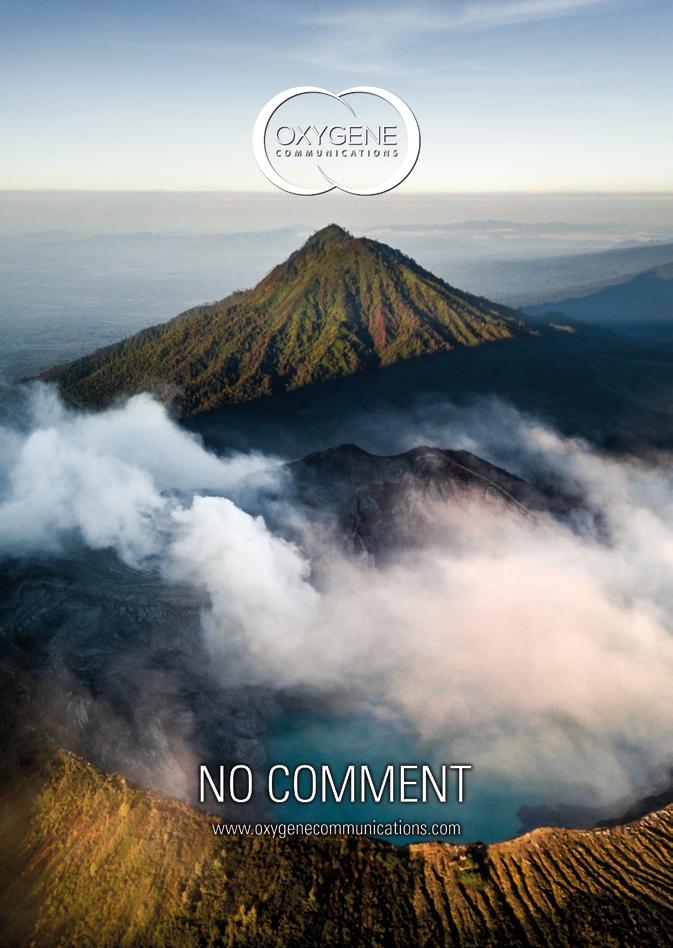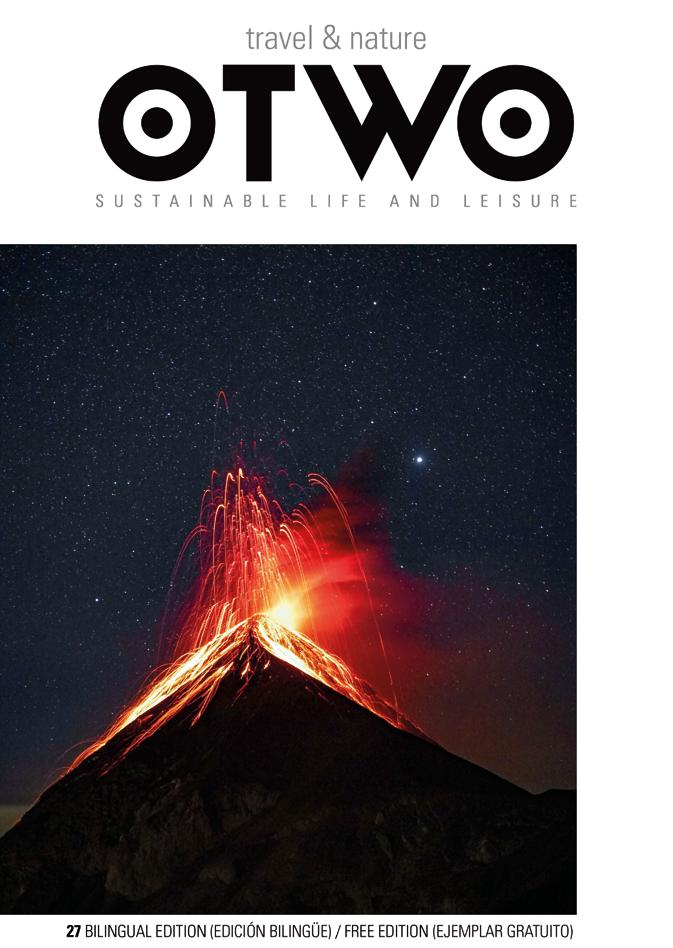


CARPENTRY • MASONRY • GENERAL DECORATION • PLUMBING • ELECTRIC • KITCHENS • BATHROOMS • BEDROOMS
PROFESSIONAL STANDARDS AND BEST PRICES GUARANTEED. REGISTER NOW FOR A NO OBLIGATION ESTIMATE AND RECEIVE A £50 DISCOUNT ON WORKS. WE WILL CALL YOU WHEN LOCK DOWN IS LIFTED : BE THE FIRST AND AVOID THE RUSH!
Admin offices: Suite D 122 Irish Town Call 54083022 or email minorworks@evgib.com
“You’re just nothing when you’re near a volcano. Most volcanologists die in bed¨
Katia y Maurice Kraft
«La mayoría de los vulcanólogos mueren en la cama»
Katia y Maurice Kraft

PHOTOGRAPHY: PEXELS.COM

“If you gaze into the abyss, the abyss gazes also into you¨
Friedrich Nietzsche
«Si miras durante largo tiempo a un abismo, el abismo también mira dentro de tí»
Friedrich Nietzsche

“One day, in retrospect, the years of struggle will strike you as the most beautiful¨ Sigmund Freud
«Un buen día, echando la vista atrás, se dará usted cuenta de que estos años de lucha han sido los más hermosos de su vida»
Sigmund Freud
SUBSCRIBE

This volume was published in October 2021 by
Oxygene Ltd.Business Centre.
GX11 1AA, Gibraltar Tel. +00350 22500799
www.oxygenecommunications.com
© Publishing:
Oxygene Ltd.
Vanessa Byrne
Managing & Commercial Director
Juanjo Trujillo
Creative Director & Chief Designer
Sarah Birch
Columnist
Photographer:
Mi Moama, María Molina, Anthony Pitaluga, Tom Fisk, Hans Hillewaert, Wikipedia, Pexels, Luis González, In2Adventures, Ebikes Gibraltar..
Cover photo: Clive Kim.
Back Cover photo: Nick Wehrli.
El
Printing:
Santa Teresa Industrias Graficas SA
All rights reserved. No part of this publication may be reproduced, stored in a retrieval system or transmitted in any form or by any means, electronic, mechanical, photocopying, recording or otherwise, without the prior permission in writing from the publishers. All rights reserved.
ISSN 2633-7401
www.otwomag.com


Eco Passion: 10 simple steps to a more sustainable lifestyle.
Eco Passion: 10 sencillos pasos para un estilo de vida más sostenible.
Historic Rosia Bay
200kg
200
Histórica Bahía Rosia Active
The



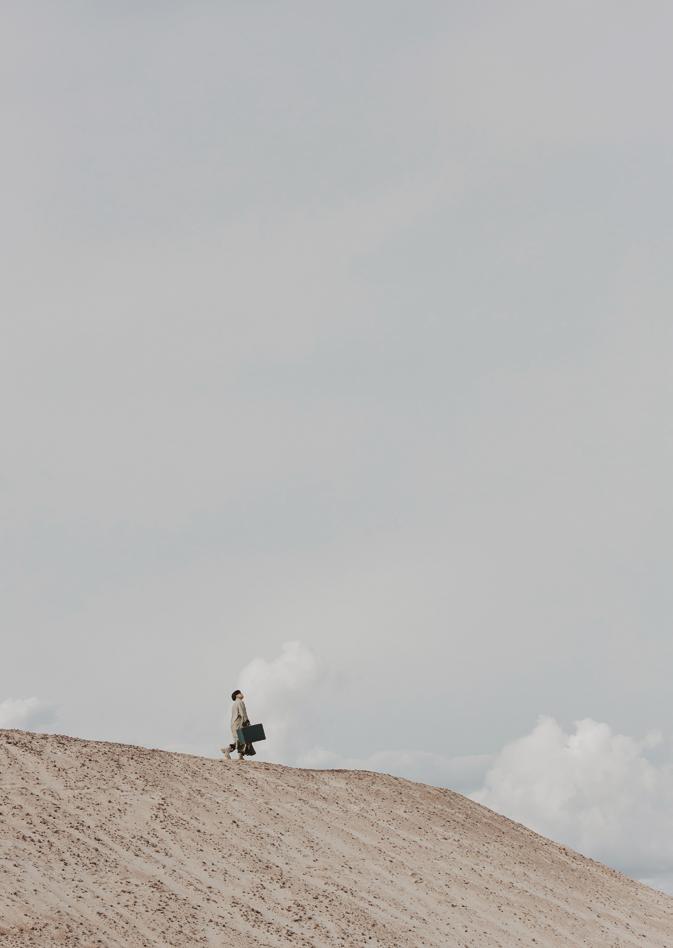
2021 001
Shorts
cities / Ciudades activas
crisis
here
climate
is
La crisis climática está aquí
collected for
Coastal
of rubbish
International
Clean-Up Day
kg
recogidos en
de
Photovoltaic self-consumption is our best asset to rebuild our economy and a sustainable world.
de basura
el Día Internacional de la Limpieza
Costas COAMBA:
autoconsumo fotovoltaico
para
Gibraltar-Bordeaux Experiences Quick Guide The adventures of Sai Nosha´s Corner The voice of our future Collection “The flower of the month”. Colección “La flor del mes”. Editorial 10 14 16 24 28 36 40 52 Nature´s Way Narrowing the Strait Clubhouse Minds
es nuestra mejor baza
re construir nuestra economía y un mundo sostenible
A simple step, but so important. Plus it’s free.
sencillo,
Suscríbete. Un gesto
pero tan importante. Además, es gratis.
60 78 92 100 102 106 108 110 112 117
Oxygene
Ltd. OTWO Issue 27
19 George´s Lane.
OTWO 27
A note from the editor
Vanessa Byrne / Managing Director
Wow September has been a busy month with so many important events creating focus on such an important dilemma. Car free day, Zero-Emissions Day, Clean up the World Day, Green Consumer Day and so many others.
This year the local annual Clean Up the World event saw about 500 volunteers work across 26 sites, clearing debris and picking up litter. Organizations throughout our community worked together to tackle shorelines, revetments, underwater sites, open water and various green habitats throughout our Nature Reserve. They removed plastics and other non-biodegradable waste. This annual event has driven the need for clean up the world in a very large scale and is celebrated worldwide.
Green Consumer Day is observed globally on September 28th. This year The Nautilus Project set up an awareness stall at the entrance of the ICC. The main goal for Green Consumer Day is to promote the many sustainable products readily available and perhaps plant the seed in our green living journey. TNP are always there to help encourage Gibraltar to reduce its plastic and carbon footprint. A true inspiration.
World Carfree Day/ Emissions Free Day takes place yearly on 22nd September. Celebrated since 1970, this is annual celebration of cities and public life, free from the noise, stress and pollution of cars. Motor vehicles emit carbon dioxide and other greenhouse gases, which are major causes of global warming. Events like these bring awareness of what we can all do to help. On this day countries worldwide encourage everyone to give up their cars for a day and consider alternative ways of travelling like walking and cycling to school/ work more often.
In London, Car Free Day celebrations provide a unique chance to “reimagine” the city, by walking or cycling through 20km (12 miles) within closed roads in central London, with live performances and other activities along the way.
Since 2008, Car Free Vancouver Society has hosted Car Free Days along many roads to nurture and grow the car free culture by blocking off major roads. People are allowed the chance to experience what cities could be like with more space for pedestrians, not cars.
Every Sunday in Jakarta from 6:00 to 11:00am many streets are closed to all private cars. Allowing locals and visitors to enjoy the streets for jogging, running, cycling or just to stroll at their leisure while enjoying the street food, circus-like displays and occasional public events. Originally started as a government initiative to help reduce pollution, Car Free Day has become a well-loved Jakarta tradition.
It is so motivating to see so many countries embracing these changes and promoting clean sustainable living, I only hope Gibraltar will follow suit soon. We will certainly be pushing.
An article I must highlight in this month’s edition is Active Cities from Jose Antonio Duarte. This embodies exactly what Car Free, and Zero Emissions days are trying to promote. Healthy lifestyles. And this can only be achieved if we change our ways and move away from the car. A real eye opener with many ideas from different areas worldwide. At the end of the day we are advocating that we all look after ourselves better - that’s all – simple as that.
This month also saw a televised show by Global Citizen Live – Music Festival for the planet. An incredible festival from so many artists all around the world bringing focus on our plant’s needs. This was done in preparation for COP 26. It is so encouraging to see huge names like Ed Sheeran, Shawn Mendez, Billie Eilish, Hugh jackman, Black Eyed Peas and so many more huge stars highlight the importance and need for change and action!
We are forever grateful for our contributors, supporters, followers, and subscribers for your continued support. Peace and Love to all always

10
OTWO 27 / OCTOBER 2021
ILLUSTRATION: JUANJO TRUJILLO
Vaya, septiembre ha sido un mes muy ajetreado, con tantos eventos imprescindibles y que crean un dilema tan importante. El Día sin Coches, el Día de las Cero Emisiones, el Día de la Limpieza del Mundo, el Día del Consumidor Verde y tantos otros.
Este año, el evento anual local de «A Limpiar el Mundo» contó con la participación de unos 500 voluntarios que trabajaron en 26 lugares, limpiando los escombros y recogiendo la basura. Organizaciones de toda nuestra comunidad trabajaron juntas para abordar las costas, los revestimientos, los lugares subacuáticos, las aguas abiertas y varios hábitats verdes en toda nuestra Reserva Natural. Retiraron plásticos y otros residuos no biodegradables. Este evento anual ha impulsado la necesidad de limpiar el mundo a gran escala y se celebra en todo el mundo.
El Día del Consumidor Verde se celebra globalmente el 28 de septiembre. Este año, el Proyecto Nautilus instaló un puesto de concienciación en la entrada del ICC. El objetivo principal del Día del Consumidor Verde es promover los numerosos productos sostenibles disponibles y quizás plantar la semilla en nuestro viaje hacia la vida verde. TNP siempre está ahí para ayudar a animar a Gibraltar a reducir su huella de plástico y de carbono. Una verdadera inspiración.
El Día Mundial sin Coches/Día sin Emisiones tiene lugar cada año el 22 de septiembre. Celebrado desde 1970, se trata de una celebración anual de las ciudades y la vida pública, libre del ruido,
Una nota de la editora
Vanessa Byrne / Directora General
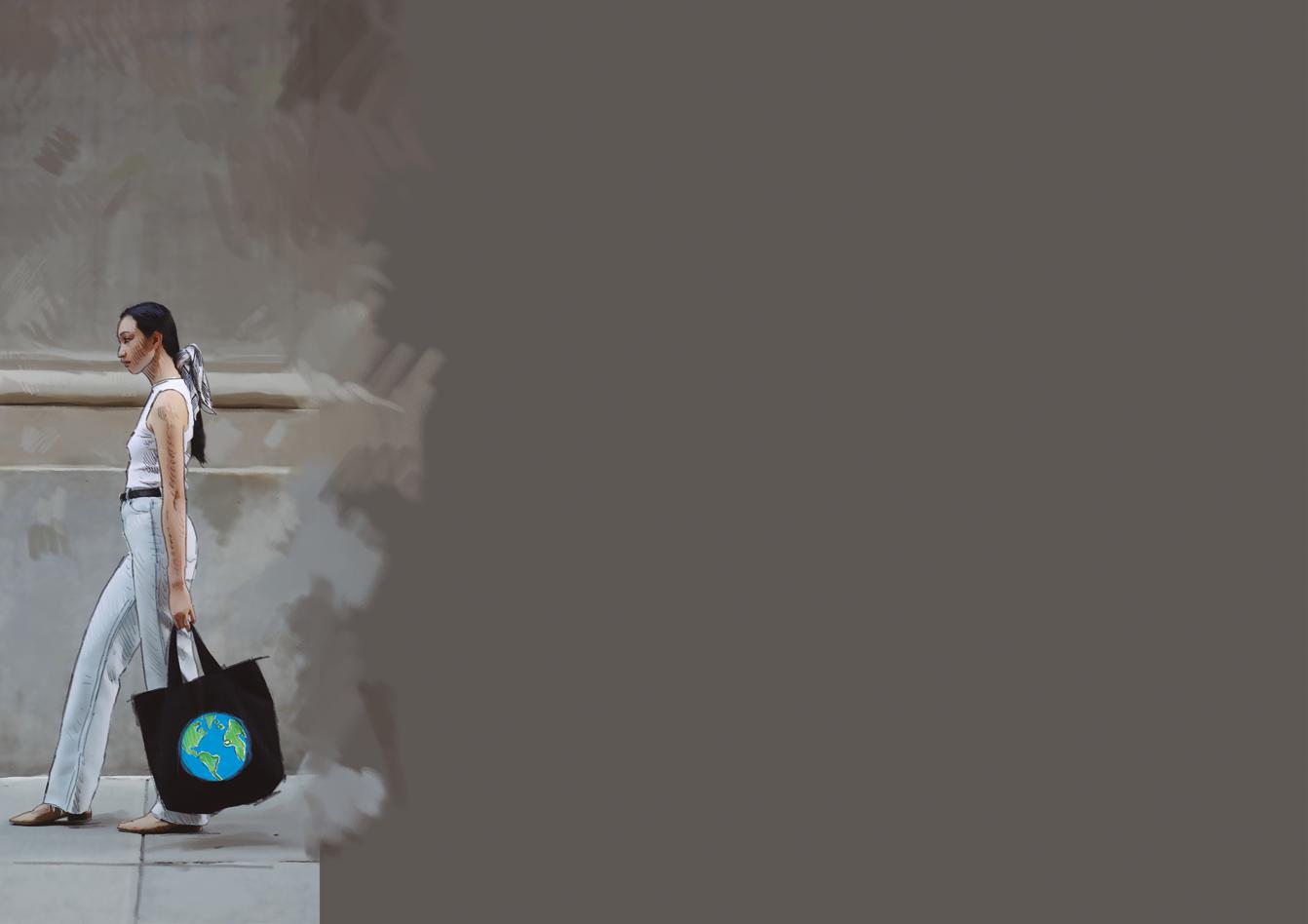
el estrés y la contaminación de los coches. Los vehículos de motor emiten dióxido de carbono y otros gases de efecto invernadero, que son las principales causas del calentamiento global. Actos como éste conciencian sobre lo que todos podemos hacer para ayudar. En este día, países de todo el mundo animan a todo el mundo a dejar el coche por un día y a considerar formas alternativas de viajar, como ir a pie o en bicicleta al colegio o al trabajo más a menudo. En Londres, las celebraciones del Día sin Coches ofrecen una oportunidad única de “reimaginar” la ciudad, recorriendo a pie o en bicicleta 20 km de carreteras cerradas en el centro de Londres, con actuaciones en directo y otras actividades a lo largo del camino.
Desde 2008, la Sociedad Vancouver Sin Coches ha organizado Días Sin Coches en muchas carreteras para fomentar y hacer crecer la cultura sin coches, bloqueando las carreteras principales. La gente tiene la oportunidad de experimentar cómo podrían ser las ciudades con más espacio para los peatones, no para los coches.
Todos los domingos en Yakarta, desde las 6:00 hasta las 11:00, muchas calles se cierran a todos los coches privados. Esto permite a los habitantes y a los visitantes disfrutar de las calles para hacer footing, correr, ir en bicicleta o simplemente pasear a su aire mientras disfrutan de la comida callejera, los espectáculos circenses y los eventos públicos ocasionales. Inicia-
do originalmente como una iniciativa del gobierno para ayudar a reducir la contaminación, el Día sin Coches se ha convertido en una tradición muy querida en Yakarta.
Es muy motivador ver que tantos países adoptan estos cambios y promueven una vida limpia y sostenible; sólo espero que Gibraltar siga su ejemplo pronto. Sin duda, estaremos presionando.
Un artículo que debo destacar en la edición de este mes es Ciudades Activas de José Antonio Duarte. Encarna exactamente lo que los días sin coches y con cero emisiones intentan promover. Estilos de vida saludables. Y esto sólo se puede conseguir si cambiamos nuestras costumbres y nos alejamos del coche. Una verdadera revelación con muchas ideas de diferentes áreas en todo el mundo. Al fin y al cabo, abogamos por que todos nos cuidemos mejor, eso es todo, así de simple. Este mes también hemos visto un espectáculo televisado de Global Citizen Live - Festival de música para el planeta. Un festival increíble de muchos artistas de todo el mundo que se centró en las necesidades de nuestra planta. Esto se hizo como preparación para la COP 26. Es muy alentador ver a grandes nombres como Ed Sheeran, Shawn Mendez, Billie Eilish, Hugh jackman, Black Eyed Peas y tantas otras grandes estrellas destacar la importancia y la necesidad de cambio y acción. Estamos eternamente agradecidos a nuestros colaboradores, simpatizantes, seguidores y suscriptores por su continuo apoyo. Paz y amor para todos siempre.
13 12
ILLUSTRATION: JUANJO TRUJILLO
OTWO 27 / OCTOBER 2021 OTWO 27 / OCTOBER 2021


Kleinia neriifolia
Planta de la vela canaria
OCTOBER/ OCTUBBRE
Collection
“The flower of the month”
CanaryCandleIslandsPlant
Islands can evolve spectacular floras, often with large or ‘giant’ versions of plants that grow on mainlands. The islands of Macaronesia, which include the Canaries and Madeira, are an example of this. The Gibraltar Botanic Gardens hold an important collection of succulent plants from around the world. The closest areas to Gibraltar with formations of succulents are southwest Morocco and the Canary Islands. The Canaries have a rich and varied succulent flora, with many of the species found nowhere else on earth. Some of these are much larger counterparts of plants that grow in Morocco. One such example is the Canary Islands Candle Plant, which is popular in cultivation. Although it forms very large shrubs, this plant is in fact a member of the daisy family (Asteraceae). Although we associate the word daisy with small flowering plants, this is one of the most diverse families of plants in both species and adaptations; daisy species range from small, herbaceous annuals to trees. The Canary Islands Candle Plant has clusters of small flowers that can be hard to notice. Rather, the attractiveness of the plant lies in its impressive size and structure, as well as being a water-wise option for the Mediterranean garden.
Las islas pueden desarrollar floras espectaculares, a menudo con versiones grandes o «gigantes» de plantas que crecen en tierra firme. Las islas de la Macaronesia, que incluyen las Canarias y Madeira, son un ejemplo de ello. El Jardín Botánico de Gibraltar alberga una importante colección de plantas suculentas de todo el mundo. Las zonas más cercanas a Gibraltar con formaciones de suculentas son el suroeste de Marruecos y las Islas Canarias. Las Canarias poseen una rica y variada flora suculenta, con muchas de las especies que no se encuentran en ningún otro lugar del planeta. Algunas de ellas son homólogas mucho más grandes de las plantas que crecen en Marruecos. Un ejemplo es la planta de las velas canarias, muy popular en los cultivos. Aunque forma arbustos muy grandes, esta planta es en realidad un miembro de la familia de las margaritas (Asteraceae). Aunque asociamos la palabra margarita con pequeñas plantas con flor, ésta es una de las familias de plantas más diversas tanto en especies como en adaptaciones; las especies de margaritas van desde pequeñas herbáceas anuales hasta árboles. La planta de las velas canarias tiene racimos de pequeñas flores que pueden ser difíciles de notar. Más bien, el atractivo de la planta reside en su impresionante tamaño y estructura, además de ser una opción de ahorro de agua para el jardín mediterráneo.
14
Dr Keith Bensusan Director
Gibraltar Botanic Gardens, The Alameda.
15
OTWO 27 / OCTOBER 2021 OTWO 27 / OCTOBER 2021
Photographs: Keith Bensusan

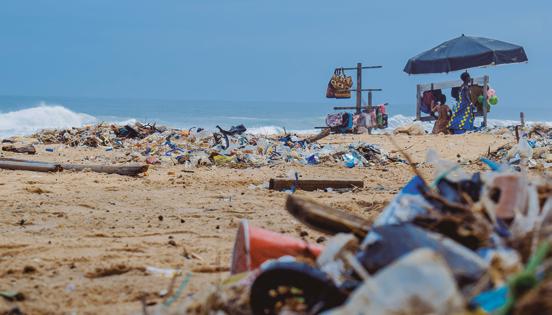
The 17th annual Clean Up the World event took place in mid-September, with an incredible 500 volunteers signing up this year to help clean up Gibraltar.
Local businesses, government departments, NGOs, the Gibraltar Regiment and school students of all ages tackled 26 sites, including Rosia and Camp Bay, various locations across the Upper Rock, underwater sites, revetments, shorelines and other green spaces.
The volunteers worked together to remove plastic litter and non-biodegradable waste from our natural spaces, filling several truckloads by the end of the day.
Ahead of the clean-up, the event organisers, The Environmental Safety Group said: “We are thankful for the overwhelming support and enthusiasm shown in response to the call out for volunteers and believe our environment will once again benefit from this great community effort. We also thank the Department of the Environment and Britannia for their assistance and support.”
“The knock-on effects from the clean ups last far beyond the weekend action where teamwork, networking across sectors of our society, and testing our cleaning and maintenance programmes positively contributes to improving how we behave in our natural environment and importantly how we must look after it”.
Following the event ESG once again thanked everyone that took part and said: “Our volunteers displayed great civic pride and care for our beautiful environment and that is priceless.” Commenting on the day itself, ESG went on to say that there were “many positive stories, some frustrations over litter found, and lessons learnt as per every year”.
ESG will release a more detailed account of the actions taken on the day and the campaigns current aims soon.
Limpiar el mundo 2021.
El 17º evento anual de A Limpiar el Mundo tuvo lugar a mediados de septiembre, con la increíble cifra de 500 voluntarios inscritos este año para ayudar a limpiar Gibraltar.
Empresas locales, departamentos gubernamentales, ONG, el Regimiento de Gibraltar y alumnos de escuelas de todas las edades abordaron 26 lugares, entre ellos Rosia y Camp Bay, varios lugares de la parte superior del Peñón, lugares submarinos, revestimientos, costas y otros espacios verdes.
Los voluntarios trabajaron juntos para eliminar la basura de plástico y los residuos no biodegradables de nuestros espacios naturales, llenando varios camiones al final del día.
Antes de la limpieza, los organizadores del even-
to, el Grupo de Seguridad Medioambiental, dijeron: “Estamos agradecidos por el abrumador apoyo y entusiasmo mostrados en respuesta a la convocatoria de voluntarios y creemos que nuestro medio ambiente se beneficiará una vez más de este gran esfuerzo comunitario. También agradecemos al Departamento de Medio Ambiente y a Britannia su ayuda y apoyo”.
“Las repercusiones de las limpiezas duran mucho más allá de la acción del fin de semana, en la que el trabajo en equipo, la creación de redes entre sectores de nuestra sociedad y la puesta a prueba de nuestros programas de limpieza y mantenimiento contribuyen positivamente a mejorar la forma en que nos comportamos en nuestro entorno natural y, lo que es más importante, cómo debemos cuidarlo”.
Tras el evento, la ESG volvió a dar las gracias a todos los que participaron y dijo “Nuestros voluntarios mostraron un gran orgullo cívico y cuidado por nuestro bello entorno y eso no tiene precio”. Al comentar la jornada en sí, la ESG continuó diciendo que hubo “muchas historias positivas, algunas frustraciones por la basura encontrada y lecciones aprendidas como cada año”.

La ESG publicará próximamente un informe más detallado sobre las acciones realizadas en la jornada y los objetivos actuales de la campaña.
LOCAL NGOS STRONGLY OPPOSE THE PROPOSED ROSIA BAY DEVELOPMENT
Proposed plans to build up to 75 residential properties as well as commercial spaces and a car park in the historic Rosia Bay has been met with fierce criticism from The Gibraltar Ornithological and Natural History Society, the Heritage Trust and the Environmental Safety Group.
In a joint statement, the three organisations said that they are “vehemently opposed to a development that is being proposed at Rosia Bay”

“The site is hugely important to Gibraltar as a community, leisure, heritage and ecological area, not to mention its international significance to European naval history”.
“Privatisation of any part of the Bay is unacceptable. Marring of the heritage value of the structure at or around the site is unacceptable. Our view is that any development that includes a residential element of significant massing at the site should not be entertained from the outset, and we cannot comprehend why a project that includes residential development is being considered”.
The Nautilus Project also oppose the development and have started an online petition to safeguard the bay which has so far amassed over 5000 signatures.
TNP said: “Rosia Bay is Gibraltar’s only natural harbour and a site of unique historic and natural value. As such, we the undersigned declare our support for the preservation and restoration of Rosia Bay as a natural, historical and public treasure. We believe that the current private proposal needs to be denied and that any development of Rosia should be a public matter along the lines of a public leisure open space with conservation, restoration, education and research as priorities, with only limited commercial interest and no residential development”.
The site is no doubt in need of refurbishment, with much of the current concrete jetty and platforms in a terrible state of disrepair, however, as well as its historical significance, the Bay is home to various endangered species that seek refuge within its calm waters. Constructing a large private development would no doubt have a terrible impact on all the wildlife that has found refuge in the Bay.
Please help safeguard Rosia Bay by signing the petition here
Las ONG locales se oponen firmemente al proyecto de desarrollo de Rosia Bay
Los planes propuestos para construir hasta 75 viviendas, así como espacios comerciales y un aparcamiento en la histórica bahía de Rosia, se han topado con las feroces críticas de la Sociedad de Ornitología e Historia Natural de Gibraltar, el Heritage Trust y el Grupo de Seguridad Medioambiental.
En una declaración conjunta, las tres organizaciones dijeron que se oponen «vehementemente al desarrollo que se propone en Rosia Bay».
16 OTWO 27 / OCTOBER 2021 OTWO 27 / OCTOBER 2021 17
CLEAN UP THE WORLD 2021
«El lugar es enormemente importante para Gibraltar como zona comunitaria, de ocio, patrimonial y ecológica, por no mencionar su importancia internacional para la historia naval europea».
«La privatización de cualquier parte de la bahía es inaceptable. Es inaceptable que se estropee el valor patrimonial de la estructura en el lugar o en sus alrededores. Nuestra opinión es que cualquier desarrollo que incluya un elemento residencial de masa significativa en el sitio no debe ser considerado desde el principio, y no podemos comprender por qué se está considerando un proyecto que incluye el desarrollo residencial».
El Proyecto Nautilus también se opone al proyecto y ha iniciado una petición en línea para salvaguardar la bahía, que hasta ahora ha reunido más de 5.000 firmas. TNP dijo: «La bahía de Rosia es el único puerto natural de Gibraltar y un lugar de valor histórico y natural único. Como tal, los abajo firmantes declaramos nuestro apoyo a la preservación y restauración de la Bahía de Rosia como un tesoro natural, histórico y público. Creemos que la actual propuesta privada debe ser rechazada y que cualquier desarrollo de Rosia debe ser un asunto público en la línea de un espacio abierto de ocio público con la conservación, la restauración, la educación y la investigación como prioridades, con sólo un interés comercial limitado y sin desarrollo residencial». No cabe duda de que el lugar necesita una reforma, ya que gran parte del actual muelle de hormigón y de las plataformas se encuentran en un terrible estado de deterioro; sin embargo, además de su importancia histórica, la bahía alberga varias especies en peligro de extinción que buscan refugio en sus tranquilas aguas. La construcción de una gran urbanización privada tendría sin duda un terrible impacto en toda la fauna que ha encontrado refugio en la bahía. Por favor, ayude a salvaguardar la Bahía de Rosia firmando la petición aquí.

MEDITERRANEAN COUNTRIES SIGN CLIMATE DEAL FOLLOWING FIERCE SUMMER OF WILDFIRES
In the wake of one of the worst wildfire seasons in Europe’s history, leaders across the Mediterranean have pledged to unite to tackle the serious

threats posed by extreme weather events caused by climate change.
At a joint summit, Spain, Italy, France, Portugal, Greece, Malta, Slovenia, Cyprus and Croatia all signed the Athens Declaration, pledging to expand cooperation against the climate crisis.
In a joint statement after the talks, the leaders voiced their: “strong conviction that urgent and ambitious global action [is needed] at national, regional and local levels” to fight climate change.
The Mediterranean has suffered a record summer for extreme wildfires and heatwaves and will be the region most affected by climate change in Europe. The first of its kind agreement aims to create “a safe, secure, prosperous, fair and sustainable future” and to reaffirm their commitment to reach the goals set by the Paris Climate Accord.
The Athens Declaration centres its efforts around biodiversity, forest management, the marine environment, civil protection, prevention and preparedness. It also calls for closer integration of climate-change policies across Europe and further cooperation within the EU’s transnational disaster response mechanism.
Los países mediterráneos firman un acuerdo sobre el clima tras un feroz verano de incendios forestales
En una cumbre conjunta, España, Italia, Francia, Portugal, Grecia, Malta, Eslovenia, Chipre y Croacia firmaron la Declaración de Atenas, comprometiéndose a ampliar la cooperación contra la crisis climática.
En una declaración conjunta tras las conversaciones, los líderes expresaron su “la firme convicción
de que es necesario tomar medidas urgentes y ambiciosas a nivel nacional, regional y local” para luchar contra el cambio climático.
El Mediterráneo ha sufrido un verano récord de incendios forestales y olas de calor extremas y será la región más afectada por el cambio climático en Europa. El primer acuerdo de este tipo pretende crear “un futuro seguro, próspero, justo y sostenible” y reafirmar su compromiso de alcanzar los objetivos fijados por el Acuerdo Climático de París.
La Declaración de Atenas centra sus esfuerzos en la biodiversidad, la gestión de los bosques, el medio ambiente marino, la protección civil, la prevención y la preparación. También pide una mayor integración de las políticas sobre el cambio climático en toda Europa y una mayor cooperación en el marco del mecanismo transnacional de respuesta a las catástrofes de la UE.

WHO RELEASE NEW AIR QUALITY GUIDELINES
The World Health Organisation has cut maximum air pollution level guidelines and warns that pollutant levels are more dangerous than previous estimates.
The new guidelines urge 194 members states to drastically reduce emissions to ensure citizens health and tackle climate change.
Most air pollution in populated areas comes from vehicle exhausts and gas central heating and also from chemical pollutants such as paint fumes and cleaning products, car tyres and brakes.
Poor air quality conditions are linked to heart disease, strokes and lung conditions such as asthma and reduced lung growth in children.
The maximum exposure to hazardous PM2.5 particulates (produced by burning fuels for power and vehicles) has now halved, and PM10s (produced by mould, construction dust and soot) reduced by 25%. Nitrogen dioxide (NO2) levels, which are mainly generated by diesel engines, are now 75% lower.
Low- and middle-income countries suffer the most from poor air quality levels. “Almost 80% of deaths related to PM2.5 could be avoided in the world if the current air pollution levels were reduced to those proposed in the updated guideline” according to the report.
The WHO says: “Air pollution kills at least 7 million people a year” and that “91% of the world’s population live in places where air quality exceeds WHO guideline limits”.
La OMS publica nuevas directrices sobre la calidad del aire
La Organización Mundial de la Salud ha recortado las directrices sobre los niveles máximos de contaminación atmosférica y advierte de que los niveles de contaminantes son más peligrosos que los estimados anteriormente.
Las nuevas directrices instan a los 194 Estados miembros a reducir drásticamente las emisiones para garantizar la salud de los ciudadanos y hacer frente al cambio climático.
La mayor parte de la contaminación atmosférica en las zonas pobladas procede de los tubos de escape de los vehículos y de las calefacciones centrales de gas, así como de contaminantes químicos como los vapores de la pintura y los productos de limpieza, los neumáticos y los frenos de los coches.
Las condiciones de mala calidad del aire están re-

19 18
OTWO 27 / OCTOBER 2021 OTWO 27 / OCTOBER 2021

lacionadas con enfermedades cardíacas, accidentes cerebrovasculares y afecciones pulmonares como el asma y la reducción del crecimiento pulmonar en los niños.
La exposición máxima a las peligrosas partículas PM2,5 (producidas por la quema de combustibles para la energía y los vehículos) se ha reducido a la mitad, y las PM10 (producidas por el moho, el polvo de la construcción y el hollín) se han reducido en un 25%. Los niveles de dióxido de nitrógeno (NO2), generados principalmente por los motores diesel, son ahora un 75% más bajos.
Los países de ingresos bajos y medios son los que más sufren los malos niveles de calidad del aire. “Casi el 80% de las muertes relacionadas con las PM2,5 podrían evitarse en el mundo si los niveles actuales de contaminación atmosférica se redujeran a los propuestos en la directriz actualizada”, según el informe.
La OMS afirma que “la contaminación atmosférica mata al menos a 7 millones de personas al año” y que “el 91% de la población mundial vive en lugares donde la calidad del aire supera los límites establecidos por la OMS”.
“CALAMARKET” III ARTS & CRAFTS MARKET
The participating artist and organizer of Calamarket Gavilana tells us: “We have immense gratitude for the Chiringuito Dblanco in Alcaidesa and its entire wonderful staff, for giving us their facilities on the beach, making possible a continuous line of cultural events”.
On Sunday September 12th, we will celebrate our ‘3rd edition’, once again achieving that creative synergy between different disciplines. Art, global environment care and solidarity have been the forces that we have joined in previous editions, but for this occasion, together with the new cast of artists, we have the honor of collaborating with “La Pecera”, a very special children’s bookstore that has been spreading magic to young readers in La Linea de la Concepcion for 3 years.
Calamarket is an event that promotes art, culture and environmental care, we make and step forward continues adding and improving ourselves in each edition. An event with a spirit of solidarity since the
special guest is always a charitable association that defends a just cause, with the intention of coming together to help raise awareness about difficult realities that concern us all.
“ADEM - CG” The Multiple Sclerosis Association in Campo de Gibraltar will accompany us with a beautiful stand of their crafts and merchandising, to raise funds for their tireless fight for a disease that affects 47,000 people in Spain, 600,000 people in Europe and more than 2,000,000 in the world.
We want to support them, sensitize the public opinion, raise awareness, but we also want to have fun together and enjoy an event created with great care, and what better time than having lunch as a big family the famous paellas of “Grupo Paladares” in the best company and with the attentive help of our favorite decorator ‘Chico Zambrana’.
“Calamarket” III Mercado de Arte Multidisciplinar.
La artista participante y organizadora de Calamarket Gavilana nos comenta: «Ya es un cariño el que le tenemos al Chiringuito Dblanco en Alcaidesa y a todo su maravilloso personal, por cedernos sus instalaciones a pie de playa, haciendo posible que Calamarket se convierta en una línea continuada de Mercados de Arte».
El domingo 12 de septiembre celebraremos nuestra ‘3ª edición’, una vez más logrando esa sinergia creativa entre diferentes ámbitos. Arte, medioambiente y solidaridad han sido las fuerzas que hemos

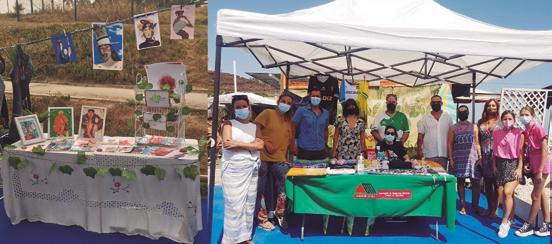
aunado en las anteriores ediciones, pero para ésta ocasión, junto al nuevo elenco de artistas, tenemos el honor de colaborar con “La Pecera” una librería infantil-juvenil muy especial que lleva tres años en La Línea dotando de magia a sus lectores, y que pronto se mudarán a un lugar más grande en la misma calle, para continuar con sus ‘Cuentacuentos’ y demás actividades literarias.
Calamarket es un Mercadillo que grita arte, cultura, medioambiente, y estamos demostrando que somos un todo terreno sumando, pero… ¿dónde está su alma? Su Alma es Solidaria porque el invitado especial siempre es una asociación que defiende una buena causa, con la iniciativa de unirnos para contribuir a concienciar sobre realidades que nos incumben a todos.
“ADEM - CG” La Asociación de Esclerosis Múltiple del Campo de Gibraltar nos acompañará con un precioso stand de sus manualidades y merchandising, para recaudar fondos para su infinita lucha de una enfermedad que afecta a 47.000 personas en España, 600.000 personas en Europa y más de 2.000.000 en el mundo.
Queremos apoyarles, sensibilizar a la opinión pública, concienciar, pero también queremos divertirnos todos juntos y brindar por un evento creado con mucho cariño, y qué mejor momento que almorzando como en una gran familia las famosas paellas de “Grupo Paladares” en el mejor de los ambientes, y con la atenta ayuda de nuestro decorador favorito ‘Chico Zambrana’.
GRAPHINLOVE
“Graphinlove is a state of enunciation”. This is how decisive I could read in the video presentation of this amazing and didactic workshop held last Sunday at the Castillo Fortaleza de Castellar. The Casa de Cultura El Salvador was packed from early in the morning to attend an unusual day presented by Juanjo Trujillo, creative director of OTWO Magazine (www.otwomag.com)
After a brief introduction where he analyzed the increasingly widespread bad practices of graphic communications in the publishing sector, Juanjo Trujillo showed the five most common scenarios of this visual deterioration. The names of these devastated areas were already a declaration of intent: Pandemic JPG, images in danger of extinction; typecide, everything you should not do with text composition; in Daltonismo & Cia he sensitized us to generate content that is accessible to people who suffer from this anomaly; How to remedy ugly maps with useful, simple tips and perhaps one of the most interesting; Datacombe - how to prevent our data graphics frombeing confusing. He introduced us to a new grammer that is the visualization of data.. Two and a half hours that flew by due to the mastery of the presentation and the interesting and entertaining content. It is also worth mentioning the magnificent technical team of the Audiovisión staff.
If you visit the web: www.graphinlove.com in the menu “abacería” you will be able to download all

21 20
OTWO 27 / OCTOBER 2021 OTWO 27 / OCTOBER 2021
the tutorials with the course contents free of charge. This workshop is a preview of the one that will be held next spring in Gibraltar as part of the Green Week Gibraltar activities. Thanks to the researcher Luis Garcia Bravo, a personal friend of Juanjo, along with the Mayor Adrian Vaca and Tamara Trujillo Second Deputy Mayor and Delegate of Education and Culture for giving us this amazing workshop.. We will expand on this information in our next issue.
Graphinlove
«Graphinlove es un estado de enunciación», así de determinante pude leer en el vídeo presentación de este asombroso y didáctico taller celebrado el pasado domingo en el Castillo Fortaleza de Castellar. La Casa de Cultura El Salvador estaba repleta de público desde tempranas horas de la mañana para asistir a una inusual jornada impartida por Juanjo Trujillo, director creativo de OTWO Magazine (www. otwomag.com)
Tras una breve introducción donde analizó las cada vez más extendidas malas prácticas de las comunicaciones gráficas en el sector de la divulgación, Juanjo Trujillo mostró los cinco escenarios más comunes de este deterioro visual. Los nombres de estas áreas devastadas ya eran toda una declaración de intenciones: Pandemia JPG, imágenes en peligro
de extinción; Tipocidio o todo lo que no debes hacer con la composición de textos; en Daltonismo & Cia nos sensibilizó a la hora de generar contenidos que sean accesible para las personas que padecen esta anomalía; Mis mapas son feos y como remediarlo con consejos útiles y sencillos y por último y quizá uno de los más interesante Datacombe o como evitar que nuestras gráficas de datos confundan más que aclaren, introduciéndonos en esta nueva gramática que es la visualización de los datos. Dos horas y medias que pasaron volando por la maestría de la presentación y de lo interesante y ameno del contenido. También cabe reseñar el magnífico equipo técnico del personal de Audiovisión. Si visitan la web: www.graphinlove.com en el menú «abacería» podrán descargarse sin costo alguno todos los tutoriales con los contenidos del curso. Este taller es un adelanto del que se celebrará la próxima primavera en Gibraltar entre las actividades de Green Week Gibraltar. Gracias a que el investigador Luis García Bravo, amigo personal de Juanjo, junto con el alcalde Adrían Vaca y Tamara Trujillo Segunda Teniente de Alcalde y Delegada de Educación y Cultura han conseguido regalarnos este sorprendente taller.
En nuestro próximo número nos extenderemos más en esta información.

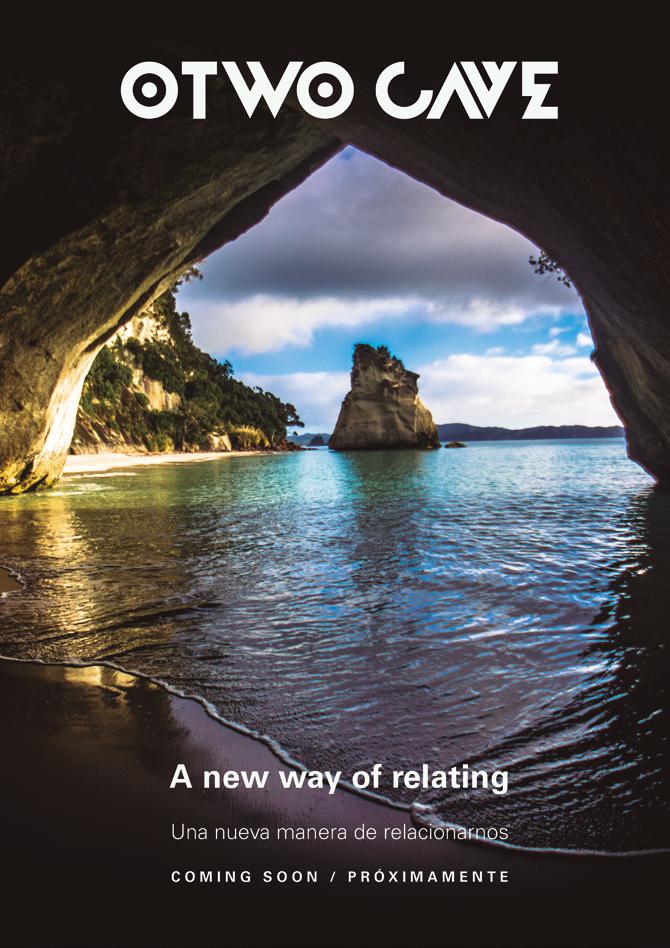
22 OTWO 27 / OCTOBER 2021





SWITCH DISPOSABLE WIPES FOR REUSABLES
Pása de las toallitas desechables a las reutilizables
Wipes such as baby wipes, bathroom cleaning wipes and make-up wipes are big business, but they are causing big problems for our environment.
When they are flushed they cause blockages and clog drains and sewer systems, as they don’t break down. Many contain plastics, which never break down entirely, but instead turn into microplastics which pose threats to marine life. In our regular beach cleans they are one of the top three items always found.
As a consumer, you have the power to say no to these single use items and return to more sustainable and traditional cleaning methods. Around the home you can use reusable cotton cloths to clean and for babies and delicate faces you can use reusable bamboo fabric discs. These can even be moistened and carried in a zip bag for a handy damp wipe when out and about.
There are lots of alternatives out there and it might take a few tries before you find the replacement that works for you, but think how you can reduce single use items like these which are difficult to dispose of. You’ll reduce your impact on the environment and save yourself money over the long term.
Las toallitas de bebé, de limpieza de baño y de maquillaje son un gran negocio, pero causan grandes problemas para nuestro medio ambiente. Cuando se tiran por el inodoro, obstruyen los desagües y las alcantarillas, ya que no se descomponen. Muchas contienen plásticos, que nunca se llegan a descomponer por completo, sino que en su lugar se convierten en microplásticos que suponen una gran amenaza a la vida marina. En nuestras habituales limpiezas de playa, los microplásticos son uno de los tres principales productos que encontramos siempre.
Como consumidor, tienes el poder de decir que no al uso de este tipo de productos de un solo uso y retomar métodos de limpieza tradicionales más sostenibles. En casa puedes utilizar paños de algodón reutilizables para limpiar y para los bebés y la piel delicada del rostro puedes emplear discos de tela de bambú reutilizables. Incluso se pueden humedecer y llevar en una bolsa con cremallera para usarlos como prácticas toallitas húmedas cuando estés de un lado para el otro.
Hay muchas alternativas y puede que te lleve unos cuantos intentos encontrar el sustituto que te funcione, pero piensa en cómo podrás reducir los productos de un solo uso que se degradan muy lentamente. Reducirás tu impacto medioambiental y ahorrarás dinero a largo plazo.

24
OTWO 27 / OCTOBER 2021 25 OTWO 27 / OCTOBER 2021


“Gibraltar’s rich heritage is one of its greatest assets and it is imperative that it is preserved and managed in a sustainable way to continue to benefit future generations”

The Gibraltar Heritage Trust
The Gibraltar Heritage Trust is an independent statutory body entrusted with the preservation of Gibraltar’s heritage. It aims to work in partnership with all like-minded bodies, both locally and internationally. The Trust is responsible to the people of Gibraltar for the preservation and enhancements of all aspects of Gibraltar’s heritage, which includes promotion culturally, educationally and in terms of tourism both for our local population and internationally. It works closely with the Government of Gibraltar and the private sector in fulfilling its aims. Operating on a not for profit basis all funding for Trust projects are raised through our annual membership drive, our commercial activities or through specific project targeted fundraising. All funds generated are applied to achieving the aims and objectives of the Trust.



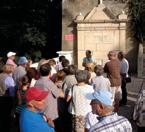
“The events that the Trust organises allow me and my partner to explore places that we simply would not have seen without the help and knowledge of the Trust”

The Trust has a number of statutory and strategic functions to:
1.- Safeguard and enhance the quality and condition of Gibraltar’s historic environment.
2.- Promote wider understanding, enjoyment and appreciation of Gibraltar’s historic environment.
3.- Enhance Gibraltar’s Sense of Place.
4.- Encourage relevant bodies to make Gibraltar’s historic areas better places to live, visit and to invest in.
5.- Work with others to amplify the impact of the wider initiatives to improve the city and make Gibraltar a better place to live, visit and invest in.
6.- Work towards the implementation and enforcement of new heritage legislation, policies and guidelines.
7.- Be open, responsive, transparent, effective and efficient in our work.
By investing in the Trust you are investing in Gibraltar’s past, its present and its future.
With your annual membership, you support Gibraltar and the work that the Trust does to protect and enhance it, however, your membership also entitles you to:
• Access to the Trust’s monthly programme of events, including trips and organised excursions.

• Access, by appointment, to the Trust’s reference library of books related to Gibraltar and its past. (The Trust is accepting donations of books on Gibraltar to add to this resource).
• Free entry to the Gibraltar Museum.
• Free entry to the Upper Rock Nature Reserve, St Michael’s Cave, Great Siege Tunnels, Military Heritage Centre, Tower of Homage, Ape’s Den, Windsor Suspension Bridge and WWII Tunnels.
• Annual report, our regular e-newsletter direct to your inbox, updates and information on what’s happening on the Gibraltar heritage scene.
• Discounts and deals from local businesses added throughout the year.
• Discounts on all Gibraltar Heritage Trust Publications in our shop.

Gibraltar Heritage Trust
The Main Guard
13 John Mackintosh Square PO Box 683, Gibraltar t. (+350) 200 42844 admin@gibraltarheritagetrust.org.gi www.gibraltarheritagetrust.org.gi
JOIN US NOW VIA OUR WEBSITE OR POP INTO OUR SHOP
Historic Rosia Bay
Histórica Bahía Rosia
Text : Lewis Stagnetto – The Nautilus Project
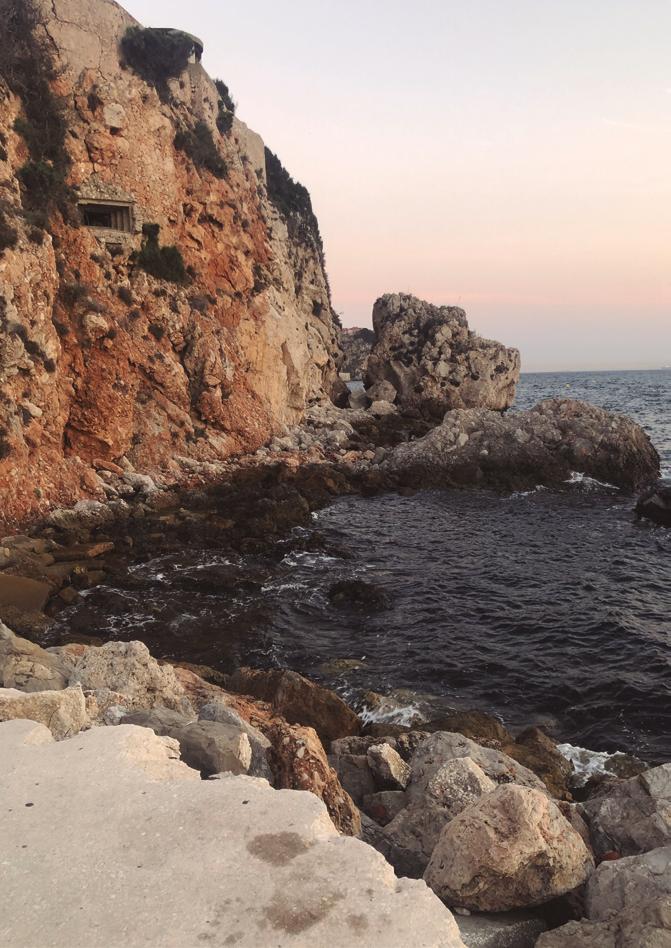
After the Battle of Trafalgar in 1805, Nelson’s body was brought into Rosia Bay aboard his ship HMS Victory. Local legend has it that he was brought inside a barrel of brandy, a claim that the Royal Navy vehemently deny, and was quickly shipped back to London for his state funeral.
If there is any truth to the story, then Rosia bay is already as crucially important to our local British heritage as a site like the Moorish Castle. Yet Rosia Bay seems to have fallen out of the local consciousness and, as a result, is in quite serious disrepair. The old jetty has been practically breached by recent winter storms and it is doubtful it will be able to endure many more batterings before it collapses altogether. Inside the bay one sees a similar pattern with the old dock wall pretty much ready to fall into the sea. The walkway to the tiny beach is not much better, and this lack of maintenance increases the risk of an accident happening any day. The site has been earmarked for more luxury developments and heritage to one side, it is important to highlight a few good reasons why environmentally it is very important that this doesn’t happen.
The giant limpet, Patella ferruginea, is a locally protected species which has disappeared from many regional coastlines. These animals are sequential hermaphrodites starting as males and transitioning to females after they reach around 3cm in length. The fact that sex ratios can be so easily skewed by harvesting the largest individuals, which inevitably are all females, has historically decimated the reproductive capacity of established populations. Fortunately, Gibraltar has a stable population and the anecdotal evidence seems to suggest that this species is doing well, locally at least.
Another species which is being researched intensively is the Yellow Star Coral, Astroides calycularis. The distribution of this jellyfish relative is now limited to the western Mediterranean and the Adriatic Sea. This species forms colonies of polyps through asexual reproduction meaning that all the individual polyps are clones of the original settler. Consequently, it follows that the whole colony is either male or female. During harsh winters the colonies can become dislodged from their position and once on the seabed have little hope of surviving. This can inevitably have huge consequences on local populations
Tras la batalla de Trafalgar en 1805, el cuerpo de Nelson fue llevado a la bahía de Rosia a bordo de su barco HMS Victory. La leyenda local dice que lo trajeron dentro de un barril de brandy, afirmación que la Royal Navy niega con vehemencia, y que fue rápidamente enviado de vuelta a Londres para su funeral de Estado.
Si la historia es cierta, la bahía de Rosia es ya tan importante para nuestro patrimonio local británico como un lugar como el Castillo de los Moros. Sin embargo, la bahía de Rosia parece haber quedado fuera de la conciencia local y, como resultado, se encuentra en un estado de deterioro bastante grave. El viejo embarcadero ha quedado prácticamente destrozado por los recientes temporales de invierno y es dudoso que pueda soportar muchos más golpes antes de derrumbarse del todo. Dentro de la bahía se ve un patrón similar, con el viejo muro del muelle prácticamente a punto de caer al mar. La pasarela a la pequeña playa no está mucho mejor, y esta falta de mantenimiento aumenta el riesgo de que ocurra un accidente cualquier día. El lugar ha sido destinado a más urbanizaciones de lujo y el patrimonio a un lado, es importante destacar algunas buenas razones por las que medioambientalmente es muy importante que esto no ocurra.
La lapa gigante, Patella ferruginea, es una especie protegida localmente que ha desaparecido de muchas costas regionales. Estos animales son hermafroditas secuenciales que empiezan como machos y pasan a ser hembras cuando alcanzan unos 3 cm de longitud. El hecho de que la proporción de los sexos pueda verse alterada tan fácilmente por la captura de los individuos más grandes, que inevitablemente son todos hembras, ha diezmado históricamente la capacidad reproductiva de las poblaciones establecidas. Afortunadamente, Gibraltar tiene una población estable y las pruebas anecdóticas parecen sugerir que esta especie se encuentra bien, al menos localmente.
Otra especie que se está investigando intensamente es el coral estrella amarilla, Astroides calycularis. La distribución de este pariente de las medusas se limita ahora al Mediterráneo occidental y al mar Adriático. Esta especie forma colonias de pólipos mediante reproducción asexual, lo que significa que todos los pólipos individuales son clones
29 OTWO 27 / OCTOBER 2021 28 OTWO 27 / OCTOBER 2021
depending on the ratio of male to females which are lost during the storms.
Gibraltar is home to two species of seahorses, Hippocampus hippocampus and Hippocampus guttulatus, the short and long snouted seahorses respectively. These strange fish are terrible swimmers and lead quite sedentary lives protecting a local territory in the case of the males. These fish are very vulnerable to habitat destruction as they rely on local seagrasses to prevent them from being swept away by currents which locally can be pretty strong. They wrap their prehensile tail around the grass blades and can waft in the currents searching for shrimps and copepods as they get swept by.
All these species are extremely special in their own ways and can be found in Rosia Bay. The protection offered by the mole has given these species a safe haven which they have taken full advantage of. Consequently, losing the mole would mean losing the bay, and that would likely mean losing these species. The unique habitat that was created by the British in the construction of the mole would no longer be afforded and Rosia would change quite dramatically for the worse.
Another factor to consider is that many of the local dive clubs specifically use Rosia Bay as a good place to train new divers. The plethora of life can be quite distracting especially if you are feeling uncomfortable about being underwater for the first time. All too often it can make the difference between being able to keep a novice diver underwater or them taking the emergency exit up the invisible ladder to the surface. The slow currents, shallow depths and abundance of life make Rosia the perfect training ground in that regard.
All factors considered, Rosia Bay has some very good things going for it but is in desperate need of investment. It requires the vision to reinstate its heritage credentials at the same time as safeguarding the natural ecosystem which has developed over the last couple of hundred years. The idea of leaving it to be reclaimed by the sea is pure negligence on the scale of allowing the castle to crumble; simply inconceivable. Yet, it seems increasingly likely that this is what is in store for the future. Once gone, it would pave the way for another luxury development that seem so fashionable these days; Nelson would be turning in his grave… or in his barrel!
del poblador original. Por consiguiente, se deduce que toda la colonia es macho o hembra. Durante los duros inviernos, las colonias pueden desprenderse de su posición y, una vez en el lecho marino, tienen pocas esperanzas de sobrevivir. Esto puede tener inevitablemente enormes consecuencias en las poblaciones locales, según la proporción de machos y hembras que se pierdan durante las tormentas.
Gibraltar alberga dos especies de caballitos de mar, el Hippocampus hippocampus y el Hippocampus guttulatus, los caballitos de mar de hocico corto y largo respectivamente. Estos extraños peces son pésimos nadadores y llevan una vida bastante sedentaria, protegiendo un territorio local en el caso de los machos. Estos peces son muy vulnerables a la destrucción del hábitat, ya que dependen de las hierbas marinas locales para evitar ser arrastrados por las corrientes, que localmente pueden ser bastante fuertes. Enrollan su cola prensil alrededor de las hojas de hierba y pueden flotar en las corrientes buscando camarones y copépodos mientras son arrastrados.
Todas estas especies son muy especiales a su manera y pueden encontrarse en la Bahía de Rosia. La protección que ofrece el topo ha dado a estas especies un refugio seguro que han aprovechado al máximo. Por consiguiente, perder el topo significaría perder la bahía, y eso probablemente significaría perder estas especies. El hábitat único que crearon los británicos con la construcción del topo dejaría de existir y Rosia cambiaría de forma drástica a peor.
Otro factor a tener en cuenta es que muchos de los clubes de buceo locales utilizan específicamente la bahía de Rosia como un buen lugar para formar a nuevos buceadores. La plétora de vida puede distraer bastante, especialmente si te sientes incómodo al estar bajo el agua por primera vez. A menudo puede marcar la diferencia entre poder mantener a un buceador novato bajo el agua o que tome la salida de emergencia por la escalera invisible hacia la superficie. Las corrientes lentas, la poca profundidad y la abundancia de vida hacen de Rosia el terreno perfecto para el entrenamiento en ese sentido.
Teniendo en cuenta todos los factores, la bahía de Rosia tiene cosas muy buenas, pero necesita desesperadamente inversiones. Necesita la visión de restablecer sus credenciales patrimoniales al mismo

30 OTWO 27 / OCTOBER 2021 OTWO 27 / OCTOBER 2021 31
tiempo que salvaguardar el ecosistema natural que se ha desarrollado durante los últimos doscientos años. La idea de dejar que el mar lo reclame es pura negligencia a la escala de permitir que el castillo se desmorone; simplemente inconcebible. Sin embargo, parece cada vez más probable que esto es lo que se prevé para el futuro. Una vez desaparecido, allanaría el camino para otra urbanización de lujo que parece estar tan de moda estos días; Nelson se revolvería en su tumba... ¡o en su barril!

OTWO 27 / OCTOBER 2021 33 32 OTWO 27 / OCTOBER 2021




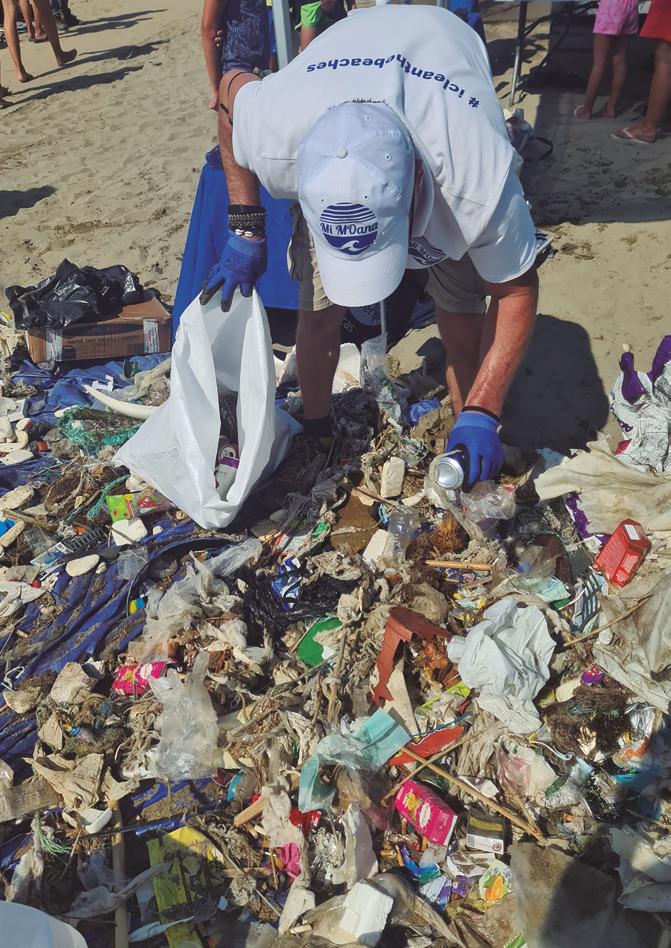
200 kg de basura recogidos en el Día Internacional de la Limpieza de Costas
200kg of rubbish collected for International Coastal Clean-Up Day Mi Moama
VOLUNTEERS and divers have united to clear 200kg of rubbish from the beach and ocean in Fuengirola.
On Saturday 18 September, environmental charity Mi Moana, with the support of Diving with Nic, Specsavers Ópticas Fuengirola and the Fuengirola Town Hall, brought together a team of more than 150 people to collect the rubbish and stop it damaging the ocean and marine wildlife.
The volunteers met at Fuengirola’s Pier T on International Coastal Clean-Up Day, and during just a few hours, collected 90kg of rubbish from the ocean and 110kg from the beach.
The Environmental Department from the Town Hall, Ecoembes, the Instituto de Oceanografía, Gestagua, Red Cross, and Hotel Illunion joined forces for this event, alongside Mi Moana and their sponsors, in order to educate people about environmental topics, as well as collect as much rubbish as possible.
Rosanna Bergquist from Specsavers Ópticas Fuengirola attended the event as part of the store’s environmentally friendly bag swap campaign, which ran throughout September. They gave away 60 reusable bags to Mi Moana volunteers, encouraging them to make the switch from plastic bags. She commented, “As sponsors of Mi Moana it was a pleasure to attend this great event. It was so well organised, with all participants receiving gloves and buckets to pick up as much rubbish as possible - I look forward to attending more. It’s incredible how much waste and rubbish there is lying in plain sight when you start looking.”
VOLUNTARIOS y buceadores se han unido para limpiar 200 kg de basura de la playa y el mar en Fuengirola.
El sábado 18 de septiembre, la organización benéfica medioambiental Mi Moana, con el apoyo de Diving with Nic, Specsavers Ópticas Fuengirola y el Ayuntamiento de Fuengirola, reunió a un equipo de más de 150 personas para recoger la basura y evitar que dañe el océano y la fauna marina.
Los voluntarios se reunieron en el Muelle T de Fuengirola en el Día Internacional de la Limpieza del Litoral, y durante sólo unas horas, recogieron 90 kg de basura del océano y 110 kg de la playa.
La Concejalía de Medio Ambiente del Ayuntamiento, Ecoembes, el Instituto de Oceanografía, Gestagua, Cruz Roja y el Hotel Illunion unieron sus fuerzas para este evento, junto con Mi Moana y sus patrocinadores, con el fin de educar a la gente sobre temas medioambientales, además de recoger la mayor cantidad de basura posible.
Rosanna Bergquist, de Specsavers Ópticas Fuengirola, asistió al evento como parte de la campaña de intercambio de bolsas ecológicas de la tienda, que se desarrolló durante todo el mes de septiembre. Regalaron 60 bolsas reutilizables a los voluntarios de Mi Moana, animándoles a cambiar las bolsas de plástico. Comentó: “Como patrocinadores de Mi Moana, fue un placer asistir a este gran evento. Estaba muy bien organizado, con todos los participantes recibiendo guantes y cubos para recoger toda la basura posible; estoy deseando asistir a más. Es
OTWO 27 / OCTOBER 2021 37 36 OTWO 27 / OCTOBER 2021

Environmental association Mi Moana has been created to protect the ocean. They have committed to organise one beach and underwater clean-up per month and educate the next generation, helping them reduce their impact on their environment. Their next event will take place on Saturday 16 October on Royal Beach Calahonda and will be a fun, pirate themed event, perfect for all the family.
Mi Moana’s co-founder Nikky Wegloop explains why the work they are doing is so important, “It’s vital that we make changes to protect our planet. During our events we don’t simply pick up litter, but also educate the volunteers to help them change their attitude towards waste and our planet. We’re so proud of all our volunteers, and our divers from Diving with Nic who are identifying the problems with waste in our oceans and getting out there to solve them. Our educational programme is being released soon, to increase understanding about the big, big problem our society is facing and how quickly we need to take action.”
Find out more about Mi Moana by visiting www. mimoana.org. There are Specsavers Ópticas stores in Marbella and Fuengirola on the Costa del Sol. Visit www.specsavers.es to find your nearest store.

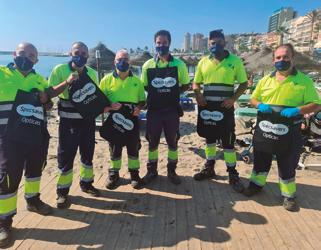
increíble la cantidad de residuos y basura que hay a la vista cuando empiezas a buscar”.
La asociación medioambiental Mi Moana se ha creado para proteger el océano. Se han comprometido a organizar una limpieza de playas y fondos marinos al mes y a educar a la próxima generación, ayudándola a reducir su impacto en el medio ambiente. Su próximo evento tendrá lugar el sábado 16 de octubre en la Playa Real de Calahonda y será un divertido evento con temática pirata, perfecto para toda la familia.
La cofundadora de Mi Moana, Nikky Wegloop, explica por qué es tan importante el trabajo que realizan: “Es vital que hagamos cambios para proteger nuestro planeta. Durante nuestros eventos no nos limitamos a recoger la basura, sino que también educamos a los voluntarios para ayudarles a cambiar su actitud hacia los residuos y nuestro planeta. Estamos muy orgullosos de todos nuestros voluntarios y de nuestros buceadores de Diving with Nic, que identifican los problemas de los residuos en nuestros océanos y salen a resolverlos. Nuestro programa educativo se publicará en breve, para que se comprenda mejor el gran problema al que se enfrenta nuestra sociedad y la rapidez con la que debemos actuar.”
Para saber más sobre Mi Moana, visita www. mimoana.org. Hay tiendas Specsavers Ópticas en Marbella y Fuengirola, en la Costa del Sol. Visita: www.specsavers.es para encontrar tu tienda más cercana.


OTWO 27 / OCTOBER 2021 39 OTWO 27 / OCTOBER 2021
The Climate Crisis is Here
La crisis climática está aquí
Author: Sarah Birch

Climate change is here and is increasing the frequency and intensity of severe weather events across the globe.
Last month, a report by UN scientists issued an alarming climate ‘code red’ stating that: “some of the changes already set in motion – such as continued sea-level rise – are irreversible over hundreds to thousands of years”.
These changes include extreme weather events, which have always disproportionately affected developing countries. This year, however, has been a revelation for many, as developed nations begin to experience the true destructive force of these catastrophes and how the climate crisis is and will continue to affect us all.
Storms and Flooding
This year has seen some of the worst flooding Europe has ever seen. In January, Storm Christoph hit the U.K, bringing with it “one of the wettest threeday periods on record” in North West England and North Wales.
The U.S. state of Texas was hit by an arctic blast in February when Winter Storm Uri hit large parts of the country. Blizzards and below-freezing temperatures caused one of the worst power outages in the U.S. history and a total of 210 deaths.
In July, extreme downpours affected large areas of Europe. In Germany, thousands of homes and entire towns were destroyed. The sheer amount of rain shocked even climate scientists, who have warned that extreme weather events are becoming increasingly likely. The record-breaking precipitation caused rivers to swell, power outages, and at least 58 deaths. The total damage caused by the floods could cost more than €6bn.
Turkey declared a state of emergency following a week of heavy storms in August, just as the country was beginning to bring hundreds of wildfires under control. The floods were described as the worst in Turkey’s history, with hundreds of homes swept away, 81 people killed, and 228 more injured after water levels rose 4 metres in some places.
In late August, Hurricane Ida caused massive devastation across the Caribbean, Louisiana and Mississippi. Louisiana was hit hardest, with winds, flash
El cambio climático está aquí y está aumentando la frecuencia e intensidad de los fenómenos meteorológicos graves en todo el mundo.
El mes pasado, un informe de los científicos de la ONU emitió un alarmante “código rojo” climático en el que se afirmaba que “algunos de los cambios que ya se han puesto en marcha -como el continuo aumento del nivel del mar- son irreversibles a lo largo de cientos o miles de años”.
Entre estos cambios se encuentran los fenómenos meteorológicos extremos, que siempre han afectado de forma desproporcionada a los países en desarrollo. Este año, sin embargo, ha sido una revelación para muchos, ya que las naciones desarrolladas empiezan a experimentar la verdadera fuerza destructiva de estas catástrofes y cómo la crisis climática nos afecta y seguirá afectando a todos.
Tormentas e inundaciones
Este año se han producido algunas de las peores inundaciones que ha visto Europa. En enero, la tormenta Christoph azotó el Reino Unido, trayendo consigo “uno de los períodos de tres días más lluviosos que se hayan registrado” en el noroeste de Inglaterra y el norte de Gales.
El estado de Texas, en Estados Unidos, se vio afectado por una ráfaga ártica en febrero, cuando la tormenta invernal Uri afectó a gran parte del país. Las ventiscas y las temperaturas bajo cero provocaron uno de los peores apagones de la historia de Estados Unidos y un total de 210 muertos.
En julio, los aguaceros extremos afectaron a amplias zonas de Europa. En Alemania, miles de casas y ciudades enteras quedaron destruidas. La gran cantidad de lluvia conmocionó incluso a los científicos del clima, que han advertido que los fenómenos meteorológicos extremos son cada vez más probables. Las precipitaciones sin precedentes provocaron la crecida de los ríos, cortes de electricidad y al menos 58 muertes. El daño total causado por las inundaciones podría costar más de 6.000 millones de euros. Turquía declaró el estado de emergencia tras una semana de fuertes tormentas en agosto, justo cuando el país empezaba a controlar cientos de incendios forestales. Las inundaciones fueron descritas como las peores de la historia de Turquía, con cientos de casas arrasadas, 81 personas muertas y 228 más
OTWO 27 / OCTOBER 2021 41

floods and tornadoes destroying a large number of homes. Three weeks on, parts of Louisiana still have no power, and thousands of people remain displaced. After landfall, the storm made its way north, causing severe flash floods in Connecticut, Pennsylvania, New Jersey and New York. Record rainfall inundated parts of the subway system, and nearly a million people lost power.
Scientists believe that the unprecedented heat waves across Northern Europe and the Pacific Northwest triggered massive downpours and storms. Above-average atmospheric temperatures led to increased water vapour resulting in heavy precipitation.
A study by the World Weather Attribution Initiative looked at rainfall data to determine the chances of extreme rainfall events occurring in the world today – which is 1.2C warmer than pre-industrial times. The analysis found that these events are up to 9 times more likely because of climate change.
The abnormally warm summer also caused extreme storms and flash floods in other parts of the world. In July, Chinas Henan Province saw one year’s worth of rainfall in three days, causing widespread destruction. Japan, Indonesia, Australia, Fiji and Colombia were also hit by devastating storms and floods.
Extreme Heat
July 2021 was the hottest month ever recorded on Earth. Combined global land and ocean surface temperatures were 0.93 Celsius higher than the 20th Century average of 15.8C, which not only made it the hottest July ever but the highest average global temperature ever recorded since records began.
Areas with usually mild conditions experienced record temperatures this year. Moscow sweltered during its hottest June day in 120 years, and New Zealand recorded its hottest June day ever. Data published in September shows that New Zealand had its warmest winter on record.
At the summit of the Greenland Ice Sheet, which is 3,216-metre high and well below freezing, rain fell for the first time on record during an exceptionally warm three days, with temperatures 18C above average.
From late June to mid-July a heat dome hit the Pacific Northwest, causing extreme heat waves across North America and Canada. The small mountain village of Lytton sweltered in a prolonged heat
heridos después de que el nivel del agua subiera 4 metros en algunos lugares.
A finales de agosto, el huracán Ida causó una enorme devastación en el Caribe, Luisiana y Misisipi. Luisiana fue la más afectada, con vientos, inundaciones repentinas y tornados que destruyeron un gran número de hogares. Tres semanas después, algunas partes de Luisiana siguen sin electricidad y miles de personas siguen desplazadas. Tras tocar tierra, la tormenta se dirigió hacia el norte, provocando graves inundaciones repentinas en Connecticut, Pensilvania, Nueva Jersey y Nueva York. Las lluvias récord inundaron partes de la red de metro y casi un millón de personas se quedaron sin electricidad.
Los científicos creen que las olas de calor sin precedentes en el norte de Europa y el noroeste del Pacífico desencadenaron aguaceros y tormentas masivas. Las temperaturas atmosféricas superiores a la media provocaron un aumento del vapor de agua que dio lugar a fuertes precipitaciones.
Un estudio realizado por la Iniciativa de Atribución del Tiempo en el Mundo examinó los datos de las precipitaciones para determinar las probabilidades de que se produzcan fenómenos de lluvia extrema en el mundo actual, que es 1,2C más cálido que la época preindustrial. El análisis determinó que estos eventos son hasta 9 veces más probables debido al cambio climático.
El verano anormalmente cálido también provocó tormentas extremas e inundaciones repentinas en otras partes del mundo. En julio, en la provincia china de Henan llovió lo mismo que en un año en tres días, causando una gran destrucción. Japón, Indonesia, Australia, Fiyi y Colombia también se vieron afectados por devastadoras tormentas e inundaciones.
Calor extremo
Julio de 2021 fue el mes más caluroso jamás registrado en la Tierra. Las temperaturas globales combinadas de la superficie terrestre y oceánica fueron 0,93 Celsius más altas que la media del siglo XX, de 15,8C, lo que no sólo lo convirtió en el julio más caluroso de la historia, sino en la temperatura media global más alta jamás registrada desde que hay registros.
Zonas con condiciones habitualmente suaves experimentaron este año temperaturas récord. En Mos-
42 OTWO 27 / OCTOBER 2021

spike where temperatures reached 49.6C, breaking all previous records in Canada. Wildfires followed, burning Lytton to the ground. Flood warnings were also issued in lower-lying river valleys as snow and ice in glacial areas melted at an alarming rate.
Described as a 1000-year weather event, California, Washington, Oregon and Nevada also suffered. Temperatures were a massive 11-19C above average. Over 1000 people are estimated to have died across both countries, and a billion marine animals perished.
Europe also sweltered under intense heat, with temperatures soaring across Greece, Italy, Spain and Turkey. In July, the highest temperature ever recorded in Europe was logged in Sicily at 48.8C.
Just like the extreme floods in Europe, scientists expressed their shock and alarm at the extreme heat, which has come earlier and is much more intense than previous worst-case climate forecasts. Preliminary studies suggest that human-made climate change has made such events 150 times more likely.
As warming continues and precipitation patterns change, areas already affected by drought will worsen and expand. A megadrought is already causing major water shortages across the United States, with no end in sight.
Brazil is currently enduring one of its worst droughts in history and following four years without rain, Madagascar is experiencing its worst drought in 40 years. According to the UN, Madagascar is on the verge of the world’s first “climate change famine”.
Wildfires
The last few years have seen massive wildfires ravage many parts of the world, and 2021 is no exception.
Extreme heat, drought and drying landscapes have provided the optimum conditions for wildfires to spread faster and further than before.
Europe has suffered one of its worst years for wildfires and its worst July for fires since satellite records began in 2003.
In Greece, the intense heatwave sparked hundreds of fires across the country, with many of them rapidly spreading out of control, leading the EU to mount one of its largest firefighting operations ever as temperatures hit 47C. Athens was encircled by
cú se registró el día de junio más caluroso de los últimos 120 años, y en Nueva Zelanda se registró el día de junio más caluroso de la historia. Los datos publicados en septiembre muestran que Nueva Zelanda tuvo su invierno más cálido registrado.
En la cima de la capa de hielo de Groenlandia, de 3.216 metros de altura y muy por debajo del punto de congelación, llovió por primera vez en la historia durante tres días excepcionalmente cálidos, con temperaturas de 18C por encima de la media.
Desde finales de junio hasta mediados de julio, una cúpula de calor azotó el noroeste del Pacífico, provocando olas de calor extremas en toda Norteamérica y Canadá. El pequeño pueblo montañoso de Lytton se vio sometido a un prolongado pico de calor en el que las temperaturas alcanzaron los 49,6C, batiendo todos los récords anteriores en Canadá. Los incendios forestales siguieron, quemando Lytton hasta los cimientos. También se emitieron avisos de inundación en los valles fluviales más bajos, ya que la nieve y el hielo de las zonas glaciares se derritieron a un ritmo alarmante.
California, Washington, Oregón y Nevada también sufrieron el fenómeno meteorológico descrito como un milenio. Las temperaturas se situaron entre 11 y 19ºC por encima de la media. Se estima que más de 1000 personas murieron en ambos países y mil millones de animales marinos perecieron.
Europa también sufrió un calor intenso, con temperaturas que se dispararon en Grecia, Italia, España y Turquía. En julio, la temperatura más alta jamás registrada en Europa se registró en Sicilia con 48,8C. Al igual que las inundaciones extremas en Europa, los científicos expresaron su conmoción y alarma por el calor extremo, que se ha adelantado y es mucho más intenso que las anteriores previsiones climáticas del peor caso. Los estudios preliminares sugieren que el cambio climático provocado por el ser humano ha hecho que estos fenómenos sean 150 veces más probables.
A medida que continúe el calentamiento y cambien los patrones de precipitación, las zonas ya afectadas por la sequía empeorarán y se ampliarán. Una megasequía ya está provocando una gran escasez de agua en todo Estados Unidos, sin que se vea el final.
Brasil está soportando actualmente una de sus peores sequías de la historia y, tras cuatro años sin
OTWO 27 / OCTOBER 2021 45
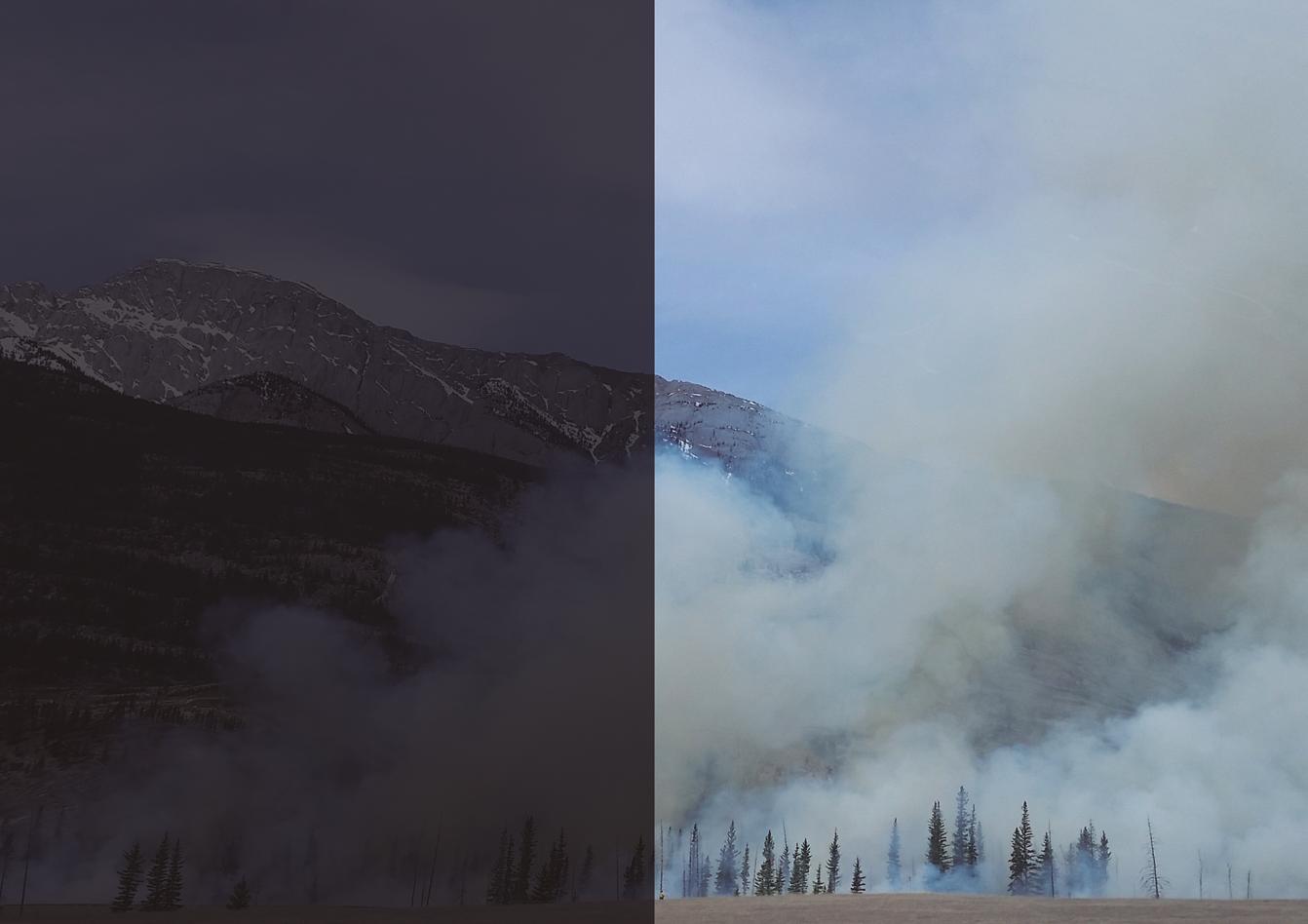
fires, thousands were evacuated, hundreds lost their homes, and the fires came frightening close to ravaging the ancient site of Olympia.
Video of tourists and residents fleeing Evia by ferry as an inferno engulfed the island showed just how devastating the fires were. Hundreds of thousands of hectares of ancient pine forest burnt down, thousands have lost their homes and livelihoods, with many saying life on the island will never be the same again.
Turkey has also suffered its worst wildfires in a decade. So far this year, there have been 2105 fires across the country. Wildfires ripped through tourist areas, forests and agricultural land.
During the last weekend of July, Italy recorded 800 wildfires burning simultaneously across the country. The number of large wildfires this summer is thought to have tripled compared to the yearly average.
Following a record-breaking fire season in 2020, Siberia has once again experienced extreme heatwaves and wildfires. This year’s wildfires were larger than those in Greece, Turkey, Italy, the United States and Canada combined. The main concern over the ever-increasing size of the Siberian wildfires is the amount of CO2 they emit. Since June, they have produced 800 megatons of carbon dioxide, almost double that of 2020 and more than Germany produces in an entire year.
More than 5.5 million acres have burned across the US this year, exacerbated by heatwaves, strong winds, lightning and the megadrought affecting large parts of the country.
How extreme weather will impact us all
A recent report by the IPCC warns that extreme weather events will only worsen as the human-induced climate crisis continues.
As the planet warms, we will have to adapt to living in hotter climatic conditions, with some areas becoming uninhabitable. The health impacts include increased heat-related illnesses and excess fatalities, and infectious diseases such as dengue and malaria affecting more regions. Wildfire seasons will also become longer, more destructive and affect more areas.
Food production will be affected, with one-third of global food production at risk. Many of the planets
lluvias, Madagascar está experimentando su peor sequía en 40 años. Según la ONU, Madagascar está a punto de sufrir la primera “hambruna por el cambio climático” del mundo.
Incendios forestales
En los últimos años, los incendios forestales masivos han arrasado muchas partes del mundo, y 2021 no es una excepción.
El calor extremo, la sequía y la desecación de los paisajes han creado las condiciones óptimas para que los incendios forestales se propaguen más rápido y más lejos que antes.
Europa ha sufrido uno de sus peores años en cuanto a incendios forestales y su peor mes de julio en cuanto a incendios desde que se iniciaron los registros por satélite en 2003.
En Grecia, la intensa ola de calor provocó cientos de incendios en todo el país, muchos de los cuales se extendieron rápidamente fuera de control, lo que llevó a la UE a organizar una de sus mayores operaciones de lucha contra el fuego cuando las temperaturas alcanzaron los 47ºC. Atenas quedó rodeada por los incendios, miles de personas fueron evacuadas, cientos perdieron sus casas y los incendios estuvieron a punto de arrasar el antiguo emplazamiento de Olimpia.
El vídeo de turistas y residentes huyendo de Eubea en ferry mientras el infierno envolvía la isla mostró lo devastador de los incendios. Cientos de miles de hectáreas de antiguos bosques de pinos se quemaron, miles de personas perdieron sus hogares y medios de vida, y muchos dicen que la vida en la isla nunca volverá a ser la misma.
Turquía también ha sufrido sus peores incendios forestales en una década. En lo que va de año, se han producido 2105 incendios en todo el país. Los incendios forestales han arrasado zonas turísticas, bosques y terrenos agrícolas.
Durante el último fin de semana de julio, Italia registró 800 incendios forestales que ardían simultáneamente en todo el país. Se cree que el número de grandes incendios forestales de este verano se ha triplicado en comparación con la media anual.
Tras una temporada de incendios sin precedentes en 2020, Siberia ha vuelto a sufrir olas de calor e incendios forestales extremos. Los incendios forestales de este año han sido mayores que los de Grecia,
46 OTWO 27 / OCTOBER 2021
most significant food production areas will suffer from reduced water supplies and extreme weather events such as flooding and drought.
Tropical storms feed on warm oceans, and evidence suggests that as temperatures continue to rise, so will the frequency and intensity of these storms. The resulting infrastructure damage will not only cost countries billions but will pose a massive risk to people’s health and their livelihoods.
Flash flooding will also affect more and more people in the coming decades. According to a study published in the science journal Nature, 255-290 million people were directly affected by floods between 2000-2018. However, population growth in many of these areas has grown by 34.1%, meaning ten times more people will be vulnerable to flooding in the next decade.
With the inevitable 1.5-2C warming expected by the end of the century, these events will undoubtedly intensify. And with predictions that emissions will reach a record high by 2023, more must be done to drastically reduce fossil fuel consumption. The same UN report that declares the irreversibility of some of the changes we are already experiencing also affirms that a “strong and sustained reduction in emissions of carbon dioxide and other greenhouse gases would limit climate change”.

Turquía, Italia, Estados Unidos y Canadá juntos. La principal preocupación por el tamaño cada vez mayor de los incendios forestales siberianos es la cantidad de CO2 que emiten. Desde junio, han producido 800 megatoneladas de dióxido de carbono, casi el doble que en 2020 y más de lo que produce Alemania en todo un año.
Este año han ardido más de 5,5 millones de acres en todo EEUU, agravados por las olas de calor, los fuertes vientos, los rayos y la megasequía que afecta a grandes partes del país.
Cómo nos afectará a todos, el clima extremo
Un reciente informe del IPCC advierte que los fenómenos meteorológicos extremos no harán más que empeorar a medida que continúe la crisis climática inducida por el hombre.
A medida que el planeta se calienta, tendremos que adaptarnos a vivir en condiciones climáticas más cálidas, y algunas zonas se volverán inhabitables. Los impactos en la salud incluyen el aumento de las enfermedades relacionadas con el calor y el exceso de muertes, y las enfermedades infecciosas como el dengue y la malaria que afectan a más regiones. Las temporadas de incendios forestales también serán más largas, más destructivas y afectarán a más zonas.
La producción de alimentos se verá afectada, con un tercio de la producción mundial de alimentos en peligro. Muchas de las zonas de producción de alimentos más importantes del planeta sufrirán la reducción del suministro de agua y los fenómenos meteorológicos extremos, como las inundaciones y la sequía.
Las tormentas tropicales se alimentan de océanos cálidos, y las pruebas sugieren que, a medida que las temperaturas sigan aumentando, también lo harán la frecuencia y la intensidad de estas tormentas. Los daños resultantes en las infraestructuras no sólo costarán miles de millones a los países, sino que supondrán un enorme riesgo para la salud de las personas y sus medios de vida.
Las inundaciones repentinas también afectarán a un número cada vez mayor de personas en las próximas décadas. Según un estudio publicado en la revista científica Nature, entre 2000 y 2018 las inundaciones afectaron directamente a entre 255 y 290
millones de personas. Sin embargo, el crecimiento de la población en muchas de estas zonas ha crecido un 34,1%, lo que significa que en la próxima década habrá diez veces más personas vulnerables a las inundaciones.
Con el inevitable calentamiento de 1,5-2C previsto para finales de siglo, estos fenómenos se intensificarán sin duda. Y con las predicciones de que las emi-
siones alcanzarán un récord en 2023, hay que hacer más para reducir drásticamente el consumo de combustibles fósiles. El mismo informe de la ONU que declara la irreversibilidad de algunos de los cambios que ya estamos experimentando también afirma que una “reducción fuerte y sostenida de las emisiones de dióxido de carbono y otros gases de efecto invernadero limitaría el cambio climático”.
48 OTWO 27 / OCTOBER 2021
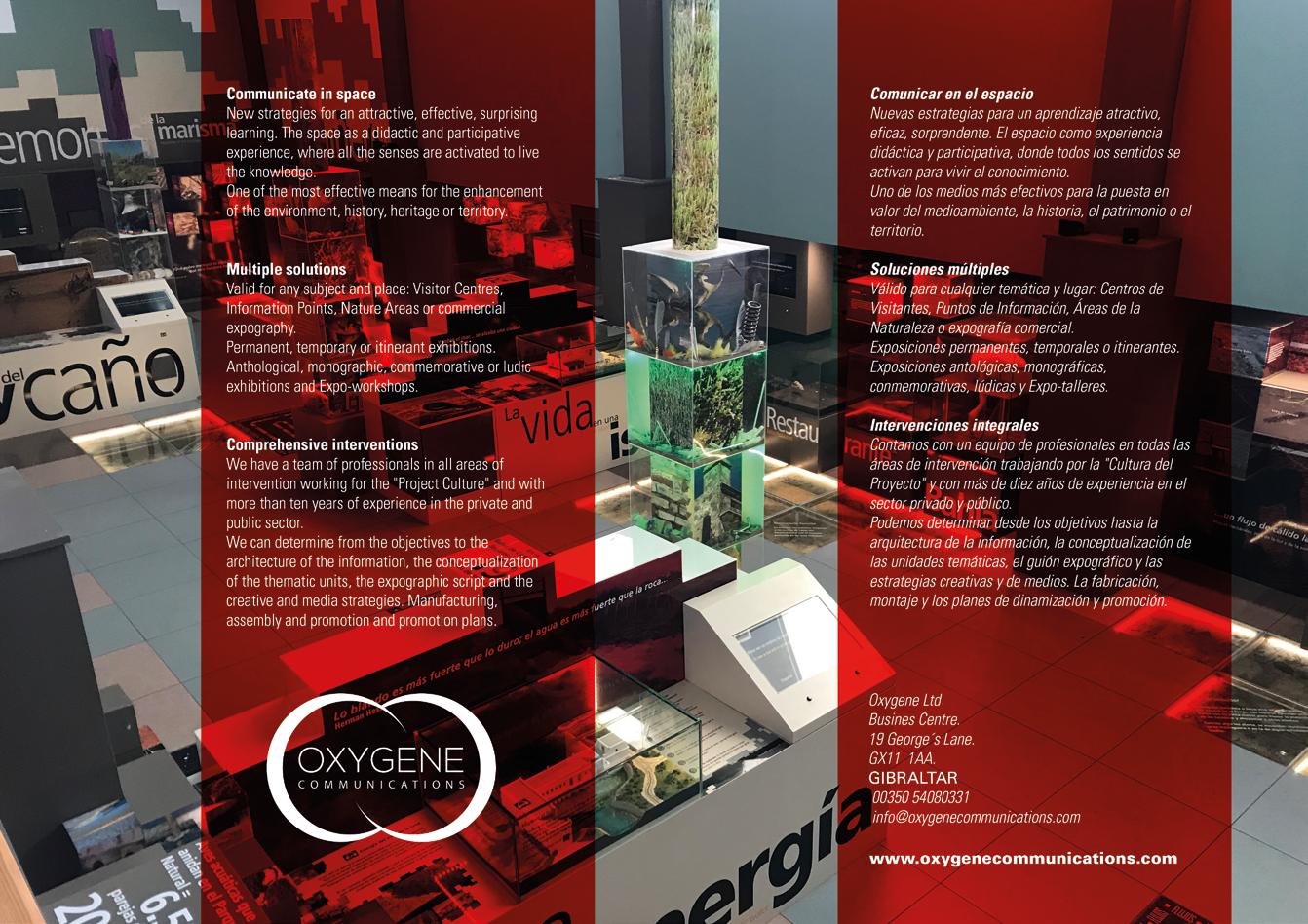

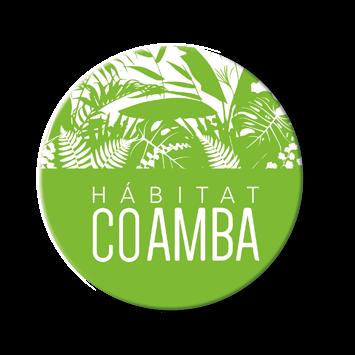

“Photovoltaic self-consumption is our best asset to rebuild our economy and a sustainable world”
«El autoconsumo fotovoltaico es nuestra mejor baza para re construir nuestra economía y un mundo sostenible»
Author: Coamba Fotografías María Molina / Pexels.
These are the words of María Molina Jimena (Málaga, 1996), member of COAMBA (Association of Environmentalists of Andalusia) and photovoltaic technician of QUANTICA Renovables (www.quanticarenovables.com).
Energy is on everyone’s lips and no wonder. In Spain, during the month of August, the highest price in history for energy generation has been reached, which will mean that users will receive the most expensive electricity bill they have ever paid. The recent lowering of VAT applied by the Government will hardly minimize this price and public opinion is demanding more and more effective measures from those in power who do not seem to agree on a roadmap to promote and accelerate the Energy Transition in our country.
Although the cost of energy is a priority the most visible and pressing problem for citizens, the necessary change in the energy matrix worldwide represents the most important issue for human life in this century. María Molina is certain of this, and she dedicates her daily work to convincing families and companies to join this energy transition as soon as possible.
“From my point of view, the current very high cost of energy is positive news for the world if it serves as a wake-up call for public awareness. That people consider changing the way they produce and consume energy to reduce costs is a good first step towards a major undertaking: the conservation of the planet and life on it.
There are multiple reports that reveal that the Iberian Peninsula will be one of the territories most affected by climate change worldwide. This reality
Son palabras de María Molina Jimena (Málaga, 1996), colegiada de COAMBA (Colegio de Ambientólogos de Andalucía) y técnica fotovoltaica de QUANTICA Renovables (www.quanticarenovables.com).
La energía está en boca de todos y no es para menos. En España, durante el mes de agosto, se ha alcanzado el precio más alto de la historia para la generación energética, lo que supondrá a los usuarios recibir la factura eléctrica más cara que jamás hayan pagado. La reciente bajada del IVA aplicada por el Gobierno apenas minimizará este precio y la opinión pública reclama más y más efectivas medidas a unos gobernantes que parecen no ponerse de acuerdo en la hoja de ruta que impulse y acelere la Transición Energética en nuestro país.
Si bien el coste de la energía es a priori el problema más visible y acuciante para la ciudadanía, el necesario cambio en la matriz energética a nivel mundial representa la cuestión más trascendental para la vida humana en este siglo. De ello está segura María Molina, que dedica su día a día a convencer a familias y empresas de sumarse cuanto antes a esta transición energética.
«Desde mi punto de vista, el elevadísimo coste actual de la energía es una noticia positiva para el mundo si sirve como despertador para la conciencia ciudadana. Que las personas se planteen cambiar el modo en que producen y consumen energía para abaratar costes es un buen primer paso hacia una empresa mayor: la conservación del planeta y de la vida en él. Hay múltiples informes que revelan que la península ibérica será de los territorios más afectados por el cambio climático a nivel mundial. Esta realidad invita inexorablemente a que desatemos el potencial
53 52
OTWO 27 / OCTOBER 2021 OTWO 27 / OCTOBER 2021
inexorably invites us to unleash the renewable potential of our territory and rebuild our economy after the pandemic, taking advantage of the green wealth of the natural resources at our disposal, which have an incalculable value in terms of energy generation”.
More than 1.3 billion in subsidies for self-consumption
In addition to the announcement of the lowering of VAT on electricity bills, there is the accelerated closure of coal plants in Spain. The approval by the Council of Ministers of up to 1.32 billion euros in subsidies for the installation of photovoltaic self-consumption systems in homes, businesses and industries, and the new renewable energy auction to install 3,300 MW of power generated by solar and wind energy.
“Spain is fully immersed in the IV Industrial Revolution. Being aware of the level of social and environmental impact of my work at QUANTICA Renovables is my greatest motivation and satisfaction on a daily basis. The 21st century will be remembered as the century in which distributed generation was born: the century in which individuals achieved their energy freedom and independence.
My job is to help people and organizations to achieve this freedom through photovoltaic self-consumption, which empowers us as producers of clean energy, which has a positive impact on our pocket and our environment. Unfortunately, there is a lot of misinformation and ignorance about energy, perhaps sponsored by the interests of the former electricity oligopoly. From QUANTICA we do a lot of pedagogy to generate a sometimes battered confidence in some users due to the malpractice of the big energy corporations”.
Spain, at the forefront in renewable energies Spanish engineers have spent decades developing and being part of the most important renewable energy projects worldwide. That is why Spain has the necessary knowledge base to successfully face the country’s Energy Transition.
“For any profound change it is advisable to rely on those who can best help us to bring it to fruition. Users must filter and differentiate between those who simply install solar panels and those who are
renovable que posee nuestro territorio y re construyamos nuestra economía tras la pandemia aprovechando la riqueza verde de los recursos naturales de los que disponemos y que tienen un valor incalculable en términos de generación energética».
Más de 1.300 millones en subvenciones al autoconsumo
Al anuncio de la bajada del IVA en la factura eléctrica, se suman el cierre acelerado de las plantas de carbón en España, la aprobación por parte del consejo de ministros de hasta 1.320 millones de euros en subvenciones para la instalación de sistemas de autoconsumo fotovoltaico en hogares, empresas e industrias y la nueva subasta de energías renovables para instalar 3.300 MW de potencia generados por la energía solar y la eólica.
«España se encuentra inmersa plenamente en la IV Revolución Industrial. Ser consciente del nivel de impacto social y medioambiental que tiene mi trabajo en QUANTICA Renovables es mi mayor motivación y satisfacción en el día a día. El S.XXI será recordado como el siglo en que nació la generación distribuida: el siglo en que los individuos alcanzaron su libertad e independencia energética.
Mi trabajo consiste en ayudar a las personas y organizaciones a alcanzar esta libertad a través del autoconsumo fotovoltaico, que nos empodera como productores de energía limpia, lo que redunda positivamente en nuestro bolsillo y en nuestro entorno. Lamentablemente existe mucha desinformación y desconocimiento al respecto de la energía, quizás auspiciados por los propios intereses del anterior oligopolio eléctrico. Desde QUANTICA hacemos muchísima pedagogía para generar una confianza a veces maltrecha en algunos usuarios por motivo de la mala praxis de las grandes corporaciones energéticas».
España, a la vanguardia en energías renovables
Los ingenieros españoles llevan décadas desarrollando y siendo parte de los más importantes proyectos de energías renovables a nivel mundial. De ahí que España cuente con la base de conocimiento necesaria para afrontar con éxito la Transición Energética del país.
“Para todo cambio profundo es conveniente apoyarse en quien mejor puede ayudarnos a llevarlo a buen puerto. Los usuarios han de filtrar y diferenciar

Vista aérea de la instalación fotovoltaica de QUANTICA Renovables en Novaschool Añoreta, Rincón del Victoria (Málaga).

54 OTWO 27 / OCTOBER 2021 OTWO 27 / OCTOBER 2021 55
Aerial view of the photovoltaic installation of QUANTICA Renovables in Novaschool Añoreta, Rincón del Victoria (Málaga).
QUANTICA installation of the Manilva Green resort, Manilva (Málaga). Instalación QUANTICA del resort Manilva Green, Manilva (Málaga).

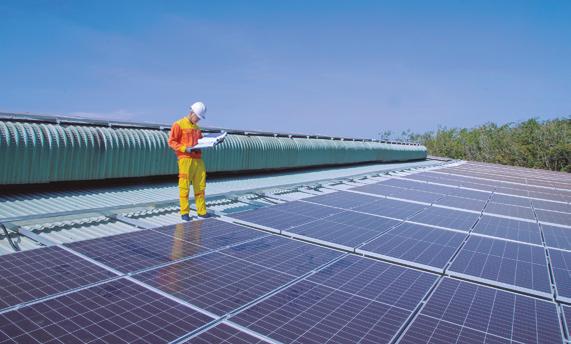
capable of carrying out an in-depth photovoltaic study that correctly sizes the energy needs of their home or company and allows them to obtain the highest energy and economic returns from a self-consumption installation. This is basically what our engineers do.”
The electrification process is going to inject a lot of money into the Spanish economy and will be a unique opportunity to generate skilled jobs needed to implement the Energy Transition. In the annual report of the Spanish Photovoltaic Union (UNEF), it is shown that the photovoltaic sector grew by 7% in 2020 despite the pandemic and that, in self-consumption, the power increased by 30% over the previous year. In terms of employment, there were 58,892 national workers directly or indirectly linked to the sector.
“In the year that I have been at QUANTICA Renovables, the team has tripled. Self-consumption is going to require people to enable its definitive expansion. In addition to engineers, we will need operators, installers, electricians, administrative and commercial technicians capable of advising and providing the best solutions for each user. The moment really represents an opportunity and a hope for everyone after the difficult times we have recently experienced due to COVID-19”.
Malaga, the coast that lives up to its name
The sun in Malaga shines more than 320 days of the 365 that make up a calendar year. With this spectacular figure on the table, it is not surprising that its climatology is one of the great attractions of the Costa del Sol; both to attract national and international tourism and to allow people and companies not to hesitate when changing their energy reality to self-consumption. Almost 3,000 hours of sunshine, a year there is no doubt about the solar wealth of the province of Malaga and its nine regions.
“As an environmentalist and from Malaga I feel doubly proud of the natural wealth of my land. I am excited to feel that my work favors the conservation of the ecosystem of my province and that this legacy will be passed on to the new generations, who will be the ones to continue the work that I myself and others like me are doing”.
entre quienes simplemente colocan paneles solares y quienes son capaces de realizar un estudio fotovoltaico profundo que dimensione correctamente las necesidades energéticas de su vivienda o empresa y permita obtener los mayores rendimientos, energético y económico, de una instalación de autoconsumo. Esto es básicamente lo que hacen nuestros ingenieros.»
El proceso de electrificación va a inyectar muchísimo dinero en la economía española y va a suponer una oportunidad única para generar puestos de trabajo cualificados necesarios para ejecutar la Transición Energética. En el informe anual de la Unión Española Fotovoltaica (UNEF), se demuestra que el sector fotovoltaico creció en 2020 un 7 % a pesar de la pandemia y que, en autoconsumo, la potencia aumentó un 30% con respecto al año anterior. En cuanto al empleo, hubo 58.892 trabajadores nacionales ligados directa o indirectamente al sector.
«En el año que llevo en QUANTICA Renovables, el equipo se ha triplicado. El autoconsumo va a requerir de personas que permitan su expansión definitiva. Además de ingenieros, harán falta operarios, instaladores, electricistas, administrativos, técnicos comerciales capaces de asesorar y dar las mejores soluciones para cada usuario. Realmente el momento representa una oportunidad y una esperanza para todos después de los momentos tan difíciles que hemos vivido recientemente a causa de la COVID-19”».
Málaga, la costa que hace honor a su nombre El sol en Málaga brilla más de 320 días de los 365 que conforman un año natural. Con esta espectacular cifra encima de la mesa no es de extrañar que su climatología sea uno de los grandes atractivos de la Costa del Sol; tanto para atraer al turismo nacional e internacional como para permitir a personas y empresas no dudar a la hora de cambiar su realidad energética al autoconsumo. Casi 3.000 horas de sol al año no hay duda de la riqueza solar de la provincia de Málaga y sus 9 comarcas.
«Como ambientóloga y malagueña me siento doblemente orgullosa de la riqueza natural de mi tierra. Me ilusiona sentir que mi trabajo favorece la conservación del ecosistema de mi provincia y que este legado contagie a las nuevas generaciones, que serán quienes den continuidad al trabajo que yo misma y otr@s como yo estamos realizando».
56 OTWO 27 / OCTOBER 2021 OTWO 27 / OCTOBER 2021 57
QUANTICA installation in El Copo, Estepona (Málaga). Instalación QUANTICA en El Copo, Estepona (Málaga).

CIUDADES ACTIVAS

Background
In the early 2000s, the sustainable label was being imposed in all areas and urban debates. The city and all that its planning entailed led to the emergence of tools and regulations aimed at improving the environment from an energy perspective, solely oriented towards reducing consumption and the alternative use of energy resources, all with the aim of improving the overall health of the population.
At the same time, the healthy label appears, linked mainly to the environmental issue but leaving health itself in the background. It is here where we find the need to act more directly on the citizen, i.e. on the person himself and his individual health.
In analyzing the urban conditioning factors that
Antecedentes
A principios del 2000 la etiqueta sostenible se imponía en todos los ámbitos y debates urbanos. La ciudad y todo lo que conlleva su planificación hacían que se plantea en herramientas y normativas orientadas a la mejora del medio ambiente desde una perspectiva energética, únicamente orientada a la reducción del consumo y a la utilización alternativa de los recursos energéticos, todo con el objetivo de mejorar la salud global de la población.
De forma paralela aparece la etiqueta saludable vinculada principalmente a la cuestión ambiental pero dejando en un segundo plano la propia salud. Es aquí donde encontramos la necesidad de actuar de forma más directa sobre el ciudadano, es decir
OTWO 27 / OCTOBER 2021 61 60 OTWO 27 / OCTOBER 2021
Text and photos: José Antonio Duarte
will allow us to improve health, we find, according to the WHO, four aspects that have a direct impact on people and that could be regulated by city planning, the urban environment being a fundamental factor that will establish the different access routes to alcohol consumption, tobacco, and likewise to food and physical activity.
It is clear that both alcohol and tobacco should be regulated by means of regulations that limit their consumption, but we are left with the question of integrating into this urban planning the guarantee of an adequate diet, or rather access to a healthy diet, as well as the conditioning factors that will encourage an active lifestyle based on the practice of a minimum of physical exercise that minimizes sedentary habits.
In this way, we can consider the active city from the perspective of the lifestyles that each city offers its citizens.
Why are active cities necessary?
Or, in other words, why is it necessary to transform cities into active ones?
Returning to this need indicated by the WHO, the active city on a global scale is necessary due to the increase in obesity worldwide, mainly in developed countries. The cause of this would be the sedentary lifestyle caused by the lifestyle that incites us or conditions the current cities.
The increasingly less compact urban design and dispersed urbanizations in which the dependence on motorized vehicles makes the daily routine a low energy expenditure and likewise all daily activities are based on minimizing effort. We add here a society marked by the time factor, or rather speed, we find that in addition to the eight working hours we add a large number of hours of passive leisure, i.e. unhealthy activities.
In this urban space-time relationship in which we are encouraged to go faster in all senses, the need to reflect on the distances and rhythms that we must acquire to meet professional or rather consumer needs appears. We take as an example the phenomenon of the 15-minute city proposed by Carlos Moreno, professor at the Sorbonne University, for the city of Paris, based on this vision of chrono-urbanism.
In a more compact city, closer as he indicates with all daily needs covered within a 15-minute ra-
sobre la propia persona y su salud individual. Puestos a analizar los condicionantes urbanos que nos van a permitir la mejora de la salud encontramos según la OMS cuatro aspectos que inciden directamente en las personas y que podrían regularse desde la planificación de la ciudad siendo el Entorno Urbano un factor fundamental donde se van a establecer las diferentes vías de acceso al consumo de alcohol, de tabaco, y de igual modo hacia la alimentación y la actividad física.
Es evidente que tanto el alcohol como el tabaco deben ser regulados mediante normativas que limiten su consumo pero nos queda la cuestión de integrar en esa planificación urbana la garantía a una alimentación adecuada o mejor dicho el acceso a una alimentación saludable, así como los condicionantes que nos van a fomentar un estilo de vida activo basado en la práctica de un mínimo ejercicio físico que minimicen los hábitos sedentarios.
De este modo podemos plantear la consideración de ciudad activa desde la perspectiva de los estilos de vida que cada ciudad ofrece a sus ciudadanos.
¿Por qué son necesarias las ciudades activas?
O dicho de otro modo, ¿por qué es necesario transformar las ciudades en activas?
Retomando a esta necesidad que indica la OMS, la ciudad activa desde una escala global se hace necesaria y debido al aumento de la obesidad a nivel mundial principalmente en países desarrollados. El causante de esto sería el sedentarismo ocasionado por ese estilo de vida que nos incita o condiciona a las ciudades actuales.
El diseño urbano cada vez menos compacto y de urbanizaciones dispersas en las que la dependencia de los vehículos motorizados es total hace que la rutina diaria presente un escaso gasto energético y de igual modo que todas las actividades diarias se basan en minimizar el esfuerzo. Sumamos aquí una sociedad marcada por el factor tiempo, o mejor dicho velocidad, nos encontramos como a las ocho horas laborables le sumamos una gran cantidad de horas de ocio pasivo es decir actividades poco saludables.
En esta relación urbana espacio temporal en la que nos animan a ir más rápido en todos los sentidos aparece la necesidad de reflexionar sobre las distancias y los ritmos que debemos adquirir para al-
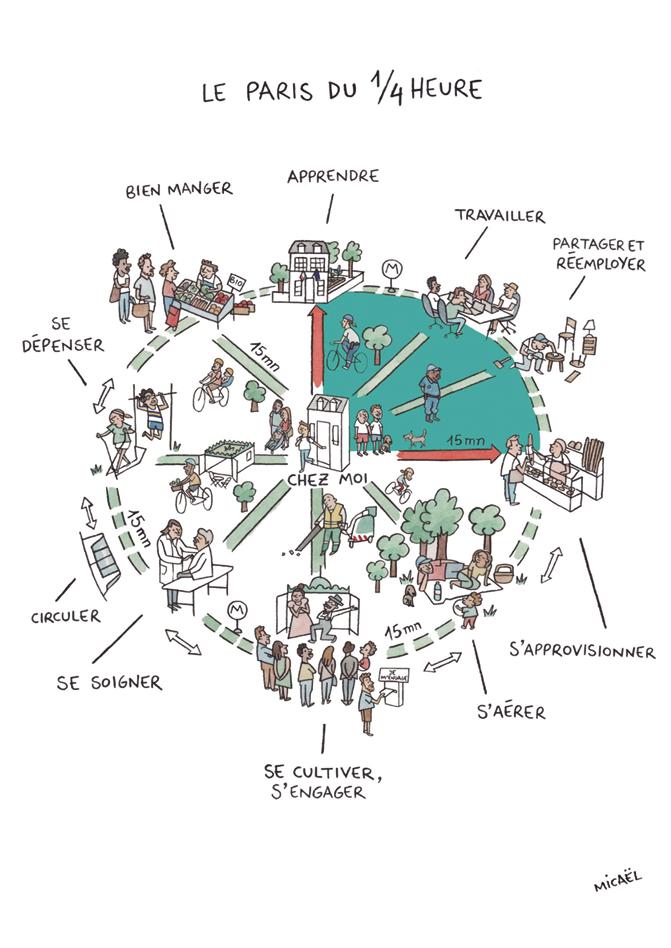
62 OTWO 27 / OCTOBER 2021 OTWO 27 / OCTOBER 2021 63

dius, we are more likely to have the possibility to reduce our daily speed, our personal rhythm, and at the same time gain time for personal enjoyment. This urban configuration based on neighborhood life makes us have the work, school, commerce, health center, park and recreational activity area at about 500 m to be able to access without the need of a motorized vehicle.
What are active cities?
The active city, therefore, will be one that will allow us a healthy lifestyle for the simple reason of living in it and without being forced to devote additional time to cover this need for sport or physical activity as a complement to our daily routine or as part of an established schedule. In this way we can consider the recommendations of the WHO itself to consider whether a city can be considered active or not for all the citizens who live there, from the youngest to the oldest. Thus, we can consider whether the city allows children to play and access public space without any limitation or risk. Or also the movement to the school or educational center in an autonomous way.
It should also offer young people the possibility of having meeting points and comfortable stays, offering active leisure possibilities with activities according to their demands. These can be more urban practices such as skateboarding, parkour or calisthenics. In view of a generational issue, it should also allow the diversity of activities oriented to all student groups in these stages prior to the routine of professional activity.
From the perspective of adults, and considering their professional activity, we find commuting to work as a primary activity in the city itself, which should be oriented towards active mobility and reduce dependence on motor vehicles as much as possible, leaving it only for strictly necessary journeys in the daily dynamics. In this case, the city should encourage and invite walking, cycling, or combined with personal mobility vehicles and especially with public transport.
In addition, of course this active city must include and meet the demands of the elderly, based on their time availability with places and active possibilities available throughout the day and in an area of proximity to their place of residence. Walking or strolling to attend to their daily chores should be complemented with places to stay and rest such as benches and
canzar las necesidades profesionales o mejor dicho consumidores. Ponemos de ejemplo el fenómeno de la ciudad de 15 minutos que plantea Carlos Moreno, profesor en la Universidad Sorbona, para la ciudad de París a partir de esa visión del crono urbanismo. A una ciudad más compacta, más próxima tal como indica con todas las necesidades diarias cubiertas en un radio de 15 minutos, es más probable que tengamos la posibilidad de reducir nuestra velocidad diaria, nuestro ritmo personal, y a la vez ganar tiempo para disfrute personal. Esta configuración urbana basada en la vida de barrio nos hace tener el trabajo el colegio el comercio el centro de salud el parque y la zona de actividad lúdica a unos 500 m para poder acceder sin necesidad del vehículo motorizado.
¿Qué son las ciudades activas?
La ciudad activa por tanto, será aquella que nos va a permitir un estilo de vida saludable por el simple motivo de vivir en ella y sin vernos obligados a dedicar tiempo complementario a cubrir esta necesidad de realizar deporte o actividad física como complemento a nuestra rutina diaria o como dentro de un horario establecido. De este modo podemos considerar las recomendaciones de la propia OMS para plantearnos si una ciudad se puede considerar activa o no para todos los ciudadanos que lo habitan, desde los más pequeños hasta los más mayores. Plantear así si la ciudad permite el juego a los niños y el acceso al espacio público sin limitación ni riesgo alguno. O también el desplazamiento al colegio o centro educativo de un modo autónomo. También que ofrezca a los jóvenes la posibilidad de tener puntos de encuentro y estancias confortables, ofreciendo posibilidades activas de ocio con actividades acordes a sus demandas. Estas pueden ser prácticas más urbanas como el skate, el parkour o la calistenia. Atendiendo a una cuestión generacional también debería permitir la diversidad de actividades orientadas a todos los colectivos estudiantes en estas etapas previas a la rutina por la actividad profesional.
Desde la perspectiva de los adultos, y considerando su actividad profesional, encontramos el desplazamiento al trabajo como una actividad primordial en la propia ciudad y que debería orientarse hacia la
OTWO 27 / OCTOBER 2021 65 64 OTWO 27 / OCTOBER 2021
squares together with active points (with gymnastics elements that allow joint mobility and toning) and generational interaction where they can exercise or participate with other age groups favoring social relations and mental activity.
How is an active city configured?
In the book Cities for People, Jan Gehl talks about some of the conditions that will allow the urban adaptation or configuration of the city to the real needs of the people who live there. Concepts such as accessibility, proximity, quality, continuity and comfort will become necessary and will have to be implemented from a human scale, not from the perspective of the motorized vehicle or logistics as happens in many cities.
Trying to summarize these, we will define the following concepts from an active mobility perspective, or what could be considered the user’s vision to interact in an active way with their environment:
Accessibility, as facilitating access to its use, also considering the whole question of normative accessibility but truly allowing it to be used by anyone. We cannot consider a park as a space for walking and shortcutting a route if that space has an opening time after the morning transit to the workplace.
Proximity, the availability and the availability of being able to take that option, whether it is a pedestrian route or a bicycle lane. In some cities, there is a cycling infrastructure along the waterfront or riverfront, but to reach it or to get to the destination, it is necessary to travel further than necessary. Numerous studies show, in the case of proximity to parks and green areas, improvements in the health of residents in the immediate environment, considering the access on foot or by bike within a few minutes.
Continuity, fundamental in the decision to change habits. It can lead to a question of hierarchy or priority in the journey. It is difficult to attract drivers if the same vision for active modes is not considered as the preferential vision given to motorized vehicles. From the urban design itself, where there are no constant stops and jumps from one side of the road to the other, to the recognition of people who do not go by car with specific signage: traffic lights with bike silhouette, distance to the destination or main point of interest, pedestrian crossings or bike crossings highlighted and
una movilidad activa y se reduzca en todo lo posible Ia dependencia del vehículo motorizado, quedando este solo para desplazamientos estrictamente necesarios en la dinámica diaria. En este caso, la ciudad debería fomentar e invitar a desplazamientos andando, en bicicleta, o combinados con vehículos de movilidad personal y sobre todo con transporte público. Y por supuesto esta ciudad activa debe incluir y atender las demandas de los mayores, basadas en su disponibilidad horaria con lugares y posibilidades activas dispuestas durante todo el día y en un ámbito de proximidad a su lugar de residencia. El paseo o caminar para atender sus labores diarias debería complementarse con puntos de estancia y descanso como puede ser bancos y plazas junto con puntos activos (con elementos de gimnasia que permitan la movilidad articular y la tonificación) y la interacción generacional donde puedan ejercitarse o participar con otros grupos de edad favoraciendo las relaciones sociales y la actividad mental.
¿cómo se configura una ciudad activa?
En el libro Ciudades para la gente, Jan Gehl nos habla de algunos condicionantes que van a permitir la adaptación urbana o configuración de la ciudad a las necesidades reales de las personas que lo habitan. Conceptos como accesibilidad, proximidad, calidad, continuidad y confort se harán necesarios y se tendrán que implantar desde una escala humana, no desde la perspectiva del vehículo motorizado o la logística como sucede en muchas de las ciudades.
Intentando resumir estos, definiremos los siguientes conceptos desde una perspectiva de la movilidad activa, o lo que podría considerarse la visión del usuario para interactuar de un modo activo con su entorno:
Accesibilidad, como facilitación del acceso a su uso, considerando también toda la cuestión de accesibilidad normativa pero que permita verdaderamente ser usado por cualquier persona. No podemos considerar un parque como espacio para caminar y atajar una ruta si ese espacio tiene un horario de apertura posterior al tránsito matinal hacia el lugar de trabajo.
Proximidad, la cercanía y la disponibilidad de poder tomar esa opción, bien sea un itinerario peatonal, o un carril bici. Se da el caso en algunas ciuda-

66 OTWO 27 / OCTOBER 2021 OTWO 27 / OCTOBER 2021 67


well signposted. In short, continuity should be designed to make the route as direct as possible between the starting point and the destination.
Infrastructure comfort. Streets and pedestrian spaces that truly allow walking in all its forms, or cycle paths without elements or irregularities that hinder bicycle traffic.
Quality of the environment in general. Friendly and pleasant spaces that facilitate and invite from an integrated design of the infrastructure in the urban landscape that houses it. Sometimes you can see how these infrastructures themselves are the ones that provide quality to that space.
What would be some models of active cities?
We could give many examples that to some extent will cover this idea of active city, some being more or less complete in each of the areas, but perhaps it is best to identify some cities as a reference in at least some of the aspects that will condition this model or type of city.
From the pedestrian aspect we have Pontevedra as a world reference.
The strict traffic limitation in the historic center of the city, which covers practically the entirety of the city, makes Pontevedra an optimal enclave for pedestrian travel due to its orography and its proximity, being a small and comfortable city on a small scale. A city connected by pedestrian corridors, as can be seen in the image of the “metrominute” invented by them, which also applies a strict policy towards access by car and where the road hierarchy places the pedestrian above any other mode of travel. Its head, Miguel Anxo Fernandez, is increasingly known for expressions that affirm his position: “as mayor, I have no obligation to find a place for anyone to park their car”, expressed recently at the Ciudades que Caminan congress held in Cadiz, 2020. The effect of such policies has led this city not only to be awarded several international prizes and recognitions, in addition to being a benchmark in urban policy, but it has also seen its pollution levels reduced by 70% and deaths in urban accidents have practically disappeared thanks to the decrease in speed (Source: Diario Público 14/12/2016).
For cycling mobility we are going to base ourselves on the ranking of cycling cities where Copenhagen is
des que muestran una infraestructura ciclista junto al frente marítimo o fluvial pero para alcanzar esta o para llegar al destino es necesario un recorrido mayor que el propiamente necesario. Numerosos estudios demuestran, en el caso de la proximidad a parques y zonas verdes, mejoras en la salud de los residentes en ese entorno próximo, considerando el acceso a pie o en bici a pocos minutos.
Continuidad, fundamental en la toma de decisión frente al cambio de hábitos. Se puede llevar a una cuestión de jerarquización o prioridad en el trayecto. Difícilmente se consigue atraer a personas conductoras si no se considera la misma visión para los modos activos que la visión preferente que se dispone a los vehículos motorizados. Desde el propio diseño urbano, donde no existan paradas constantes y saltos de un lado a otro de la vía, hasta el reconocimiento a las personas que no van en coche con una señalética específica: semáforos con silueta de bici, distancia hacia el destino o punto de interés principal, pasos de peatones o cruces de bici resaltados y bien señalizados. En resumen, la continuidad debe plantearse pensando en hacer el trayecto lo más directo posible entre el punto de partida y el destino. Confort de la infraestructura, comodidad y no ser un espacio residual respecto a la vía del tráfico de vehículos. Calles o espacios peatonales que verdaderamente permitan caminar en todas sus formas, o vías ciclistas sin elementos o irregularidades que dificultan el tránsito en bici, ya sea desde un ancho óptimo para la circulación de una bicicleta frente a otra o la sensación de seguridad en la misma frente a otros vehículos.
Calidad del entorno en general. Espacios amables y agradables que faciliten e inviten desde un diseño integrado de la infraestructura en el propio paisaje urbano que la alberga. En ocasiones se pueden ver como estas propias infraestructuras son las que dotan de calidad a ese espacio.
¿Cuáles serían algunos modelos de ciudades activas?
Podríamos plantear muchos ejemplos que en cierta medida van a cubrir esta idea de ciudad activa siendo algunas más o menos completas en cada una de las áreas pero quizás lo mejor sea identificar algunas ciudades por su condición de referente al
68 OTWO 27 / OCTOBER 2021 OTWO 27 / OCTOBER 2021 69

identified as the most cyclable city on the planet. This recognition comes from the perspective of the urban bicycle user and its mobility possibilities, comfort from an extensive network of bike lanes that allows the connection of points of interest, always with the preference and accessibility by bike. All accompanied by comprehensive policies that encourage and facilitate its use to any person and interest group, either to cycle to work, do sports, go shopping or any purpose, without the need to use the car. In addition, it is driven by a new international image of the city linked to sustainability through being the new benchmark in urban cycling.
As access to the game we find many cities listed as child-friendly, also another network is called Playful Cities. We could say that we will find play spaces in any city. But perhaps we should recognize one where the new legislation is oriented to child participation and public policies, or more interestingly, where there is some document of organization and recognition of play as a fundamental right. And not strictly we refer to children’s play, trivialized on many occasions by local authorities by placing a simple “hopscotch” to justify the appearance and need for all children, but to a fun and playable city in all its dimensions and corners. For this reason we must recognize Barcelona’s bet with a Plan for Play in Public Space, with which it recovers the possibility of playing with a ball in the street (a prohibition that remains in many cities), running through public places or simply enabling creativity and inclusion to young people in spaces where until
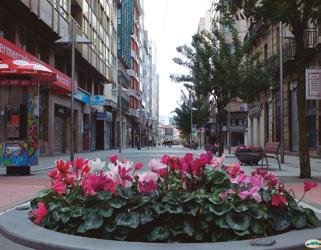
menos en alguno de esos aspectos que van a condicionar este modelo o tipo de ciudad
Desde lo peatonal tenemos a Pontevedra como referente mundial
La limitación de tráfico estricta en el casco histórico de la ciudad que abarca prácticamente la totalidad de esta hace de Pontevedra un enclave óptimo para los desplazamientos a pie acompañado por su orografía y su proximidad al ser una ciudad de una escala pequeña y cómoda. Una ciudad conectada por corredores peatonales, como se puede apreciar en la imagen del “metrominuto” inventado por ellos, que además aplica una política estricta hacia el acceso en coche y donde la jerarquía viaria sitúa al peatón por encima de cualquier otro modo de desplazamiento. Su responsable, Miguel Anxo Fernandez, es cada vez más conocido por expresiones que afirman su postura: “como alcalde, no tengo la obligación de buscarle a nadie donde aparcar su coche”, expresada recientemente en el congreso Ciudades que Caminan celebrado en Cádiz, 2020. El efecto de tales políticas ha llevado a esta ciudad no sólo a ser galardonada con varios premios y reconocimientos internacionales, además de ser un referente en política urbana, sino que ha visto reducidos sus niveles de contaminación un 70% y han desaparecido prácticamente los fallecidos en accidentes urbanos gracias a la disminución de la velocidad (Fuente: Diario Público 14/12/2016).
Para la movilidad en bici nos vamos a basar en el ranking de ciudades ciclistas donde se identifica a

recently they had vetoed access, without the need to have a written rule for this.
The example of a current physical activity and sports policy, based on practice in the urban environment, is perhaps most relevant in the case of London. With the aim of making the city the most active in the world, the government offers Londoners a range of spaces and opportunities to promote an active society, based on daily practice and healthy habits that enable them to live better lives. The local sports department itself explains the Urban Sport strategy: “it is the concept of maximizing an urban environment to allow people to be physically active, whether it is a fitness session in a green space, skating in an empty parking lot or simply throwing a ball in the space between a block of apartments”.
As a city with green spaces and access to parks, Curitiba is perhaps the benchmark for the percentage of green areas per inhabitant, which is one of the highest in the world, leading to the parallel development of numerous public programs of activities in parks as active meeting spaces for citizens, always in a green environment. The city’s great commitment to green areas translates into the existence of more than 64m2 of green space per inhabitant, distributed in more than 30 parks and gardens that are fully accessible by public transport for any citizen and visitor to the city. These figures multiply the WHO’s own recommendations that place between 9 and 11m2 as the ideal for these to generate an adequate impact on the heal-

Copenhague como la ciudad más ciclable del planeta. Este reconocimiento viene desde la perspectiva del usuario en bicicleta urbana y sus posibilidades de movilidad, comodidad a partir de una extensa red de carril bici que permite la conexión de puntos de interés, siempre con la preferencia y accesibilidad en bici. Todo acompañado de completas políticas que fomentan y facilitan su uso a cualquier persona y grupo de interés, ya sea para ir en bici al trabajo, hacer deporte, ir de compras o cualquier propósito, sin necesidad de recurrir al coche. Además, se impulsa con una nueva imagen internacional de la ciudad vinculada a lo sostenible a través de ser ese nuevo referente en ciclismo urbano. Como acceso al juego encontramos muchas ciudades catalogadas como amigas de la infancia, también otra red se denomina Playful Cities. Podríamos decir que espacios de juego vamos a encontrar en cierta manera en cualquier ciudad. Pero quizás hay que reconocer alguna donde la nueva legislación esté orientada a la participación infantil y las políticas públicas, o más interesante aún, donde exista algún documento de organización y reconocimiento del juego como un derecho fundamental. Y no estrictamente nos referimos al juego de los niños, banalizado en muchas ocasiones por las autoridades locales al colocar una simple “rayuela” para justificar el aspecto y necesidad de toda la infancia, sino a una ciudad divertida y jugable en todas sus dimensiones y rincones. Por este motivo debemos reconocer que la apuesta de Barcelona con un Plan de Juego en el
OTWO 27 / OCTOBER 2021 71 70 OTWO 27 / OCTOBER 2021
th of residents, always considering an adequate distribution and proximity to them.
For the quality of public space, services and strategy as a whole, Mediterranean cities historically could be a reference, although this aspect has been invaded by tourism. On the other hand, we see how many European and mainly Nordic cities, mainly due to the need to make the most of the few hours of sunshine available, offer a high quality of meeting spaces and activity from its urban design. But undoubtedly a reference city in its global strategy on the intervention in all these aspects together could be Vancouver. From a sustainability perspective, the capital aims to be the greenest city in the world in this decade and the way to achieve it has been the commitment to alternative mobility to the car. Thus, more than 50% of its inhabitants have opted to travel on foot, by bike or by public transport. This combination not only reduces emissions and energy consumption, but also keeps most of the city’s citizens active during their daily commute. In addition, the 450km of bike lanes and the accessibility of public transport means that tourists can move around the city without the need for a car. If we add to this the progress in green spaces and areas, the possibilities and proposals to develop ecological practices increase and encourage an active and sustainable collective culture that is transmitted socially.
In summary, and as a prelude to delve deeper into each of these aspects that will allow us to “activate” cities, we must differentiate between these recipes or ephemeral “training” plans, as if it were a bikini operation, and direct local policies towards changing dynamics and building healthy habits and routines based on active environments. At a general level, it would not be possible to accommodate the entire population in a gym room at the same time, which makes us think that the real social promotion of sport and physical activity involves facilitating and providing the city with active spaces from its streets, promenades, squares or parks, in a balanced way and allowing any respectful practice to any citizen, without prioritizing before these places to sit and consume, as an excuse for pedestrianization and transformations with the sustainable label.
Espacio Público, con el que recupera la posibilidad de jugar con una pelota en la calle (prohibición que se mantiene en muchas ciudades), correr por lugares públicos o simplemente posibilitando la creatividad y la inclusión a jóvenes en espacios donde hasta hace muy poco tenían el acceso vetado, sin necesidad de tener una norma escrita para esto.
El ejemplo de una política de actividad física y deporte actual, basada en la práctica en el medio urbano, quizá sea el caso de Londres el que cobra mayor relevancia. Con el propósito de convertir la ciudad en la más activa del mundo, el gobierno plantea a los londinenses una oferta de espacios y posibilidades para impulsar una sociedad activa, basada en la práctica diaria y en los hábitos saludables que permitan vivir mejor. Desde el propio área de deporte local se explica la estrategia Urban Sport: “es el concepto de maximizar un entorno urbano para permitir que las personas estén físicamente activas, ya sea una sesión de fitness en un espacio verde, patinar en un estacionamiento vacío o simplemente lanzar una pelota en el espacio entre un bloque de pisos”. Como ciudad con espacios verdes y de acceso a parques quizá el referente sea Curitiba por el porcentaje de zonas verdes por habitante que presenta uno de los mayores del mundo esto hace que se desarrolle de forma paralela numerosos programas públicos de actividades en parques como espacios activos de encuentro para la ciudadanía siempre en un entorno verde. La gran apuesta de la ciudad por las zonas verdes se traduce en la existencia de más de 64m2 de espacio verde por habitante, distribuídos en más de 30 parques y jardines que son completamente accesibles en transporte público para cualquier ciudadano y visitante de la ciudad. Estas cifras multiplican las recomendaciones de la propia OMS que sitúan entre 9 y 11m2 lo ideal para que estas generen un impacto adecuado en la salud de los residentes, considerando siempre una distribución adecuada y de proximidad a estos.
Por la calidad del espacio público, los servicios y la estrategia en conjunto, las ciudades mediterráneas históricamente pudieron ser un referente, aunque este aspecto ha sido invadido por la actividad turística. En cambio vemos como muchas ciudades europeas y principalmente nórdicas, debido sobre todo a la necesidad de aprovechar al máximo las


72 OTWO 27 / OCTOBER 2021 73 OTWO 27 / OCTOBER 2021

pocas horas de sol que dispone, ofrecen una gran calidad de espacios de encuentro de estancia y de actividad a partir de su diseño urbano. Pero sin duda una ciudad referente en su estrategia global sobre la intervención en todos estos aspectos de forma conjunta podría ser Vancouver. Desde una perspectiva de sostenibilidad, la capital pretende ser la ciudad más verde del mundo en esta década y el camino para lograrlo ha sido la apuesta por una movilidad alternativa al coche. De este modo, ha conseguido que más del 50% de sus habitantes apuesten por desplazarse a pie, en bici o en transporte público. Esta combinación no sólo permite una reducción de sus emisiones y un menor consumo energético sino que mantiene en activo a la mayor parte de sus ciudadanos mediante los desplazamientos diarios. Además, los 450 km de carriles bici y la accesibilidad al transporte público hace que el turista pueda moverse por la ciudad sin necesidad de coche. Si a esto le sumamos el progreso en espacios y zonas verdes, las posibilidades y propuestas para desarrollar prácticas ecológicas aumentan y fomentan una cultura colectiva activa y sostenible que se transmite socialmente.
En resumen y sirviendo de antesala para poder profundizar detenidamente en cada una de estas vertientes que nos van a permitir la “activación” de las ciudades, debemos diferenciar entre esas recetas o planes efímeros de “entrenamiento”, como si de una operación bikini se tratase, y dirigir las políticas locales hacia el cambio de dinámicas y la construcción de hábitos y rutinas saludables basadas en entornos activos. A nivel general, no sería posible albergar a toda la población en una sala de gimnasio a la misma hora lo que hace pensar que la verdadera promoción social del deporte y la actividad física pasa por facilitar y dotar la ciudad de espacios activos a partir de sus calles, paseos, plazas o parques, de un modo equilibrado y que permitan cualquier práctica respetuosa a cualquier ciudadano, sin priorizar ante estos los lugares para sentarse y consumir, como excusa para las peatonalizaciones y transformaciones con la etiqueta sostenible.
OTWO 27 / OCTOBER 2021 75 74 OTWO 27 / OCTOBER 2021
We´re raising £10,000
to restore and renovate historical sights around Gibraltar
Whilst there is a rich history of defence on the Rock of Gibraltar there is no one organisation that takes responsibility for the upkeep of the various guns and other military positions.
It is my mission to do my best to restore, renovate and refurbish as many of these sights as possible to ensure our heritage and history is not lost to neglect.
This has been a completely voluntary project which has recieved minimum adhoc funding. Any donations will go towards the purchasing of the necessary materials and equipment to continue this project.
COLLABORATE IN THIS LINK:
https://www.justgiving.com/crowdfunding/rachael-jackson-904?utm_term=AGy2zwmZ9--




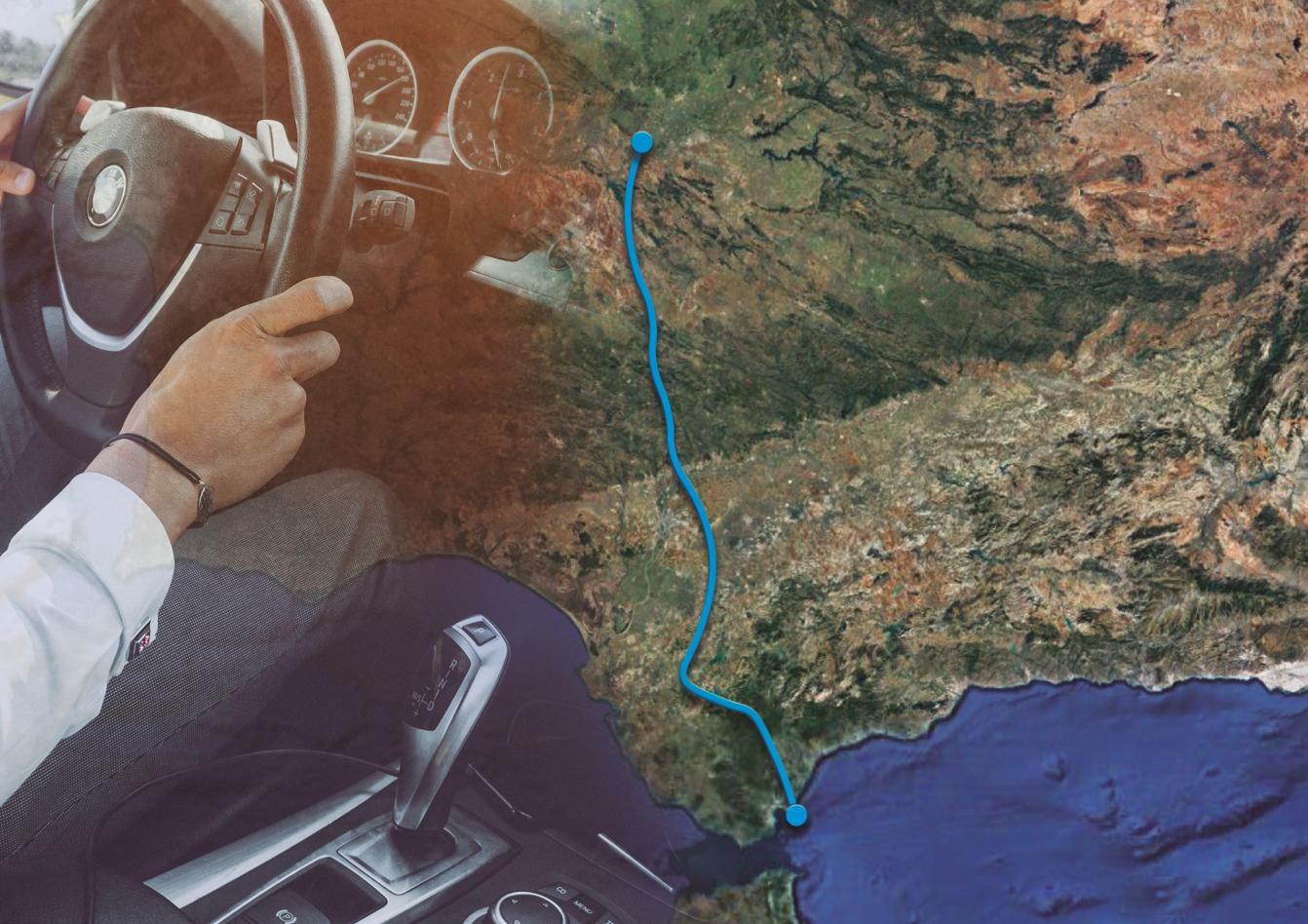
STRETCH 1
Gibraltar-Mérida
OTWO 27 / OCTOBER 2021 79 78 OTWO 27 / OCTOBER 2021
Text and photos: Anthony Pitaluga
August, Summer of 2021.
After more than a year of pandemic related restrictions and uncertainties, we decided to undertake a road-trip through regions of interest within Spain and France. Originally planned in 2019, for the summer of 2020, our long awaited road-trip was finally about to begin.
We left Gibraltar on the first day of our road-trip on Friday 6th of August, at about ten in the morning. There was little in the way of clouds. A light westerly breeze and an inviting wall-to-wall blue firmament was the delightful meteorology that hosted our departure from Gibraltar.
Originally, in 2019, our plan revolved on us heading northwest to the autonomous community of Galicia. With two weeks ahead of us, we decided to keep to our original plan— motoring northwest to explore and experience Galicia.
Mérida, 385 Kilometres north-west of Gibraltar, was the destination of choice of the first leg towards Galicia. We entered Spain via La Linea de la Concepcion. Quick out of our neighbouring town, we took the E15 roadway past the Roman enclave of Carteia, San Roque. An important archaeological site, Carteia dates from the 7th century BCE, and includes remains from the Phoenician, Carthaginian, Roman, Visigoth, Byzantine, Moorish and Christian eras. The E15 or Ruta del Toro, continues through Los Barrios to Jerez, across Los Alcornocales Natural Park, in the autonomous community of Andalusia. Just out of Jerez, Ruta del Toro intersects with motorway Del Sur (A-4) that links Seville and Cadiz. The A-4, is also known as the “Highway of Cadiz” or “Highway of Seville”.
The A4 to Seville, runs roughly parallel to the west of the mighty Guadalquivir River, that flows towards the great Andalusian cities of Seville and Cordoba. From Seville, we took the A66, Autovía Ruta de La Plata, and north towards Mérida. The A66 is a major highway upgrade of the old N630. The route roughly corresponds to the ancient Roman ‘Silver Route’, that linked the cities of Mérida and Astorga, at the crossroads of the Camino de Santiago.
Soon out of Seville, the A66 enters very dry terrain, initiating a slight ascent on its way towards a remote area of mountains, forests, lakes, and reserve—Extremadura. A western region, Extre-
Agosto, verano de 2021.
Tras más de un año de restricciones e incertidumbres relacionadas con la pandemia, decidimos emprender un viaje por carretera a través de regiones de interés dentro de España y Francia. Planeado originalmente en 2019, para el verano de 2020, nuestro tan esperado viaje por carretera estaba por fin a punto de comenzar.
Salimos de Gibraltar el primer día de nuestro viaje por carretera, el viernes 6 de agosto, hacia las diez de la mañana. Había pocas nubes. Una ligera brisa del oeste y un atractivo firmamento azul de pared a pared fue la deliciosa meteorología que acogió nuestra salida de Gibraltar.
Originalmente, en 2019, nuestro plan giraba en torno a que nos dirigiéramos al noroeste, a la comunidad autónoma de Galicia. Con dos semanas por delante, decidimos mantener nuestro plan original: ir hacia el noroeste para explorar y experimentar Galicia.
Mérida, a 385 kilómetros al noroeste de Gibraltar, fue el destino elegido para la primera etapa hacia Galicia. Entramos en España por la Línea de la Concepción. Saliendo rápidamente de nuestra ciudad vecina, tomamos la carretera E15 pasando por el enclave romano de Carteia, en San Roque. Importante yacimiento arqueológico, Carteia data del siglo VII a.C., e incluye restos de las épocas fenicia, cartaginesa, romana, visigoda, bizantina, árabe y cristiana. La E15 o Ruta del Toro, continúa por Los Barrios hasta Jerez, atravesando el Parque Natural de los Alcornocales, en la comunidad autónoma de Andalucía. A la salida de Jerez, la Ruta del Toro se cruza con la autopista del Sur (A-4) que une Sevilla y Cádiz. La A-4, es también conocida como «Autopista de Cádiz» o «Autopista de Sevilla».
La A4 a Sevilla, discurre aproximadamente paralela al oeste del caudaloso río Guadalquivir, que fluye hacia las grandes ciudades andaluzas de Sevilla y Córdoba. Desde Sevilla, tomamos la A66, Autovía Ruta de La Plata, y al norte hacia Mérida. La A66 es una mejora de la antigua N630. La ruta corresponde aproximadamente a la antigua «Vía de la Plata» romana, que unía las ciudades de Mérida y Astorga, en el cruce del Camino de Santiago.
Al poco de salir de Sevilla, la A66 se adentra en un terreno muy árido, iniciando un ligero ascenso hacia una region remota de montaña, bosque, la-
madura bordering Portugal to the west, comprises the provinces of Cáceres and Badajoz. At this time of the year, this region is the hottest and driest in Europe, colloquially known as the Oven of Europe. Summer temperatures soar, easily rising well above 40 degrees Celsius. This powerful, incessant, baking sun, cooks up everything under its all-encompassing thermal influence, with totalitarian urgency, without compassion. Like a blast furnace in an enclosed ironworks, forcibly burning, painting out with a hot brush, striking tones of pale yellow with shades of almost cindered-ash grey, onto the vast area of open landscape beneath.
We continued ascending towards Mérida, entering a mountainous region where the green of the tree crowns contrasted sharply against the tones of pale-yellow exhibited by the dry terrain.
At 1 o’clock in the afternoon, we recorded an ambient temperature of 35 degrees Celsius.
Continuing north, the road runs past Monesterio, a municipality in the province of Badajoz, and onto Almendralejo where we stopped for lunch. Almendralejo is a town in the Province of Badajoz, Extremadura. Situated 45 km southeast of Badajoz, on the main road and rail route between Mérida 35 km away, and Seville. Almendralejo was the site of a battle and massacre during the Spanish Civil War in 1936. Lunch at Almendralejo was great…potatoes, peppers and grapes from the local area. After exploring Almendralejo including the Civil War site, We drove the final distance into the city of Mé-
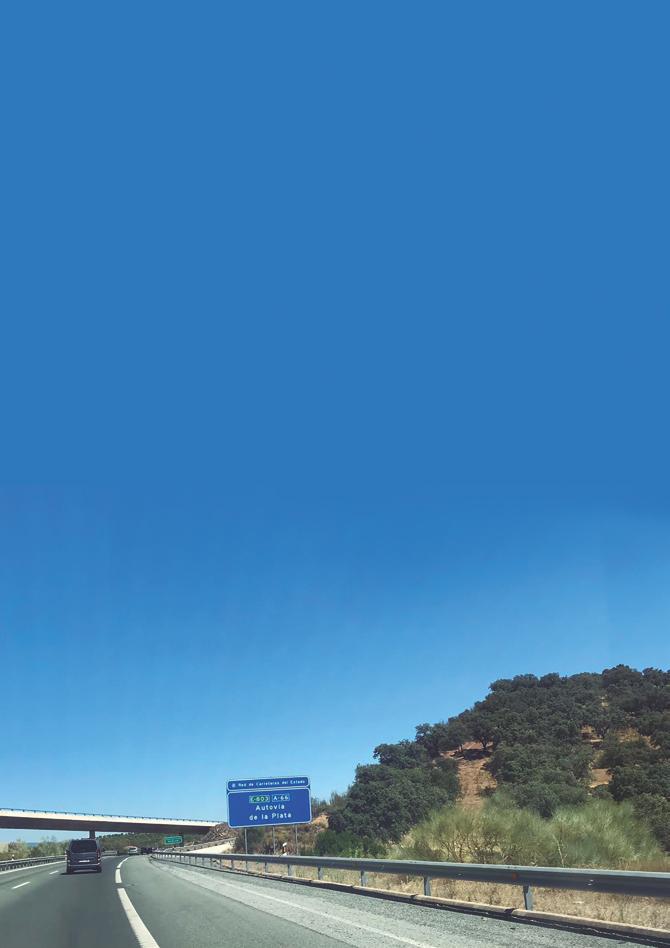
gos y reserva- Extremadura.. Una región occidental, Extremadura, que limita con Portugal por el oeste, comprende las provincias de Cáceres y Badajoz. En esta época del año, esta región es la más calurosa y seca de Europa, conocida coloquialmente como el Horno de Europa. Las temperaturas veraniegas se disparan, superando fácilmente los 40 grados centígrados. Este sol poderoso, incesante y abrasador, lo cuece todo bajo su omnipresente influencia térmica, con una urgencia totalitaria, sin compasión. Como un alto horno en una ferrería cerrada, quemando a la fuerza, pintando con un pincel caliente, tonos llamativos de amarillo pálido con matices de gris ceniza casi, sobre la vasta zona de paisaje abierto que hay debajo.
Seguimos ascendiendo hacia Mérida, adentrándonos en una región montañosa en la que el verde de las copas de los árboles contrastaba fuertemente con los tonos de amarillo pálido que exhibía el terreno seco.
A la 1 de la tarde, registramos una temperatura ambiente de 35 grados.
Siguiendo hacia el norte, la carretera pasa por Monesterio, un municipio de la provincia de Badajoz, y llega a Almendralejo, donde paramos a comer. Almendralejo es un pueblo de la provincia de Badajoz, Extremadura. Se encuentra a 45 km al sureste de Badajoz, en la ruta principal de carretera y ferrocarril entre Mérida, a 35 km, y Sevilla. Almendralejo fue escenario de una batalla y una masacre durante la Guerra Civil española en 1936. El almuerzo en Al-
80 OTWO 27 / OCTOBER 2021 OTWO 27 / OCTOBER 2021 81

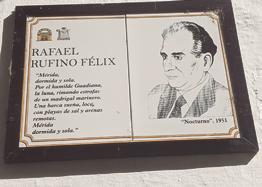
rida, arriving at Hotel Mérida Palace, our refuge for the night at about four that afternoon.
Founded by the Romans in the 1st century BCE, Mérida is the capital of Extremadura and UNESCO World Heritage city since 1993.
Important remains of the ancient city include the functioning Roman theatre (Teatro Romano), the ancient Roman bridge (Puente Romano), the Islamic Fortress (Alcazaba), the Trajano Arch (Arco de Trajano), Diana’s temple (Templo de Diana) and the Roman aqueducts (Acueductos) de San Lazaro y de Los Milagros.
After quick refreshments at a cafeteria at Plaza de España, the city’s main square, we made our way to the ancient Roman Bridge
mendralejo fue estupendo... patatas, pimientos y uvas de la zona. Después de explorerar Amendralejo incluyendo el sitio de la Guerra Civil, Recorrimos la última distancia hasta la ciudad de Mérida y llegamos al Hotel Mérida Palace, nuestro refugio para la noche, a eso de las cuatro de la tarde.
Fundada por los romanos en el siglo I a.C., Mérida es la capital de Extremadura y ciudad Patrimonio de la Humanidad de la UNESCO desde 1993. Entre los restos importantes de la ciudad antigua se encuentran el Teatro Romano en funcionamiento, el antiguo Puente Romano, la Alcazaba, el Arco de Trajano, el Templo de Diana y los acueductos romanos de San Lázaro y de Los Milagros.
Después de un rápido refrigerio en una cafetería de la Plaza de España, la plaza principal de la ciudad, nos dirigimos al antiguo Puente Romano, en el perímetro de la ciudad. Nos había maravillado esta magnífica estructura cuando llegamos a primera hora de la tarde.
Puente Romano sobre el río Guadiana, da acceso a una de las cuatro puertas principales de la antigua ciudadela romana, aún visible en la actualidad.
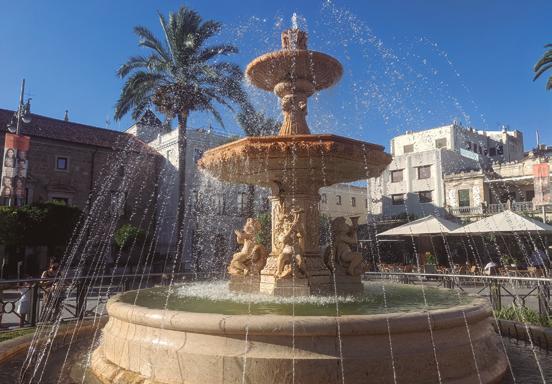
OTWO 27 / OCTOBER 2021 83 82 OTWO 27 / OCTOBER 2021
on the city’s perimeter. We had marvelled at this magnificent structure when we arrived earlier that afternoon.
Puente Romano sobre el rio Guadiana, provides access to one of the four main gates to the ancient Roman citadel, still visible today.
The bridge spans 762 metres and preserves an intact Roman Factory at both ends. The design was determined by the width of the river, and importantly by swells of up to four metres. Located upstream to mitigate the swells, semi-circular cutwaters were installed to divert the flows. The Romans used the bridge to travel to Betica (Andalusia) or Olisipo (Lisbon).
Annexed to the Roman bridge is the Alcazaba (Fortress) of Mérida, a Moorish fortification built in 835 CE. During the Arab era, Abderraman II ordered the construction of the Alcazaba, to install his army and thus control the persistent revolts in the city. The Alcazaba sits under the bridge gate, and beside part of the wall in the enclosure where the Alcazarejo is located. The Alcazarejo allowed control access to the city from the bridge. On the main gate leading into the Alcazaba there is an inscription that protected the followers of Alha, and those who obeyed the Emir.
The Mérida Alcazaba site is impressive—well worth visiting. Access to the complex is through a gap that formerly housed a section of wall, with an access door flanked by towers on either side. This was the entryway to a square stronghold whose eastern side gave access to the city, and whose southern side provided access to the Alcazaba.
To escape the fierce sun belting down on the Alcazaba site, we walked back into the relative cool of the city centre, on our way to the Trajano Arch (Arco de Trajano), and Diana’s temple (Templo de Diana).
The Trajano Arch is located on a street with the same name behind la Plaza de España.
There are references to houses on this site that date back to the Augusta Emerita, also called Emerita Augusta, a Roman colony (Colonia) that dates from about 25 BCE. Many years later, during the government of Tiberius 14-34 CE, the houses were demolished. A monumental ensemble, dedicated to the cult of the emperor, was constructed were the houses once stood. Access to this important ensemble
El puente abarca 762 metros y conserva una fábrica romana intacta en ambos extremos. El diseño vino determinado por la anchura del río, y sobre todo por las marejadas de hasta cuatro metros. Situado aguas arriba para mitigar las marejadas, se instalaron tajamares semicirculares para desviar los flujos. Los romanos utilizaban el puente para viajar a la Bética (Andalucía) o a Olisipo (Lisboa).
Anexa al puente romano se encuentra la Alcazaba de Mérida, una fortificación árabe construida en el año 835. Durante la época árabe, Abderramán II ordenó la construcción de la Alcazaba, para instalar su ejército y controlar así las persistentes revueltas en la ciudad. La Alcazaba se encuentra bajo la puerta del puente y junto a una parte de la muralla del recinto donde se encuentra el Alcazarejo. El Alcazarejo permitía controlar el acceso a la ciudad desde el puente. En la puerta principal que da acceso a la Alcazaba hay una inscripción que protegía a los seguidores de Alha y a los que obedecían al Emir.
El yacimiento de la Alcazaba de Mérida es impresionante y merece la pena visitarlo. El acceso al complejo se realiza a través de un hueco que antiguamente albergaba un tramo de muralla, con una puerta de acceso flanqueada por torres a ambos lados. Era la entrada a una plaza fuerte cuyo lado oriental daba acceso a la ciudad, y cuyo lado sur daba acceso a la Alcazaba.
Para huir del intenso sol que caía sobre el recinto de la Alcazaba, volvimos a la relativa frescura del centro de la ciudad, de camino al Arco de Trajano y al Templo de Diana.
El Arco de Trajano se encuentra en la calle del mismo nombre, detrás de la Plaza de España.
Hay referencias a casas en este lugar que se remontan a la Augusta Emerita, también llamada Emerita Augusta, una colonia romana (Colonia) que data de aproximadamente el año 25 a.C. Muchos años después, durante el gobierno de Tiberio 14-34 EC, las casas fueron demolidas. En el lugar que ocupaban las casas se construyó un conjunto monumental dedicado al culto del emperador. El acceso a este importante conjunto se hacía a través del llamado «Arco de Trajano». Al cruzar el arco en la época romana, los visitantes subían varios escalones y entraban en una gran plaza porticada dominada por un templo, el de Diana. En la época romana, este templo dominaba una


84 OTWO 27 / OCTOBER 2021 OTWO 27 / OCTOBER 2021 85
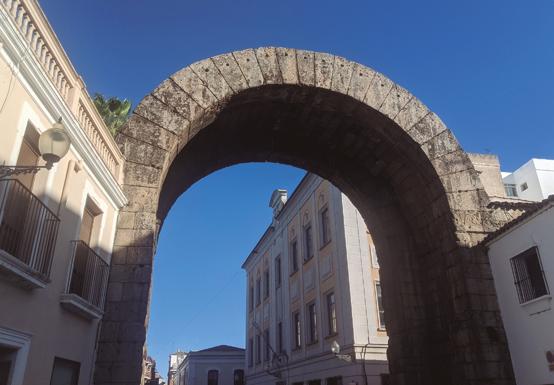

was through the so called ‘Arch of Trajan’. Crossing the Arch during Roman times, visitors would walk up several steps, and enter a big square with porticoes dominated by a temple—Diana’s Temple.
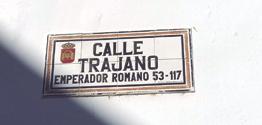
In Roman Times this temple dominated a large square known as the ‘forum of the colony’. Surrounded by important public buildings, the temple was the city centre, the main meeting point of the Augusta Emerita citizens. Political life took place here, justice was administered, financial and commercial transactions were made, and sacrifices were offered to the gods.
The temple was built with local granite covered with plaster. Access was via a monumental stairway, now lost. Popularly known as Diana’s temple since the 17th Century, it is now established that it was dedicated to Rome and the Emperor.
The next site we planned to visit was the Mérida Roman Theatre and Amphitheatre. However, this would have to wait a few hours. Mérida was staging the 67th edition of the Festival Internacional de Teatro Clásico, held at the Roman Theatre.
We had tickets to the musical Golfus de Roma, one of Broadway’s acclaimed brightest musical comedies. Inspired by the works of Plauto “Golfus” … as we were unfortunate enough to discover, Golfus de Roma doesn’t have a single serious moment. With curtain-up at a quarter to eleven, our next move was dinner. We had been given a few suggestions at the hotel as to where best to sample the food of Extremadura. We were not disappointed.
With a full stomach, we walked the short distance to the Roman Theatre and took our places. The show—I suppose some people liked it…
The value of the site is the building itself. The theatre was constructed under Agrippa, son-in-law of Augustus, between the years 16 and 15 BCE. Like the adjacent Amphitheatre building, it was built
gran plaza conocida como el «foro de la colonia». Rodeado de importantes edificios públicos, el templo era el centro de la ciudad, el principal punto de encuentro de los ciudadanos de Augusta Emerita. Aquí se desarrollaba la vida política, se administraba la justicia, se realizaban transacciones financieras y comerciales y se ofrecían sacrificios a los dioses. El templo se construyó con granito local recubierto de yeso. Se accedía a él a través de una escalera monumental, hoy perdida. Conocido popularmente como el templo de Diana desde el siglo XVII, ahora se sabe que estaba dedicado a Roma y al emperador. El siguiente lugar que teníamos previsto visitar era el Teatro y Anfiteatro Romano de Mérida. Sin embargo, esto tendría que esperar unas horas. En Mérida se celebraba la 67ª edición del Festival Internacional de Teatro Clásico en el Teatro Romano. Teníamos entradas para el musical Golfus de Roma, una de las comedias musicales más aclamadas de Broadway e inspirada en la obra de Plauto «Golfus». Como tuvimos la mala suerte de descubrir, Golfus de Roma no tiene ni un solo momento serio. Con el telón levantado a las once menos cuarto, nuestro siguiente paso fue la cena. En el hotel nos habían dado algunas sugerencias sobre los mejores lugares para probar la comida extremeña. No nos decepcionó. Con el estómago lleno, recorrimos la corta distancia que nos separaba del Teatro Romano y ocupamos nuestros puestos. El espectáculo, supongo que a algunos les gustó.
El valor del lugar es el edificio en sí mismo. El teatro se construyó bajo el mandato de Agripa, yerno de Augusto, entre los años 16 y 15 a.C. Al igual que el edificio adyacente del Anfiteatro, se construyó en parte sobre una pendiente, lo que abarató los costes de su cantería. El resto se construyó con hormigón revestido de sillería. El Teatro Romano de Mérida está considerado como un icono cultural español, elegido como uno de los 12 Tesoros de España. Es un teatro en funcionamiento, que se utiliza regularmente en la actualidad.
Los dos últimos lugares que visitamos fueron los Acueductos de San Lázaro y de Los Milagros.
Los acueductos están situados junto a la carretera de salida de la ciudad de Mérida, en su camino hacia la intersección con la autovía Ruta de la Plata, en dirección norte hacia Salamanca, nuestro próximo destino.
86 OTWO 27 / OCTOBER 2021 OTWO 27 / OCTOBER 2021 87
partly on a slope, which lowered the costs of its stonework. The rest was built of concrete lined with ashlar masonry. The Roman Theatre of Mérida is regarded as a Spanish cultural icon, chosen as one of the 12 Treasures of Spain. It is very much a working theatre, regularly used today.
The two final sites we visited were the aqueducts (Acueductos) de San Lazaro y de Los Milagros.
The aqueducts are situated adjacent to the roadway out of Mérida city, on its way towards the intersection with the Ruta de Plata autovia, heading north towards Salamanca, our next destination.
This pair of Roman aqueducts exhibit an excellent state of preservation, especially so ‘Los Milagros’ built during the 1st century, years after the founding of the Augusta Emerita colony. Los Milagros was one of four aqueducts that supplied water to the city. The slender, three tier rows of arches reach a height of 28 metres, built to cross the river Barraeca. The use of rows of bricks stands out in the aqueducts’ construction, used for building purposes rather than aesthetics. It is a wonder to see such magnificence.
We drove past the aqueducts and onto the autovia Ruta de la Plata. Our Mérida leg had ended. We headed North towards the historic World Heritage City of Salamanca, 272 Kilometres away.



Este par de acueductos romanos presentan un excelente estado de conservación, especialmente el de «Los Milagros», construido durante el siglo I, años después de la fundación de la colonia Augusta Emerita. Los Milagros era uno de los cuatro acueductos que suministraban agua a la ciudad. Las esbeltas hileras de arcos de tres pisos alcanzan una altura de 28 metros, construidos para cruzar el río Barraeca. En la construcción de los acueductos destaca el uso de hileras de ladrillos, utilizados con fines constructivos más que estéticos. Es una maravilla ver tal magnificencia.
Pasamos los acueductos y entramos en la autovía Ruta de la Plata. Nuestra etapa en Mérida había terminado. Nos dirigimos al norte, hacia la histórica ciudad de Salamanca, Patrimonio de la Humanidad, a 272 kilómetros.


88 OTWO 27 / OCTOBER 2021 OTWO 27 / OCTOBER 2021 89


Wastage Products Ltd
AquaGib
Monique’s Bistro
Eroski Mas Cafe
O’Reilly’s Jury’s Cafe
Gibraltar Arms
Bridge Bar & Grill
Westside Secondary School
The Lord Nelson
Victoria Stadium Complex
Bistro Point
St Bernard’s Upper Primary School
Alameda Wildlife
Conservation Park (AWCP)
John Mackintosh Hall
Blands Travel
The Star Bar
The Britannia Bar

The Three Owls
Trusted Novus Bank
Paper Cloud
University of Gibraltar
Little English
Europa FC Academy
Domino’s Pizza
Risso’s Daily
Soul Kitchen
Europa Rugby Facilities
SUMMER LIFEGUARD POSTS
Little Bay
Camp Bay
Eastern Beach
Western Beach
Catalan Bay
Sandy Bay
VOLUME 2 / VOLUMEN 2
The fretum herculeum, a universal strait
El fretum herculeum, un estrecho universal
Juanlu González
Article and images

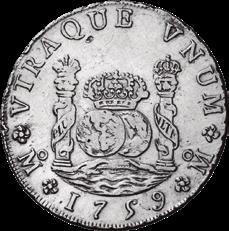
The estrecheños can boast that the representation of the columns of Hercules has become one of the universal icons of all time. Coins, shields, sculptures, paintings, toponymy ... have immortalized in thousands of ways the mythological hero of Tyre gaditanizado, the Mediterranean demigod, to enthroned as an undisputed part of the heritage of humanity. Everyone wanted to be like him or part of him. In the previous chapter of “Strait” we left Juba II, king of the south of the Strait at the beginning of our Era (personally very attached to Gades, of which he is considered a great benefactor), ruling by the grace of Rome in Numidia and Mauretania. If we look at the iconography of his coins, he is represen ted with the lion’s skin on his head, in a clear nod to the Herculean symbolism, a sign of devotion to this character from whom he claimed to descend.
But he was not the only one, Roman em perors also did the same. The bust of the ex travagant emperor Commodus carrying the mace, the feline skin and the apples of the Garden of the Hesperides is well known, it does not lack the slightest detail. Even unknown patricians had themselves depicted like this, it was a kind of fashion of the time associated with virtue, especially in the public and political spheres.
Apparently, the cult and devotion to the character in Rome

Los estrecheños podemos llevar a gala que la representación de las columnas de Hércules se ha convertido en uno de los iconos más universales de todos los tiempos. Monedas, escudos, esculturas, cuadros, toponimia… han inmortalizado de miles de maneras al héroe mitológico de Tiro gaditanizado, al semidiós mediterráneo, hasta entronizarlo como parte indiscutible del patrimonio de la Humanidad.
Todos querían ser como él o parte de él. En el capítulo anterior de «Estrechando» dejamos a Juba II, rey del sur del Estrecho de principios de nuestra Era (muy enganchado personalmente a Gades, de la que se le considera un gran benefactor), gobernando por la gracia de Roma en Numidia y en Mauretania. Si nos fijamos en la iconografía de sus monedas, se representa con la piel de león sobre su cabeza, en un claro guiño a la simbología hercúlea, muestra de la devoción por este personaje del que decía descender.
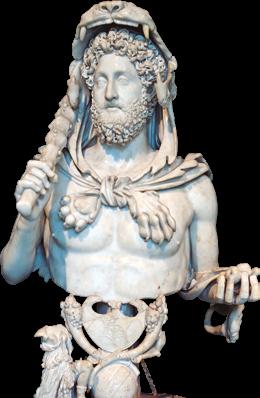
Pero no fue el único, emperadores romanos también hicieron lo propio. Es muy conocido el busto del extravagante emperador Cómodo portando la maza, la piel felina y las manzanas del Jardín de las Hespérides, no le falta el más mínimo detalle. Incluso patricios desconocidos se hacían representar así, fue una especie
93 92
OTWO 27 / OCTOBER 2021 OTWO 27 / OCTOBER 2021

is due to Trajan, absolutely identified with the figure of Hercules. Born in Italica in the bosom of a native Turdetan family, his mere geographic origin makes him have it well present, among other things because the Bay of Cadiz and the Strait of Gibraltar were very close to there. Nor can we forget that his mother was from Cadiz, the place where the most famous Temple of Hercules in the West was located, the object of pilgrimages from countless places in the known world.
Trajan also liked to appear in some sculptures disguised as the Tyrian hero or flanked by two columns, as in Baelo Claudia. It was common to see the son of Zeus on the back of his coins carrying the fearsome and characteristic Heracles mace. Together with his successor, his nephew Hadrian, he expanded the cult of Hercules to all of Rome, precisely in the years when the empire reached the greatest territorial extension of its history.
It may seem logical to assimilate a god of Olympus (with his cult, pilgrimages, temples, offerings, votive offerings and miracles) with the ruling class of the time. Kings need to invest themselves with a certain legitimacy to live at the expense of their people. What can certainly be strange is that, a thousand years later, the Herculean myth survives despite the fact that the monotheistic religions of the book won the battle - at least officially - against polytheism throughout Iberia.
It was Charles I who added to his very complicated royal coat of arms the columns of Hercules over the sea, flanking them with a ribbon that reads Plus Ultra (beyond), which has since become the official motto of Spain. Legend attributes to Hercules an inscription on the original columns in the Strait of Gibraltar that warned None (Terrae) Plus Ultra, there is no land beyond. However, by incorporating the territories conquered in America, the intention was to show the greatness and dynamism of the Spanish empire, recovering the columns and, in part, the text of the demigod.
But the culprit of the new life of Hercules for the Hispanic royal dynasties is Alfonso X of Castile, nic-
de moda de la época asociada con la virtud, sobre todo en los ámbitos público y político.
Al parecer, el culto y la devoción por el personaje en Roma se debe a Trajano, absolutamente identificado con la figura de Hércules. Nacido en Itálica en el seno de una familia nativa turdetana, su sola procedencia geográfica le hace tenerlo bien presente, entre otras cosas porque la Bahía de Cádiz y el Estrecho de Gibraltar se encontraban muy cerca de allí. Tampoco podemos olvidar que su madre era gaditana, el lugar donde se encontraba el Templo de Hércules más famoso de todo occidente, objeto de peregrinaciones desde infinidad de lugares del orbe conocido.
Trajano también gustaba aparecer en algunas esculturas travestido como el héroe tirio o flanqueado por dos columnas. como en Baelo Claudia. Era frecuente ver al hijo de Zeus en el reverso de sus monedas portando la temible y característica maza heráclea. Junto a su sucesor, su sobrino Adriano, expandió el culto a Hércules a toda Roma, justamente en los años donde el imperio alcanzó la mayor extensión territorial de su historia.
Puede parecer lógica la asimilación de un dios del Olimpo (con su culto, sus peregrinaciones, sus templos, ofrendas, exvotos y milagros) con la clase dirigente de la época. Los reyes necesitan investirse de cierta legitimidad para vivir a costa de sus pueblos. Lo que puede resultar ciertamente extraño es que, mil años después, perviva el mito hercúleo a pesar de que las religiones monoteístas del libro ganaron la batalla —al menos oficialmente— al politeísmo en toda Iberia.
Fue Carlos I quien añadió a su complicadísimo escudo real las columnas de Hércules sobre el mar, flanqueándolas con una cinta en la que puede leerse Plus Ultra (más allá), convertido desde entonces en el lema oficial de España. La leyenda atribuye a Hércules una inscripción en las columnas originarias en el Estrecho que advertía Non (Terrae) Plus Ultra, no hay tierra más allá. No obstante, al incorporar los territorios conquistados en América, se pretendía hacer constar la grandeza y el dinamismo del imperio español, recuperando las columnas y, en parte, el texto del semidiós.
Pero el culpable de la nueva vida de Hércules para las dinastías reales hispanas es Alfonso X de Cas-


94 OTWO 27 / OCTOBER 2021


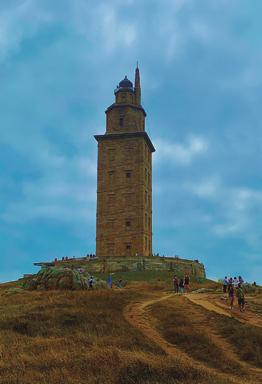

knamed the wise, who directed the work Estoria de España, the oldest written without considering the previous chronicles in Arabic and Latin. Although it is considered an improved version of the previous work (1243) De rebus Hispanas (by Archbishop Rodrigo Jiménez de Rada, the Toledan), its diffusion gave it a great subsequent influence. Well, dozens of chapters of this work are dedicated to the adventures of Hercules in the Iberian Peninsula where, supposedly, he dedicated himself to find cities and build monuments throughout its geography.
Coruña, Barcelona, Seville, Toledo, Seo de Urgell, Tarazona... are “founded” by a Hercules, to whom is attributed historical personality and not only mythical or religious. The only important city of the time that he does not find is Cadiz, and precisely because it already existed. It was there where he had to go to steal the oxen of the mythical Tartessian king Geryon, who lived in Eritea, one of the islands of the then Cadiz archipelago before they were united in the single island that we see today. Obviously, we are talking about mythology, not history. It makes no sense to go into proving absolutely any of these foundations. The latest research shows, for example, that the famous Galician Tower of Hercules was built by Roman soldiers of the X Legion in the year 4 BC, under the rule of Emperor Augustus.
And it is that, really, the geographical link with Hercules, with the Phoenician, Greek or Roman god, can only be attributed to the current province of Cadiz, where the Herakleion was located. The temple was the object of authentic worship by many of the most influential people of the time. Hannibal himself visited it before undertaking the attempted conquest of Italy. It was where Julius Caesar wept before the statue of Alexander the Great that stood there, for not having been able to emulate his glory at the age of 32. Such was its strength even with the passing of the years, that to erase the “pagan” cults that the temple continued to inspire, the Christian authorities made believe that it was visited by the apostle Santiago on his way to Galicia (although he never set foot on Iberian lands) and changed the name of the island where the sanctuary was by the name of Sancti Petri, formerly called Cotinusa, “land of wild olive trees”.
Nevertheless, if there is a moment in which the
tilla, apodado el sabio, quien dirigió la obra Estoria de España, la más antigua escrita sin considerar las crónicas anteriores en árabe y en latín. Aunque se la considera una versión mejorada de la obra anterior (1243) De rebus Hispanas (del arzobispo Rodrigo Jiménez de Rada, el Toledano), su difusión le proporcionó una gran influencia posterior. Pues bien, decenas de capítulos de esta obra están dedicados a las andanzas de Hércules por la Península Ibérica donde, supuestamente, se dedicó a fundar ciudades y construir monumentos por toda su geografía. A Coruña, Barcelona, Sevilla, Toledo, Seo de Urgell, Tarazona… son “fundadas” por un Hércules, al que se le atribuye personalidad histórica y no solamente mítica o religiosa. La única ciudad importante de la época que que no funda es Cádiz, y justamente porque ya existía. Era allí donde tenia que ir a robar los bueyes del mítico rey tarteso Gerión, que vivía en Eritea, una de las islas del entonces archipiélago gaditano antes de que se unieran en la isla única que vemos hoy. Obviamente hablamos de mitología, no de historia. No tiene sentido entrar a probar absolutamente ninguna de estos fundaciones. Las últimas investigaciones demuestran, por poner un ejemplo, que la famosa Torre de Hércules gallega fue construida por soldados romanos de la X Legión en el año 4 antes de Cristo, bajo el mandato del emperador Augusto.
Y es que, realmente, la vinculación geográfica con Hércules, con el dios fenicio, griego o romano, solo puede atribuirse a la actual provincia de Cádiz, lugar donde se situaba el Herakleion. El templo fue objeto de auténtica adoración por muchas de las personas más influyentes de la época. Lo visitó el mismísimo Aníbal antes de emprender el intento de conquista de Italia. Fue donde mismamente lloró Julio César ante la estatua de Alejandro Magno que allí había, por no haber sido capaz de emular su gloria al cumplir los 32 años de edad. Tal era su fuerza aún con el paso de los años, que para borrar los cultos «paganos» que el templo seguía inspirando, las autoridades cristianas hicieron creer que fue visitado por el apóstol Santiago en su camino a Galicia (aunque jamás pisó tierras ibéricas) e hicieron cambiar el nombre de la isla donde estaba el santuario por el nombre de Sancti Petri, antes llamada Cotinusa, «tierra de acebuches». Pero si hay un momento en que las columnas de
OTWO 27 / OCTOBER 2021 97 96 OTWO 27 / OCTOBER 2021
Pillars of Hercules reached a truly universal visibility, in the East and West, it was when the coins of Spain, especially the real de a ocho, were used as a world currency, the first of its kind. From China to Africa, including the United States, where it was known as the “pillar dollar”, the dollar of the columns or the Spanish dollar. The ubiquity of the coins, their immovable minting pattern and the purity of the silver with which they were minted (93%), coming from the plundering of the rich mines of the American colonies, made it desirable for any pocket around the world. In fact, it is said - although it is not the only theory that exists in this regard - that the original symbol of the dollar, the double barred “s”, comes from the original symbol of the columns, surrounded by the ribbon that incorporated the aforementioned motto. This seems to be demonstrated by some compositions of the columns without the lions or the aforementioned motto.
As it could not be otherwise, today Hercules is the protagonist of the heraldic symbol of Andalusia par excellence, as was established in the Assembly of Ronda in 1918 and endorsed by a state law in 1982. However, it is also reflected in the coats of arms of other cities and communities of the Spanish State and, of course, in the coat of arms of Spain. We cannot ignore that, in the process of the artificial symbolic construction of the national state, it has always appropriated the cultural, symbolic and genetic identity of the inhabitants of the southern lands and has tried to extend it to the rest of the communities and nationalities that make up the country and to the image projected of Spain abroad.
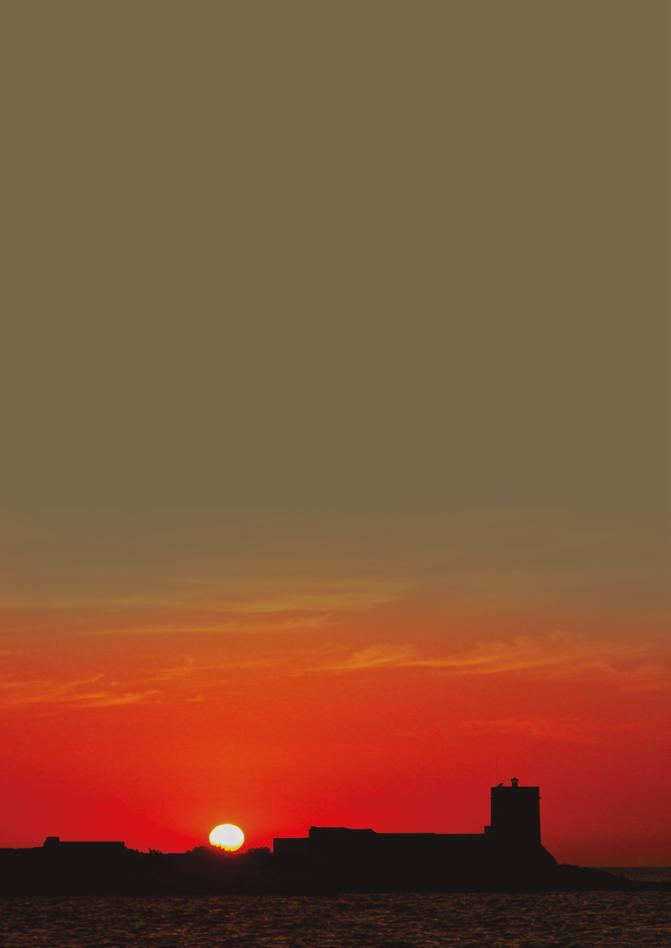
Hércules alcanzan una visibilidad realmente universal, en oriente y occidente, es cuando las monedas de España, sobre todo el real de a ocho, se usan como divisa mundial, la primera de su género. Desde China a África, pasando incluso por Estados Unidos, donde era conocido como el “pillars dolar”, el dólar de las columnas o el dólar español. La ubicuidad de las monedas, su inamovible patrón de acuñación y la pureza de la plata con la que estaban facturadas (93%), proveniente del saqueo de las ricas minas de las colonias americanas, lo hacían deseable para cualquier bolsillo en todo el mundo. De hecho, se dice —aunque no es la única teoría que existe al respecto— que el símbolo original del dólar, la «s» doblemente barrada, proviene del símbolo originario de las columnas, rodeadas con la cinta que incorporaba el mencionado lema. Así parecen demostrarlo algunas composiciones de las columnas sin los leones ni el susodicho.
Como no podía ser de otra manera, hoy Hércules es el protagonista del símbolo heráldico de Andalucía por antonomasia, como quedó establecido en la Asamblea de Ronda de 1918 y refrendado por una ley estatal en 1982. Pero también aparece reflejado en los escudos de otras ciudades y comunidades del Estado español y, por supuesto, en el de España. No podemos obviar que en el proceso de la artificiosa construcción simbólica del estado nacional, este siempre se ha apropiado de la identidad cultural, simbólica y genética de los pobladores de las tierras sureñas y las ha pretendido extender al resto de las comunidades y nacionalidades que componen el país y a la imagen que se proyecta de España en el exterior.
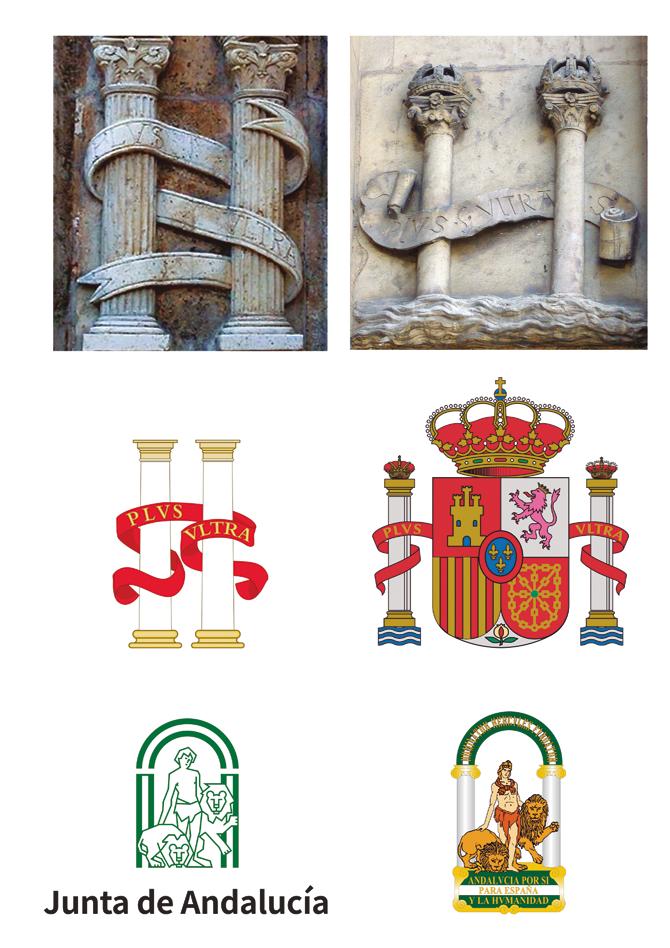
98 OTWO 27 / OCTOBER 2021

NOISE POLLUTION
AFFECTS HEARING AND MENTAL HEALTH
CONTAMINACIÓN ACÚSTICA: AFECTA A LA SALUD AUDITIVA Y MENTAL

Noise Pollution affects us in ways that we may not be conscious about. Continued exposure to noise pollution contributes to a person’s sensitivity to stress and at its extreme the impact on their mental health intensifies. Noise pollution is also related to hearing loss, so we should pay attention to the potential risks of living in a polluting city.
Research in Australia has found that deafness and hearing loss has a detrimental impact on a person’s wellbeing, feeling isolated from society and low self-esteem caused by difficulties communicating, irrespective of the level of hearing loss. It is not easy for people with hearing difficulties to communicate with others and to raise awareness of their difficulties. This inevitably results in reduced education and job opportunities as well as emotional problems.
Gibraltar has a population of 35,000 people in a land area of 6.8KM2. With over 32,500 registered vehicles, with over half of registered vehicles being cars and over a third being motorcycles.
Gibraltar is becoming a concrete jungle, with a lot of noise pollution ruining this beautiful but noisy city. Building construction everywhere and the noise
levels are atrocious. Jack hammers, big cranes moving around and big machines hammering down with great force and unbearable continuous loud noise. Traffic everywhere, aeroplanes, police ambulances and fire trucks.
Not enough green areas being built for our community. In every little space government and private firms see project development plans for housing and this has been taken as the norm.
According to recent data by the GHA 7% percent of Gibraltar’s population suffers from Deafness, with a count of approximately 2,360 people. This is above the World Health Organisations estimate of 5% globally. There are groups trying to find solutions and support. For example, GHITA (Gibraltar Hearing Issues & Tinnitus Association) is a small volunteer organisation that provides guidance and support to the community. GHITA is a pressure group towards HM Government of Gibraltar highlighting the issues involving hearing loss. Hearing loss in becoming a global issue, affecting over 5% of the global population. For further information, contact GHITA:
Web: www.ghita.gi Email: info@ghita.gi
La contaminación acústica nos afecta de formas de las que quizá no seamos conscientes. La exposición continuada a la contaminación acústica contribuye a la sensibilidad de la persona al estrés y, en su extremo, el impacto sobre su salud mental se intensifica. La contaminación acústica también está relacionada con la pérdida de audición, por lo que debemos prestar atención a los riesgos potenciales de vivir en una ciudad contaminante.
Las investigaciones realizadas en Australia han revelado que la sordera y la pérdida de audición tienen un impacto perjudicial en el bienestar de la persona, que se siente aislada de la sociedad y tiene una baja autoestima debido a las dificultades para comunicarse, independientemente del nivel de pérdida auditiva. A las personas con dificultades auditivas no les resulta fácil comunicarse con los demás y dar a conocer sus dificultades. Esto provoca inevitablemente una reducción de las oportunidades educativas y laborales, así como problemas emocionales.
Gibraltar tiene una población de 35.000 personas en una superficie de 6,8KM2. Con más de 32.500 vehículos matriculados, de los cuales más de la mitad son coches y más de un tercio motocicletas.
Gibraltar se está convirtiendo en una jungla de cemento, con mucha contaminación acústica que arruina esta hermosa pero ruidosa ciudad. Hay
construcciones por todas partes y los niveles de ruido son atroces. Martillos neumáticos, grandes grúas moviéndose de un lado a otro y grandes máquinas martilleando con gran fuerza y con un ruido insoportable y continuo. Tráfico por todas partes, aviones, ambulancias de la policía y camiones de bomberos. No se están construyendo suficientes zonas verdes para nuestra comunidad. En cada pequeño espacio el gobierno y las empresas privadas ven planes de desarrollo de proyectos para viviendas y esto se ha tomado como norma.
Según datos recientes de la GHA, el 7% de la población de Gibraltar padece sordera, con un recuento de aproximadamente 2.360 personas. Esto está por encima de la estimación de la Organización Mundial de la Salud del 5% a nivel mundial. Hay grupos que intentan encontrar soluciones y apoyo. Por ejemplo, GHITA (Gibraltar Hearing Issues & Tinnitus Association) es una pequeña organización de voluntarios que ofrece orientación y apoyo a la comunidad. GHITA es un grupo de presión ante el Gobierno de Gibraltar que destaca los problemas relacionados con la pérdida de audición. La pérdida de audición se está convirtiendo en un problema mundial, que afecta a más del 5% de la población mundial. Para más información, ponte en contacto con GHITA:
Web: www.ghita.gi Email: info@ghita.gi
101 100
OTWO 27 / OCTOBER 2021 OTWO 27 / OCTOBER 2021

Letter to the UN
30th March 2017
405 East 42nd Street
New York, NY, 10017, USA
Dear UN Secretary- General, Mr. Guterres,
I would like to congratulate you on becoming the 9th Secretary General of the United Nations. I hope that in the time you spend holding this position, significant changes will be brought up and solutions will be found to the global problems. To help you achieve this I am going to be your advisor and help you address each one of the sustainable development goals. In my opinion, global goal 13: climate change is the most important goal, and it should be tackled first.
Global warming is one of the most dangerous threats and it has caused a lot of damage that cannot be reversed, but we can try to reduce and eventually stop the drastic rise in temperature. Studies show that the amount of carbon dioxide present in the atmosphere today is higher than it was 650,000 years ago with almost all of it coming from fossil fuels being burnt. This has caused the temperatures to rise and the ice caps to melt which in turn increases sea level. Moreover, by the end of this century, the average global temperature will be 5.8 degrees hotter, 150,000 people will have died of heat related causes and there will be an increase of 7 to 23 inches in sea level. Furthermore, even plants and animals suffer from climate change, and it is projected that around 15 to 37% of all the flora and fauna species today will cease to exist.
These alarming and overwhelming statistics prove that global warming is not a hoax and immediate action must be taken to prevent these adverse effects. There are two ways in which this major issue can be solved: mitigation and adaptation. Mitigation means reducing the emissions and stabilizing the levels of greenhouse gases. Whereas adaptation involves adjusting to actual or expected future climate change. These are the only two ways to approach and solve the complex issue of climate change. Mitigation can be achieved by reductions in human emissions of greenhouse gases and increasing the capacity of carbon sinks. One of
the mitigation strategies includes diminishing fossil fuels by switching to low carbon energy sources, such as renewable and nuclear energy. One way of using renewables or nuclear energy can be to make it a legal requirement for solar panels to be installed on the roofs of buildings when they are under construction. Solar powered batteries can be used to power electric vehicles so that emissions of carbon dioxide are decreased. Solar energy is a clean and renewable source of power, and it does not release any pollutants into the atmosphere, but it also has its downsides. Solar panels cannot be used at night and the amount of sunlight that is received depends on the location, time, and the weather conditions. However, there is a solution to this problem. Solar energy can be stored and transported. Places that have abundant sunlight can store it in solar-powered batteries which can then be imported into other countries. This will maintain the economy after fossil fuels have stopped beingAnotherburnt.alternative can be the use of nuclear energy to generate electricity. Nuclear energy has emissions lower than renewables sources and it is a very sage and sustainable energy source that reduces carbon emissions. A few more alternatives include hydrogen electrolyzed from water and ethanol derived from crops. We know about substitutes for fossil fuels but research has shown that even if we stopped emitting greenhouse gases into the atmosphere, the temperatures would still take a long time to return to normal. To speed up this process, the capacity of carbon sinks must be increased. The main natural carbon sinks consist of oceans, plants and organisms that use photosynthesis to trap carbon dioxide from the atmosphere by consolidating it into biomass. A recent study suggested that coastal wetlands serve as extremely effective and efficient “blue carbon” storage reservoirs for carbon. In fact, these ecosystems can store 50-90% of carbon in soils where it can lay for thousands of years if left undisturbed. However, when these coastal wetlands are destroyed, they are turned from consequential carbon sinks to significant human- caused greenhouse gas sources. Hence, it is essential for such ecosystems to be protected and left undisturbed so that they can have an impact on climateSequestrationmitigation.is another method that can be used for climate mitigation. In this process, carbon dioxide is captured and injected into basalt. After 2 years, the carbon dioxide will change to its solid form, and it can be stored there. Sequestration can also be used to create artificial trees with resin so that carbon dioxide can be sucked out of the atmosphere. Climate change is not an issue that only affects people of a certain country or area. Climate change is an issue that affects the whole world, irrespective of the nations and their borders. Science and technology will find ways to solve this problem, but it’s the collective action taken by each citizen that will really make a difference. Mahatma Gandhi once said, “You must be the change you wish to see in the world.” This quote indicates that even the small changes that people make in their lives can contribute to the mitigation of climate change. For example, turning into a vegetarian will reduce the greenhouse gases emitted. Using public transport more often can also make a great difference. A law can be enforced for certain days on which vehicles with odd or even number plate can be used. People can also share cars and choose cycling or walking over using cars. Having cycle lanes would also be very beneficial. If technology, science, and most importantly collective action are put together, nothing can stop us from preventing this possible disaster. I hope that you, I and the entire human race can work together and take steps in order to stop the effects of climate change.

Thanking you.
Yours sincerely,
Alicia Fernandes


102
103
Carta a la ONU
30 de marzo de 2017
405 East 42nd Street
Nueva York, NY, 10017, USA


Estimado Secretario General de la ONU, Sr. Guterres, Me gustaría felicitarte por haberte convertido en el 9º Secretario General de las Naciones Unidas. Espero que en el tiempo que ocupes este cargo se produzcan cambios significativos y se encuentren soluciones a los problemas mundiales. Para ayudarte a conseguirlo, voy a ser tu asesor y ayudarte a abordar cada uno de los objetivos de desarrollo sostenible. En mi opinión, el objetivo global 13: el cambio climático, es el más importante y debe abordarse en primer lugar.
El calentamiento global es una de las amenazas más peligrosas y ha causado muchos daños que no pueden revertirse, pero podemos intentar reducir y, eventualmente, detener el drástico aumento de la temperatura.
Los estudios demuestran que la cantidad de dióxido de carbono presente en la atmósfera hoy en día es mayor que hace 650.000 años, y que casi todo proviene de la quema de combustibles fósiles. Esto ha provocado el aumento de las temperaturas y el derretimiento de los casquetes polares, lo que a su vez aumenta el nivel del mar. Además, a finales de este siglo, la temperatura media mundial será 5,8 grados más alta, 150.000 personas habrán muerto por causas relacionadas con el calor y habrá un aumento de 7 a 23 pulgadas en el nivel del mar. Además, incluso las plantas y los animales sufren el cambio climático, y se prevé que entre el 15 y el 37% de todas las especies de flora y fauna actuales dejarán de existir.
Estas alarmantes y abrumadoras estadísticas demuestran que el calentamiento global no es un engaño y que hay que tomar medidas inmediatas para evitar estos efectos adversos. Hay dos formas de resolver este gran problema: la mitigación y la adaptación. La mitigación significa reducir las emisiones y estabilizar los niveles de gases de efecto invernadero. Mientras que la adaptación implica ajustarse al cambio climático real o esperado en el futuro. Estas son las dos únicas formas de abordar y resolver el complejo problema del cambio climático. La mitigación puede lograrse reduciendo las emisiones humanas de gases de efecto invernadero y aumentando la capacidad de los sumideros de carbono. Una de las estrategias de mitigación incluye la disminución de los combustibles fósiles mediante el cambio a fuentes de energía bajas en carbono, como la energía renovable y la nuclear.
Una forma de utilizar las energías renovables o la energía nuclear puede ser establecer como requisito legal la instalación de paneles solares en los tejados de los edificios cuando estén en construcción. Las baterías alimentadas con energía solar pueden utilizarse para alimentar vehículos eléctricos, de modo que se reduzcan las emisiones de dióxido de carbono. La energía solar es una fuente de energía limpia y renovable, y no libera ningún contaminante a la atmósfera, pero también tiene sus inconvenientes. Los paneles solares no pueden utilizarse por la noche y la cantidad de luz solar que se recibe depende del lugar, la hora y las condiciones meteorológicas. Sin embargo, hay una solución a este problema. La energía solar se puede almacenar y transportar. Los lugares que tienen abundante luz solar pueden almacenarla en baterías que funcionan con energía solar y que luego pueden importarse a otros países. Esto mantendrá la economía después de que los combustibles fósiles hayan dejado de quemarse.
Otra alternativa puede ser el uso de la energía nuclear para generar electricidad. La energía nuclear tiene emisiones más bajas que las fuentes renovables y es una fuente de energía muy sabia y sostenible que reduce las emisiones de carbono. Algunas alternativas más son el hidrógeno electrolizado a partir del agua y el etanol derivado de los cultivos.
cambioquedeseasverenelmundo”.
Conocemos los sustitutos de los combustibles fósiles, pero las investigaciones han demostrado que, aunque dejáramos de emitir gases de efecto invernadero a la atmósfera, las temperaturas tardarían mucho tiempo en volver a la normalidad. Para acelerar este proceso, hay que aumentar la capacidad de los sumideros de carbono. Los principales sumideros naturales de carbono son los océanos, las plantas y los organismos que utilizan la fotosíntesis para atrapar el dióxido de carbono de la atmósfera consolidándolo en biomasa. Un estudio reciente sugiere que los humedales costeros sirven como depósitos de almacenamiento de“carbonoazul”extremadamenteeficacesyeficientesparaelcarbono.Dehecho,estosecosistemaspueden sialmacenarentreel50yel90%delcarbonoenlossuelos,dondepuedepermanecerdurantemilesdeaños sumiderosnoselesaltera.Sinembargo,cuandosedestruyenestoshumedalescosteros,pasandeserconsecuentes de carbono a importantes fuentes de gases de efecto invernadero causados por el hombre. Por tanto, es esencial que estos ecosistemas se protejan y no se alteren para que puedan tener un impacto en la mitigación del clima. El secuestro es otro método que puede utilizarse para la mitigación del clima. En este proceso, el dióxido de carbono se captura y se inyecta en el basalto. Al cabo de 2 años, el dióxido de carbono cambiará a su forma sólida y podrá almacenarse allí. El secuestro también puede utilizarse para crear árboles artificiales con resina, de modo que el dióxido de carbono pueda ser absorbido por la atmósfera. El cambio climático no es un problema que sólo afecte a los habitantes de un determinado país o zona. El cambio climático es un problema que afecta a todo el mundo, independientemente de las naciones y susfronteras.Lacienciaylatecnologíaencontraránformasderesolveresteproblema,peroeslaaccióncolectivadecadaciudadanolaquerealmentemarcaráladiferencia.MahatmaGandhidijounavez:“Debesserel
Gracias.
Atentamente,
Alicia Fernandes
Esta cita indica que incluso los pequeños cambios que la gente hace en su vida pueden contribuir a mitigar el cambio climático. Por ejemplo, convertirse en vegetariano reducirá los gases de efecto invernadero emitidos. Utilizar el transporte público más a menudo también puede suponer una gran diferencia. Se puede genteaplicarunaleyparadeterminadosdíasenlosquesepuedanutilizarvehículosconmatrículaparoimpar.La tambiénpuedecompartirloscochesyelegirlabicicletaolosdesplazamientosapieenlugardeutilizar el coche. Tener carriles para bicicletas también sería muy beneficioso. Si se unen la tecnología, la ciencia y, lo que es más importante, la acción colectiva, nada podrá impedir que se produzca este posible desastre. delEsperoquetú,yoytodalarazahumanapodamostrabajarjuntosytomarmedidasparadetenerlosefectos cambio climático.


105 104
El camino de la naturaleza
Nature’s Way
What makes for a safe and trusting neighbourhood? Parks!
¿Qué es lo que hace que un barrio sea seguro y confiable? Los parques.
For many, living in a neighbourhood and fostering relationships with those nearby helps create a sense of community. Humans are social creatures and want to engage with other members of our species. Having common areas to mingle and gather supports that sense of neighbourhood social ties.
Our study of the month was authored by nature-based research veteran, Frances Kuo, of the University of Illinois. Their research sought to understand what factors contribute to a sense of neighbourhood and social ties within. More specifically, through inner-city neighbourhoods where nature and abundant green and blue space, like that of parks, is often nonexistent.
Did nature have its way?
Kuo and their team reiterated that noisy, crowded and dangerous settings make it more difficult to trust your neighbours and form bonds. This includes barren or vacant lots that contribute to a sense of unease. In contrast, when trees and grass were added to the lot, it made the space more attractive and inviting. That lead to residents mingling and forming stronger neighbourhood social ties. The research also showed residents felt a greater sense of belonging, which has large impacts on both physical and mental health.
This is why investing in nature-based solutions in areas that are typically underfunded and overlooked can lead to the largest returns in the most human sense of the word.

Join us next month to learn how nature can reduce the number of prisoners visiting the infirmary. In the meantime, follow Science & Nature for weekly research bites and to connect with our author.
Kuo, Frances E., et al. “Fertile ground for community: Inner‐city neighborhood common spaces.” American Journal of Community Psychology 26.6 (1998): 823-851.
Para muchos, vivir en un barrio y fomentar las relaciones con las personas cercanas ayuda a crear un sentido de comunidad. Los humanos somos criaturas sociales y queremos relacionarnos con otros miembros de nuestra especie. Disponer de zonas comunes para mezclarse y reunirse favorece ese sentido de los lazos sociales del vecindario. Nuestro estudio del mes es obra de la veterana de la investigación basada en la naturaleza, Frances Kuo, de la Universidad de Illinois. Su investigación trató de comprender qué factores contribuyen al sentido de vecindad y a los lazos sociales en su interior. Más concretamente, a través de los barrios del centro de la ciudad, donde la naturaleza y los abundantes espacios verdes y azules, como los de los parques, suelen ser inexistentes.
¿Se salió la naturaleza con la suya?
Kuo y su equipo reiteraron que los entornos ruidosos, abarrotados y peligrosos dificultan la confianza en los vecinos y la creación de vínculos. Esto incluye los terrenos baldíos o vacíos, que contribuyen a la sensación de malestar. En cambio, cuando se añadieron árboles y césped al solar, el espacio se hizo más atractivo y acogedor. Eso hizo que los residentes se mezclaran y formaran vínculos sociales más fuertes en el barrio. La investigación también demostró que los residentes tenían un mayor sentimiento de pertenencia, lo que tiene un gran impacto en la salud física y mental.
Por eso, invertir en soluciones basadas en la naturaleza en zonas que suelen estar infrafinanciadas y olvidadas puede dar lugar a los mayores beneficios en el sentido más humano de la palabra.
Acompáñanos el mes que viene para saber cómo la naturaleza puede reducir el número de presos que visitan la enfermería. Mientras tanto, sigue a Ciencia y Naturaleza para ver los artículos de investigación semanales y para conectar con nuestro autor.
Kuo, Frances E., et al. «Fertile ground for community: Inner‐city neighborhood common spaces». American Journal of Community Psychology 26.6 (1998): 823-851.
107 106 ???????
OTWO 27 / OCTOBER 2021 OTWO 27 / OCTOBER 2021
Dr Owen Wiseman

Cauliflower pizza
Pizza de coliflor
DESCRIPTION
I have kept this simple but as with most of my recipes you can create any combination of food/ flavors you wish…
INGREDIENTS
1 Large cauliflower cut down the middle and sliced into 3 or 4 ( this is your pizza base).
Paprika.
Sea salt.
Pepper.
Garlic powder.
Oregano.
1/2 cup tomato frito.
1 tomato thinly sliced .
1 red pepper thinly sliced . Black pitted olives.

Grated cheese of your choice.
Olive oil to brush over.
METHOD:
Preheat oven 180.
Mix all spices together .
Brush the cauliflower base with olive oil and sprinkle with spices.
Bake for 10 min or until firmly cooked( needs to be firm not floppy).
Remove from oven and spread the tomato frito over each cauliflower slice then add the remaining ingredients decorating as you wish, finishing off with the grated cheese and a sprinkle of oregano.
Place back into the oven until cheese has melted.
DESCRIPCIÓN
He mantenido esta receta simple, pero como con la mayoría de mis recetas, puedes crear cualquier combinación de alimentos/sabores que desees…
INGREDIENTES
1 Coliflor grande cortado por la mitad y cortado en 3 o 4 partes (esta es la base de la pizza).
Pimentón. Sal marina.
Pimienta. Ajo en polvo. Orégano.
1/2 taza de tomate frito.
1 tomate en rodajas finas.
1 pimiento rojo en rodajas finas.
Aceitunas negras sin hueso.
Queso rallado de su elección. Aceite de oliva para untar.
PREPARACIÓN:
Precalentar el horno a 180. Mezclar todas las especias.
Untar la base de coliflor con aceite de oliva y espolvorear con las especias.
Hornear durante 10 minutos o hasta que esté bien cocida (tiene que estar firme, no blanda).
Sacar del horno y repartir el tomate frito sobre cada rodaja de coliflor, luego añadir el resto de ingredientes decorando al gusto, terminando con el queso rallado y una pizca de orégano.
Volver a meter en el horno hasta que el queso se haya derretido.





OTWO 27 / OCTOBER 2021 108 109 OTWO 27 / OCTOBER 2021
Guía rápida de: Suecia

Sweden
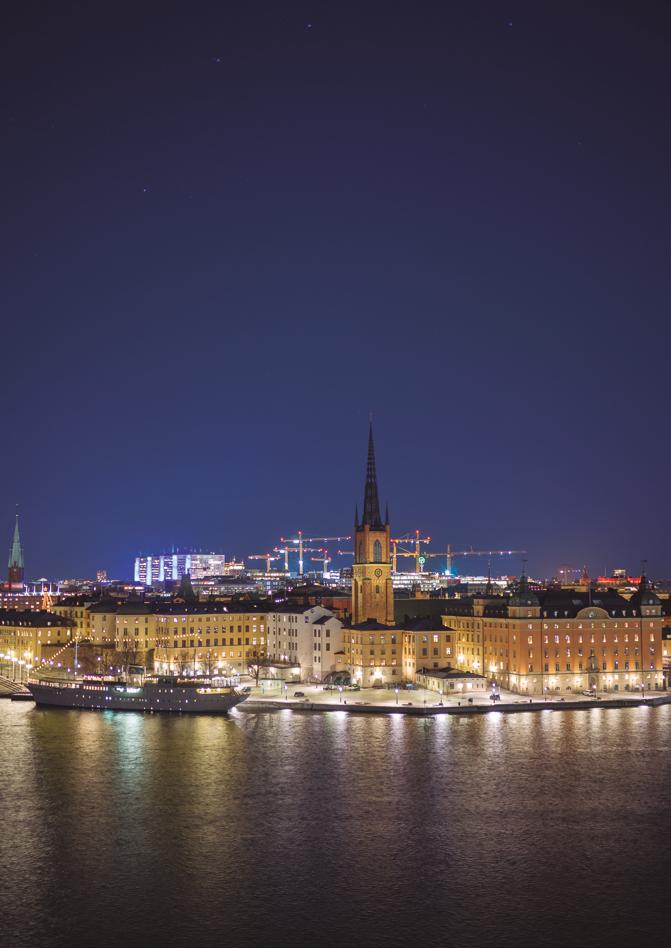
Language: Swedish.
Currency: Swedish Krona (SEK).
Capital: Stockholm.
Famous for: Design and innovation. World famous brands. Northern Lights. Some top places: Explore enchanting Stockholm, with its great food, culture and waterways. Discover the forests, mountains, lakes and beaches of Skuleskogen National Park. Visit the vibrant city of Gothenburg. Marvel at the Northern Lights or stay at the Ice Hotel in Kiruna. Enjoy the beautiful islands of Gotland and Fårö in the Baltic Sea. Take a road trip along the stunning Bohuslän coast. Hike one of the exceptional trails at Abisko National Park..
Activities: Winter sports, culture, hiking, festivals, climbing, culture, gastronomy.
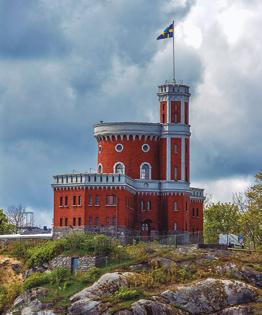
Weather:
High Season (Jun to Aug) Warm weather, busy. Shoulder (Apr – May & Sep - Oct) Cool weather, quiet at times.
Low Season (Nov - Feb) Cold weather, few tourists.
Eco fact: Sweden has the highest recycling rate in the world, recycling 99% of its waste.
Eco resorts:
Budget: Hobo Hotel from £60 per night (Stockholm).
Mid: ICEHOTEL from £100 per night (Jukkasjärvi).
Luxury: Treehotel from £400 per night (Harads).
Idioma: Sueco.
Moneda: Corona sueca (SEK).
Capital: Estocolmo.
Famoso por: Diseño e innovación. Marcas de renombre mundial. Luces del Norte. Algunos de los mejores lugares: Explora la encantadora Estocolmo, con su gran comida, cultura y vías fluviales. Descubre los bosques, montañas, lagos y playas del Parque Nacional de Skuleskogen. Visita la vibrante ciudad de Gotemburgo. Maravíllate con la aurora boreal o alójate en el Hotel de Hielo de Kiruna. Disfruta de las hermosas islas de Gotland y Fårö en el mar Báltico. Haz un viaje por carretera por la impresionante costa de Bohuslän. Recorre uno de los excepcionales senderos del Parque Nacional de Abisko.
Actividades: Deportes de invierno, cultura, senderismo, festivales, escalada, cultura, gastronomía.
Clima:
Temporada alta (junio-agosto) Tiempo cálido, con mucha afluencia.
Temporada media (abril-mayo y septiembre-octubre)
Tiempo fresco, a veces tranquilo.
Temporada baja (Nov - Feb) Tiempo frío, pocos turistas.
Hecho ecológico:
Suecia tiene la tasa de reciclaje más alta del mundo, ya que recicla el 99% de sus residuos.
Resorts ecológicos:
Económico: Hobo Hotel desde 60 libras por noche (Estocolmo).
Medio: ICEHOTEL a partir de 100 libras por noche (Jukkasjärvi).
Lujoso: Treehotel a partir de 400 libras por noche (Harads).

111 110
OTWO 27 / OCTOBER 2021 OTWO 27 / OCTOBER 2021


SAI is born
Last month we explained why we needed to be mobile and described our thinking behind the solutions we were considering.
A little camper van that could provide mobile office and temporary accommodation was the preferred choice. Rather than go down the route of buying new, we decided to recycle a van but which one to go for?
The Volkswagen Transporter range has been the most successful platform in this sector ever. No less than six generations of it since its launch in March 1950 are testament to this. All of them are now iconic shapes, but of course nothing beats the original shapes of the T1 and T2. This is a matter of personal taste, but all are good looking vehicles and all retain that magic associated with successful designs – they define quality and purpose. They deliver the statement, the declaration of purpose, that we were looking for.
There are many desirable versions of camper vans in the market from almost all major manufacturers, but few can argue that this range is the one that does it for us in Europe. It invites you to be free, to dare to simply follow your dream, in short to do something for yourself and create your own space and action. Nothing could be better for us in OTWO. But which to choose? Well market availability would determine the choices available. T1 and T2 are the iconic symbols and highly prized and sought after. When working to a budget they are not the best choice with loads of demand for them.
We decided to play the long game. Simply sit tight and allow the right vehicle to come to us rather than force the decision on time and availabilities. Like that, having agreed to commit to the project,
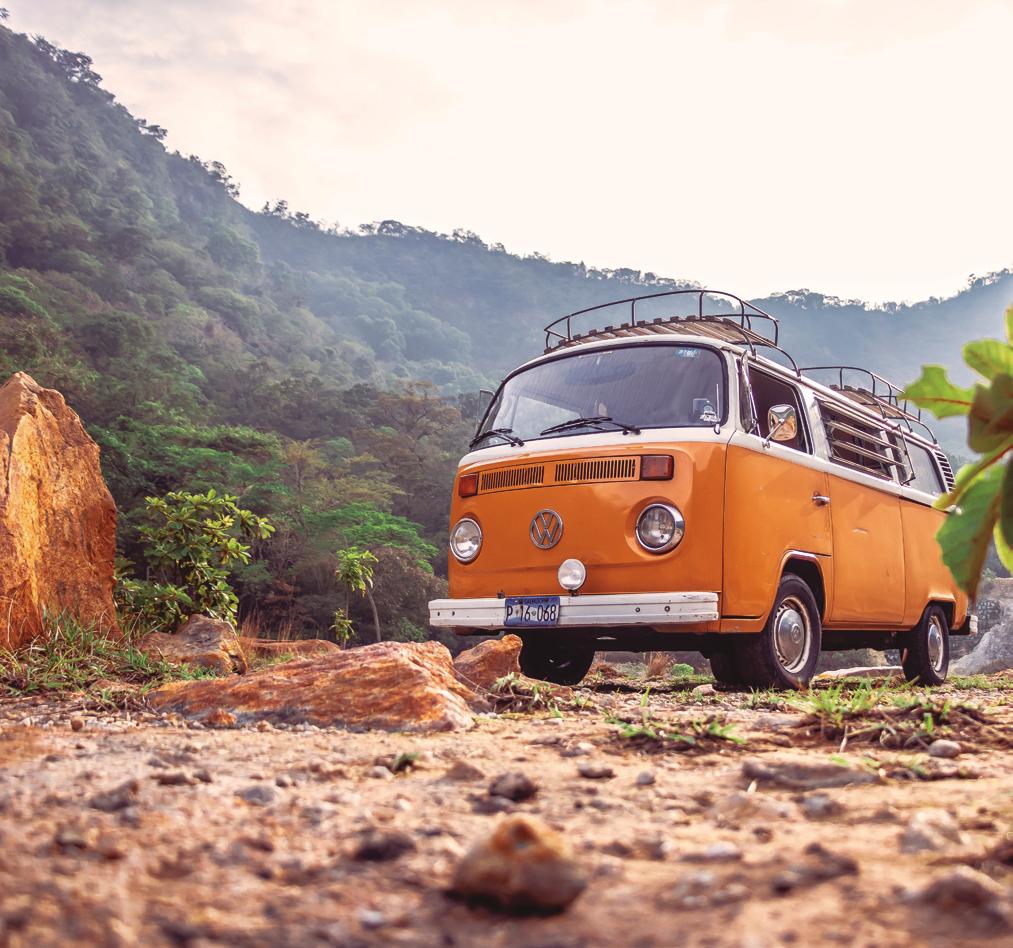
we simply tried very hard to curb our eagerness and waited in the window displays of social media and other established media for the sale of used items.
Suddenly, we spotted an offer of a T4 Transporter that drew us in. We juggled our usually busy schedules and made time to view. It was in the end a very easy decision.
G84609 started life in Gibraltar back in October 1996. Yes he will be 25 years old on the 18th October. As soon as we met, I knew he would be the one to join us in this adventure.
In the conversation with the previous owner, it became clear that his spell had also fallen on her though she was not able to carry on with the project.
So much so that she had even decided to name him Sai after Shirbi Sai Baba an Indian guru and philanthropist who had a simple eight word slogan to summaries his teachings; “Love all, serve all; help ever, hurt never”. We both agreed, our adventure was born in the deal and it was called Sai. Sai has had a busy life, no less than six previous owners. Common to all of them has been an unusual level of care and attention. He just glows with love and care. The condition of the vehicle is a testament to all those that have enjoyed it before us, he is handsome and fit as a fiddle.
Of course, we now start the process of converting this people transporter into a mobile asset to deliver to all the OTWO message. I am excited beyond my dreams. We all feel that the decision is right, we know it is going to be amazing, we know it is going to be right.
We just don’t know how we are going to do it!! This we shall share with you in the months that follow..
113 112
OTWO 27 / OCTOBER 2021 OTWO 27 / OCTOBER 2021
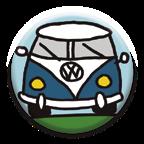
El mes pasado explicamos por qué necesitábamos ser móviles y describimos las soluciones que estábamos considerando.
La opción preferida era una pequeña furgoneta que pudiera servir de oficina móvil y de alojamiento temporal. En lugar de comprar una nueva, decidimos reciclar una furgoneta, pero ¿cuál elegir?
La gama Volkswagen Transporter ha sido la plataforma de mayor éxito en este sector. Nada menos que seis generaciones desde su lanzamiento en marzo de 1950 dan fe de ello. Todas ellas son ahora formas icónicas, pero, por supuesto, nada supera las formas originales de la T1 y la T2. Se trata de una cuestión de gusto personal, pero todos son vehículos de buen aspecto y todos conservan esa magia asociada a los diseños de éxito: definen la calidad y el propósito. Ofrecen la afirmación, la declaración de intenciones, que buscábamos.
Hay muchas versiones deseables de furgonetas camper en el mercado de casi todos los principales fabricantes, pero pocos pueden discutir que esta gama es la que lo hace para nosotros en Europa. Te invita a ser libre, a atreverte a seguir simplemente tu sueño, en definitiva, a hacer algo por ti mismo y crear tu propio espacio y acción. Nada mejor para nosotros en OTWO.
¿Pero qué elegir? Bueno, la disponibilidad del mercado determinaría las opciones disponibles. La T1 y la T2 son los símbolos icónicos y muy apreciados y buscados. Cuando se trabaja con un presupuesto, no son la mejor opción con mucha demanda para ellos.
Decidimos jugar a largo plazo. Simplemente sentarnos y dejar que el vehículo adecuado llegara a nosotros en lugar de forzar la decisión en función del tiempo y las disponibilidades.
Así, tras haber acordado comprometernos con el proyecto, simplemente nos esforzamos por frenar
nuestro afán y esperamos en los escaparates de las redes sociales y otros medios establecidos para la venta de artículos usados.
De repente, vimos una oferta de un T4 Transporter que nos atrajo. Hicimos malabarismos con nuestras agendas, normalmente muy ocupadas, y sacamos tiempo para verlo. Al final fue una decisión muy fácil.
El G84609 comenzó su vida en Gibraltar en octubre de 1996. Sí, el 18 de octubre cumplirá 25 años.
En cuanto nos conocimos, supe que sería el indicado para acompañarnos en esta aventura.
En la conversación con la anterior propietaria, quedó claro que su hechizo también había caído sobre ella, aunque no era capaz de seguir con el proyecto.
Tanto es así que incluso había decidido ponerle el nombre de Sai en honor a Shirbi Sai Baba, un gurú y filántropo indio que tenía un sencillo lema de ocho palabras para resumir sus enseñanzas: “Ama a todos, sirve a todos; ayuda siempre, no hagas daño nunca”. Ambos estuvimos de acuerdo, nuestra aventura nació en el trato y se llamó Sai.
Sai ha tenido una vida ajetreada, nada menos que seis propietarios anteriores. Todos ellos han tenido en común un nivel inusual de cuidado y atención. Simplemente brilla con amor y cuidado. El estado del vehículo es un testimonio de todos los que lo han disfrutado antes que nosotros, es guapo y está en plena forma.
Por supuesto, ahora comenzamos el proceso de convertir este transportador de personas en un activo móvil para entregar a todos el mensaje de la OTWO. Estoy emocionado más allá de mis sueños. Todos sentimos que la decisión es correcta, sabemos que va a ser increíble, sabemos que va a ser correcto.
¡Sólo que no sabemos cómo lo vamos a hacer! Esto lo compartiremos con ustedes en los meses siguientes.
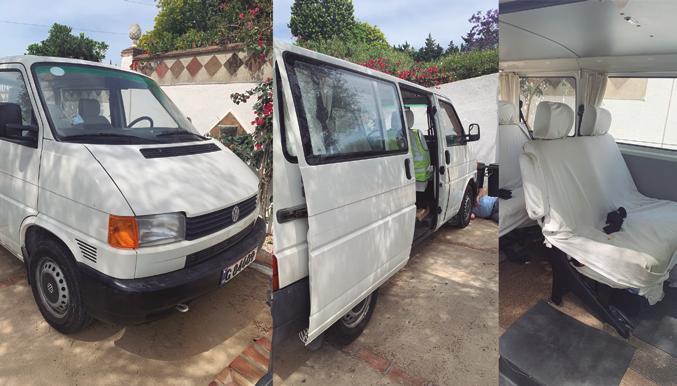
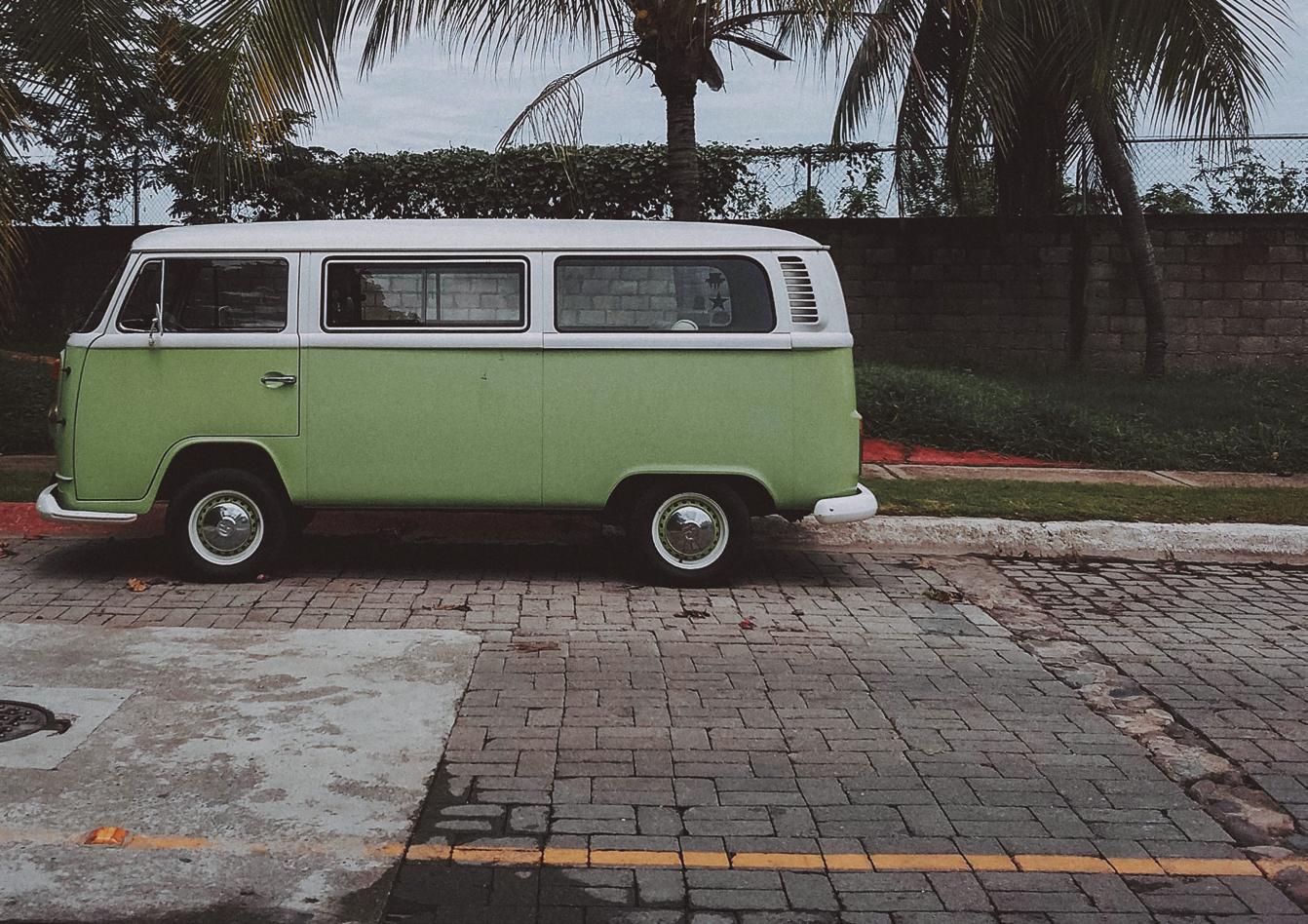
115 114
OTWO 27 / OCTOBER 2021 OTWO 27 / OCTOBER 2021
Nace SAI


Toilet Roll, Kitchen Roll, Facial Tissue, Pocket Tissue, Baby Wipes, Anti-Bacterial Handy Wipes, Anti-Bacterial Surface Wipes, Make-Up Cleansing Wipes, Straws, Shaker Straws,



The Cheeky Panda® is an example of the innovative disruptor concept – taking the world’s fastest growing plant Bamboo and turning it into tissue. They provide a truly sustainable alternative to one of the biggest environmental concerns of the present-day deforestation. The company is built on our passion for environmental and social responsibility, their products are a catalyst for change and they are a deliverer of truly innovative products that are making the world a better place.



Transport available for groups.Check with us for your requirements. OTWO is a facilitator on these packages. All activities are contracted directly between the respective centre operator and the client.
Prices are for the month of October only, please contact us for other dates.
Transporte disponible para grupos. Consultenos si estás interesado. OTWO es un mediador de estos paquetes. Todas las actividades se contratan directamente entre el operador y
Precios válidos solo para el mes de octubre, consulte para otras fechas.
Plastic Free • Carbon Footprint • Vegan & Cruelty Free Why Bamboo • Kind to Skin FOR MORE INFORMATION CLICK ON EACH SECTION
PRODUCT RANGE
Baby Nappies. www.bamboopanda.gi Shop via our new website now live! Discounted Products, Monthly Subscription Services and more! The Future is Cheeky
117 Catálogo de Experiencias OTOÑO 21 Organized by: OTWO Magazine Tel. +00350 22500799 info@otwomag.com
cliente.
el
AUTUMN CATALOG 21 OTWO 27 / OCTOBER 2021
In2Adventures Stand Up Paddle Lessons
In2Adventures Clases de remo de pie (SUP)
We are a Gibraltar based adventure and activity company established in 2013. We promote the importance of a healthy lifestyle through fun-based activities tailored to our clients needs.
Our aim is to respectfully promote the amazing natural features of our environment. We work with a number of local charities and believe in the community. We encourage people to explore Gibraltar and enjoy the outdoors through our activities. Our Core values are based on combining adventure, the outdoors, education and fun.
Gibraltar has a fantastic caring community and at the core of In2adventures culture is an aim to help strengthen our Community. We work closely with charities to raise money for worthy causes and provide a platform for educating and inspiring young people.
“SUP” Lesson
Join us for a beginners SUP session to learn the basics from kneeling and to finally stand up paddle boarding. Once you have completed this session, you are able to join on other more advanced SUP adventures such as the Sunset and the SUP safari around the stunning southerly coastline of Gibraltar. This session is for people who are keen to develop paddling skills, learn the correct techniques and keep safe on the water.
SUP Certificate included for completing the lesson.
2 HOURS
INCLUDES: Board, Paddle & instructor.
MAY WE RECOMMEND:Buoyancy Aid £5 per guest per hour. Wet suit £5 per guest per hour.
£35 PER PERSON

Somos una empresa de aventura y actividades con sede en Gibraltar establecida en 2013. Promovemos la importancia de un estilo de vida saludable a través de actividades basadas en la diversión y adaptadas a las necesidades de nuestros clientes. Nuestro objetivo es promover respetuosamente las increíbles características naturales de nuestro entorno. Trabajamos con varias organizaciones benéficas locales y creemos en la comunidad. Animamos a la gente a explorar Gibraltar y a disfrutar del aire libre a través de nuestras actividades. Nuestros valores fundamentales se basan en la combinación de la aventura, el aire libre, la educación y la diversión. Gibraltar cuenta con una fantástica comunidad solidaria y en el centro de la cultura de In2adventures está el objetivo de ayudar a fortalecer nuestra Comunidad. Trabajamos estrechamente con organizaciones benéficas para recaudar fondos para causas dignas y proporcionamos una plataforma para educar e inspirar a los jóvenes.
Clases de “SUP”
Acompáñanos en nuestras clases de SUP para principiantes, para aprender los fundamentos desde el arrodillamiento hasta el stand up paddle boarding. Una vez que hayas completado esta sesión, podrás unirte a otras aventuras de SUP más avanzadas, como la puesta de sol y el safari de SUP alrededor de la impresionante costa del sur de Gibraltar. Esta sesión es para personas que quieren desarrollar sus habilidades de remo, aprender las técnicas correctas y mantenerse seguras en el agua. Certificado SUP incluido por completar la clase.
2 HORAS
INCLUYE: Tabla, remo e instructor.
PODEMOS RECOMENDAR: Chaleco salvavidas 5 libras por persona y hora. Traje de neopreno £5 por huésped por hora.
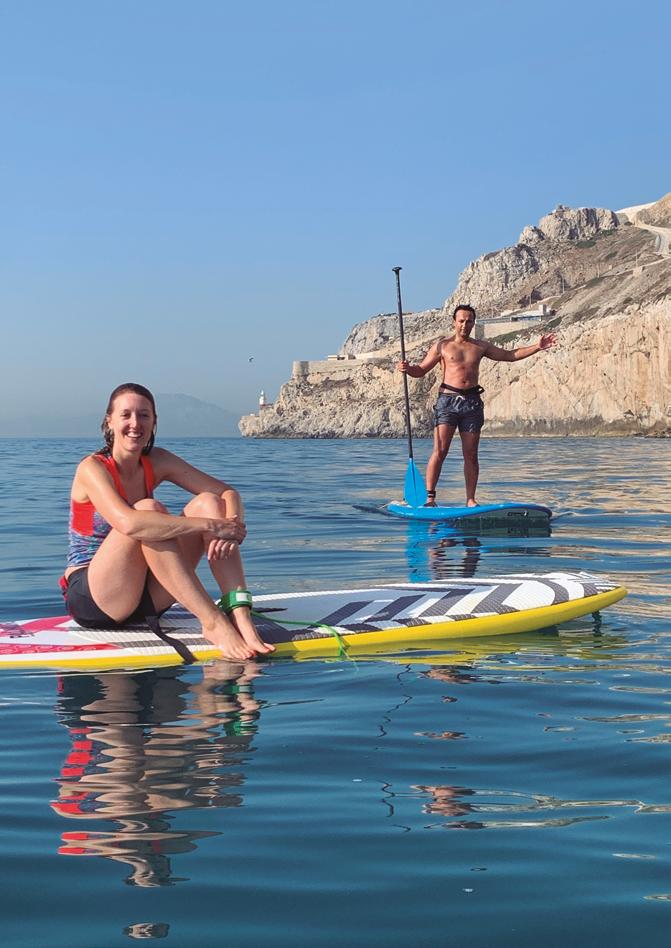
Jimmy Gracia
Jimmy is an outdoors man and is qualified as an instructor in many adventure activities. A keen mountaineer and also a qualified paddle sport coach, his teaching technique is first class. Following a full successful career in the military he developed his outdoor instructor skills and trained in the outdoor industry in Cornwall. He has been on numerous expeditions around the world including high altitude mountaineering in the Himalayas and paddle boarding across the Straights of Gibraltar.
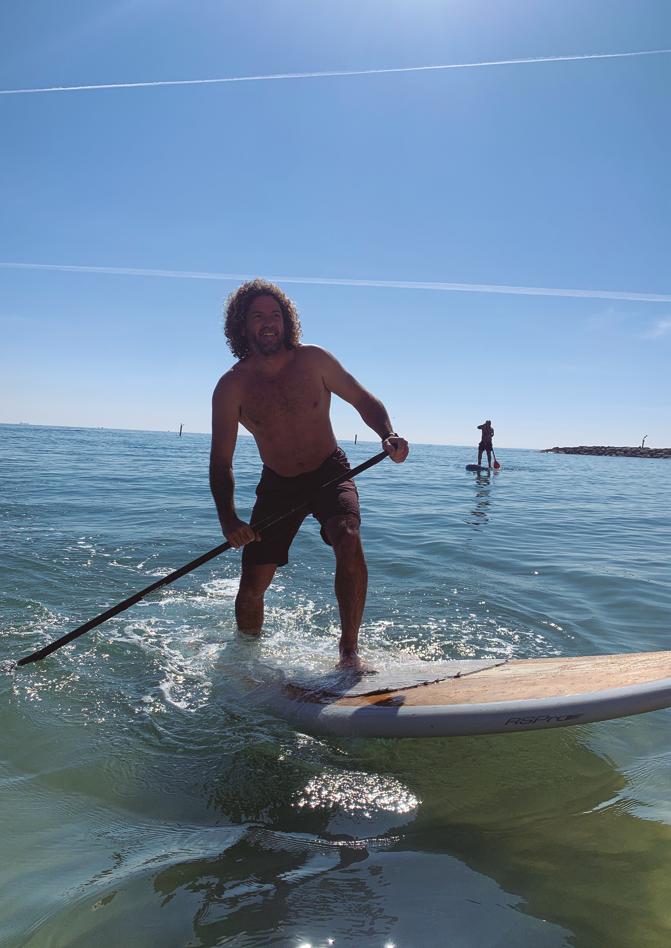
Jimmy Gracia
Jimmy es un hombre del aire libre y está cualificado como instructor en muchas actividades de aventura. Es un montañero entusiasta y también un entrenador cualificado de deportes de remo, su técnica de enseñanza es de primera clase. Tras una exitosa carrera en el ejército, desarrolló sus habilidades como instructor de actividades al aire libre y se formó en la industria de las actividades al aire libre en Cornualles. Ha participado en numerosas expediciones por todo el mundo, incluyendo montañismo de gran altitud en el Himalaya y paddle boarding a través del Estrecho de Gibraltar.
119 118
35 LIBRAS POR PERSONA OTWO 27 / OCTOBER 2021 OTWO 27 / OCTOBER 2021
EBikes Group Tours

EBIKES GROUP TOURS
Gibraltar
Enjoy breath taking views across 3 countries and 2 continents, explore Gibraltar’s fascinating history and be introduced to our most famous inhabitants, the Barbary macaques – the only free roaming monkeys in Europe!
Price: £69 per person.
Highlights
Europa Point and Lighthouse. Upper Rock Nature Reserve.
Pillars of Hercules Monument.
Windsor Suspension Bridge. O’Hara’s Battery (top of Rock 424m). Skywalk.
Ape’s Den.
Great Siege Tunnels.
Moorish Castle. …And many more.
What’s included?
Premium e-bike by Riese&Müller. Cycle helmet.
Safety instructions.
Entrance fee into the Nature Reserve. An official tour guide. Bottled water.
DURATION:
3 hours. Suitable for everyone over 155 cm, over 12 years old and capable of riding a bicycle.
GROUP TOURS
Gibraltar
Disfrute de las impresionantes vistas de 3 países y 2 continentes, explore la fascinante historia de Gibraltar y conozca a nuestros habitantes más famosos, los macacos de Berbería, ¡los únicos monos que se desplazan libremente en Europa!
Precio: £69 por persona.
Puntos destacados
Punta de Europa y el Faro
Reserva Natural Upper Rock (Parte superior del peñon)
Monumento de las Columnas de Hércules
Puente colgante de Windsor
Bateria de O’Hara (parte superior del peñon - 424m).
El Skywalk
Guarida de los monos
Gran túneles de asedio
Castillo Arabé. …y muchos más
¿Qué está incluido?
Alta calidad E-bike de Riese&Müller. Casco de bicicleta
Instrucciónes de seguridad
Entrada a la reserva natural Guía oficial Agua embotellada.
DURACIÓN:
3 horas. Adecuadas para todos los que midan más de 155 cm, tengan más de 12 años de edad y puedan montar en bicicleta.
Organized by: OTWO Magazine
Tel. +00350 22500799
info@otwomag.com
Transport available for groups.Check with us for your requirements.
OTWO is a facilitator on these packages. All activities are contracted directly between the respective centre operator and the client.
Organized by: OTWO Magazine
Tel. +00350 22500799
info@otwomag.com
Transporte disponible para grupos.
Consultenos si estás interesado.
OTWO es un mediador de estos paquetes. Todas las actividades se contratan directamente entre el operador y el cliente.
121 120
Gibraltar
OTWO 27 / OCTOBER 2021 OTWO 27 / OCTOBER 2021


8 George’s Lane, Gibraltar / info@spiritoftherock.gi / +350 540 67487 / www.spiritoftherock.gi
